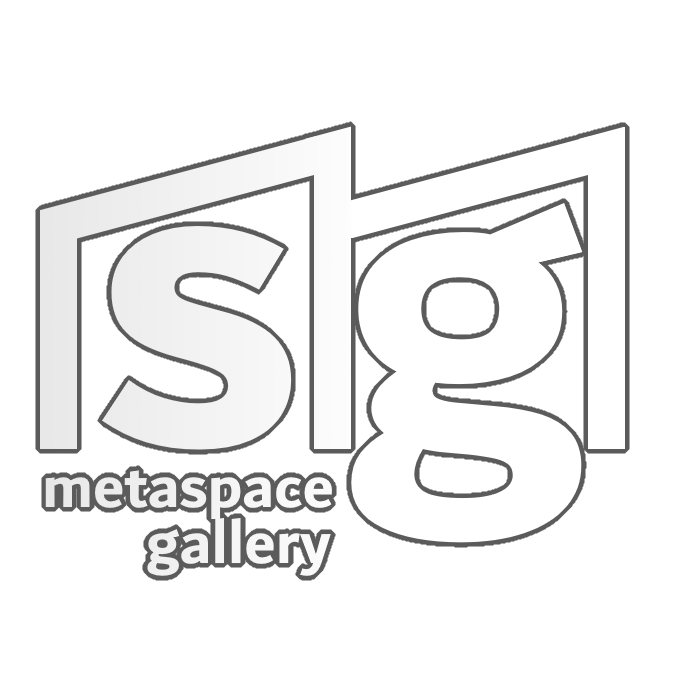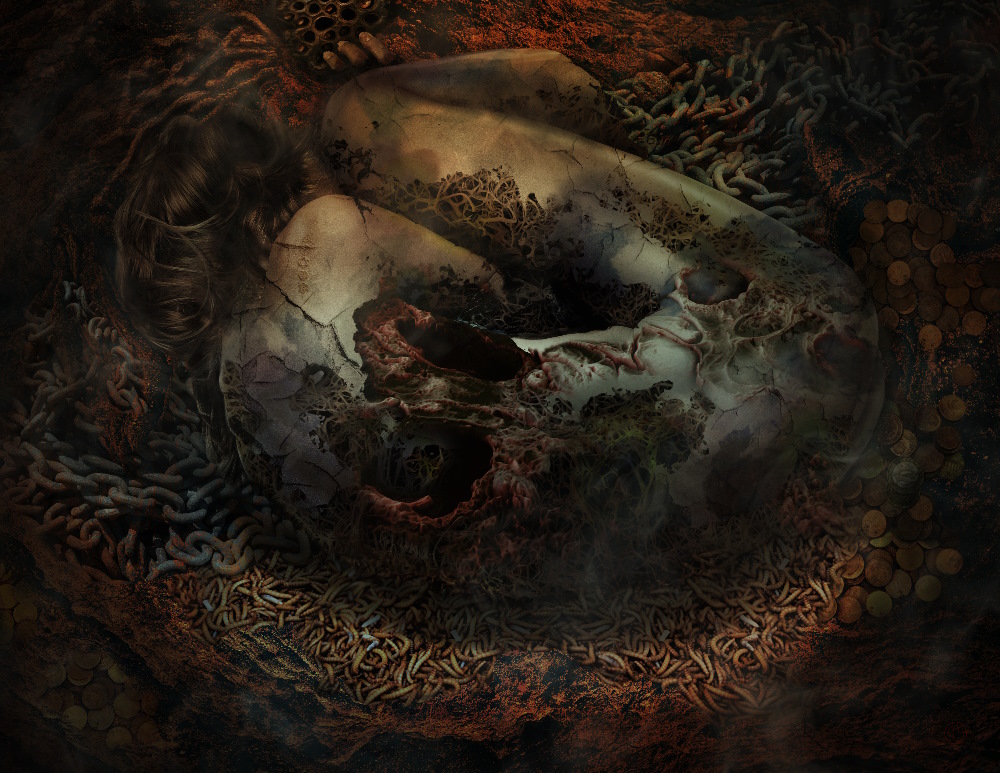
SUPER
CONTEMPORARY
@
META SPACE GALLERY
ARTISTS:
RICHARD HELEY
ADAM STRANGE
RONALD GONZALEZ
DAWN BEEDELL
EGLI PETTA
PHILIP R WESTCOTT
GORAN TOMIC
DAVID IAN BICKLEY
CHLOE HUGHES
REINHARD RIEDEL
HAZEL E HUTCHISON
FATMA DURMUSH
LUCY FENNELL
NOLAN FLYNN
NIKOL PINTOVÁ
GERALDINE LEAHY
MICHAEL WAGNER
JULIA UTOPLENNIKOVA
EVE BARTLETT
GORDON MASSMAN
BUZZAWE
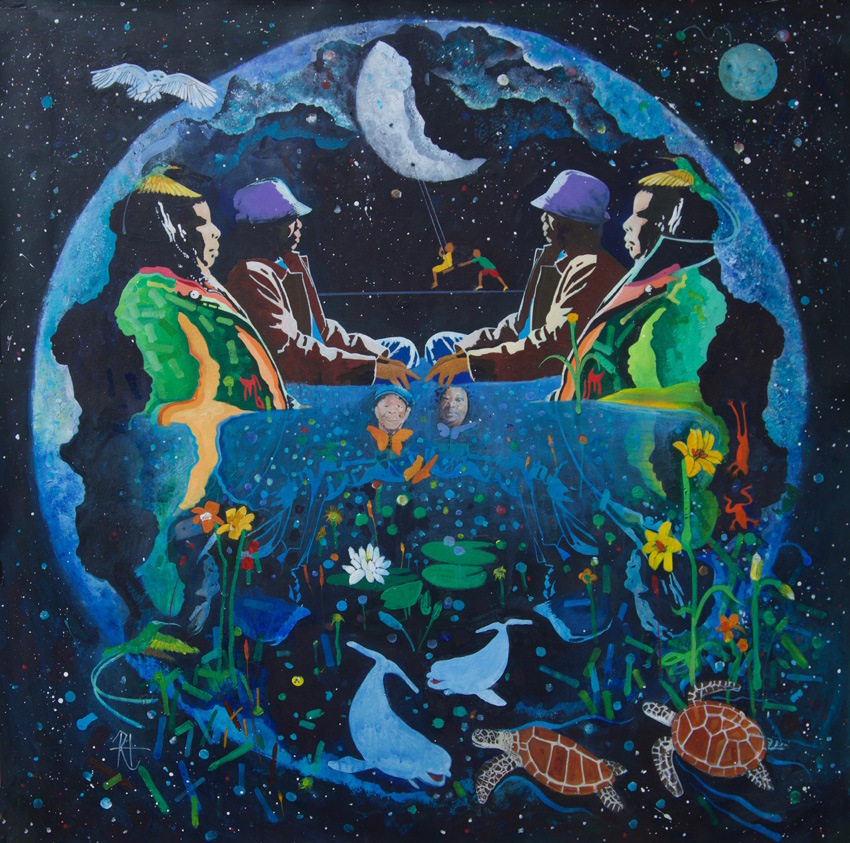
ABOUT THE EXHIBITION
Contemporary: “belonging to or occurring in the present” with “super” to bring it closer to our time within this decade (or the last ten years). Supercontemporary is an virtual/online exhibition mixed with a publication to celebrate the works of living artists creating within our time.
If you would like to easily navigate this exhibition please press on the artists names in the above section to go to their part of the exhibition.
7 FEB – 21 FEB 2025
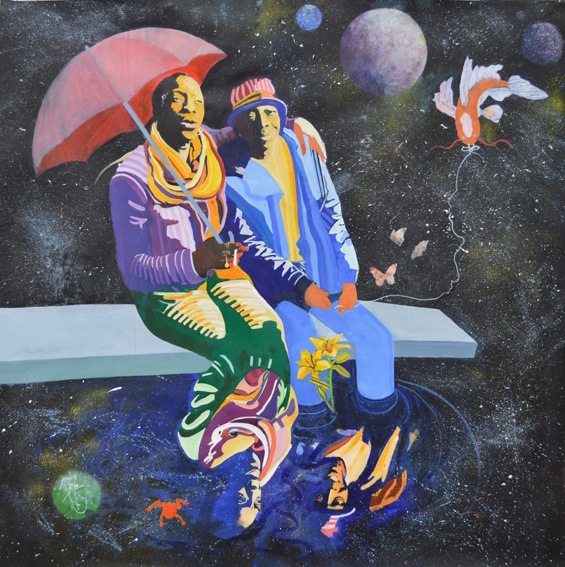
RICHARD HELEY
I bring the colours of Australia where I spent my teenage and college years, the wild psychedelia of the 60’s and 70’s, the delight in painting interactively with children, the spiritual expansion of an internationally performing poetry slam champion, the sheer energy of painting “live” in nightclubs at 142 beats a minute and a lifetime’s practice of letting it all fall out of me onto canvas or paper. I hope that my paintings confirm that the path of least resistance to manifesting your desires is happiness.
Artworks

When the Night (2023)
Acrylic on Canvas
One of a series of graphic fantasy portraits of people local to the Maida Hill area of central London

Space (2023)
Acrylic on Canvas
One of a series of graphic fantasy portraits of people local to the Maida Hill area of central London
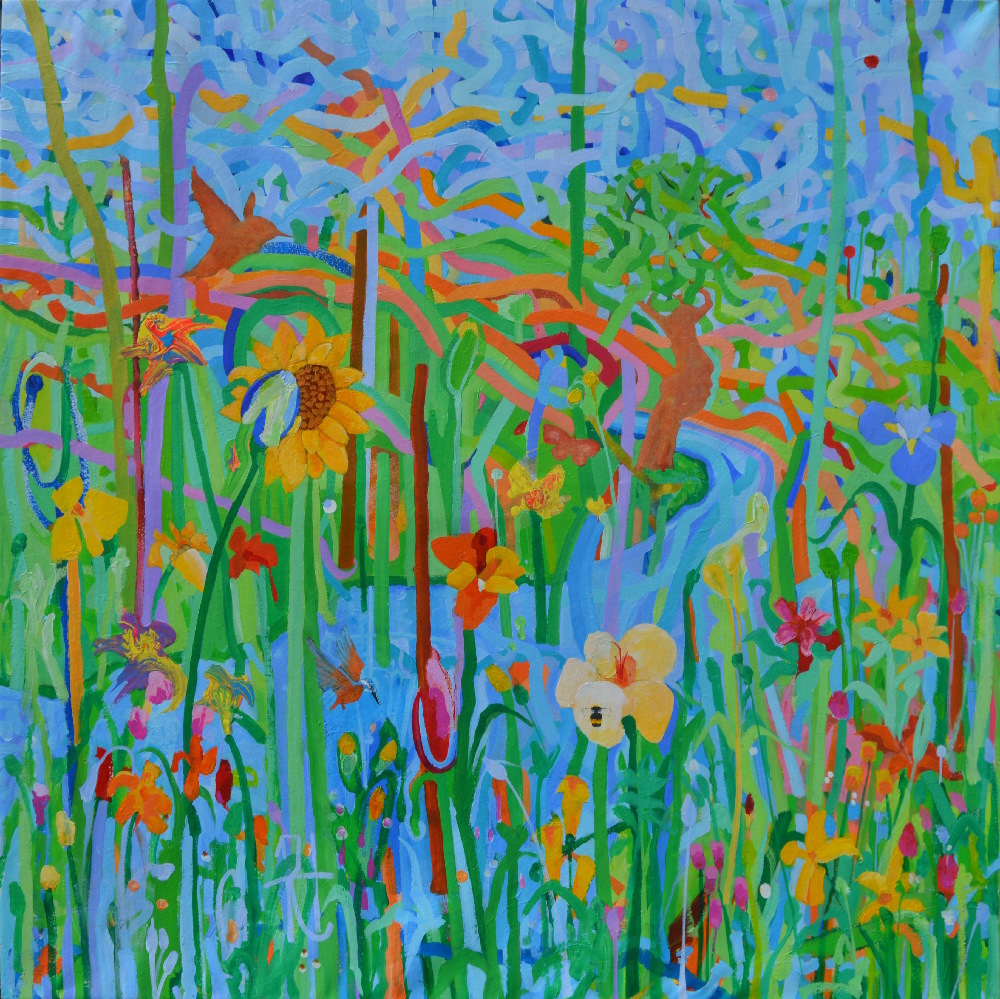
Gratitude (2024)
Acrylic on Canvas
Happiness is the path of least resistance to manifesting your desires. Gratitude is the practice.
Curatorial Review
When The Night (2023) is a artwork which merges portraiture and the community of Maida Hill together. The composition of the work is centred inside space with a sphere (which most likely represents a hollowed out moon) along with a crescent moon. From this we can understand that the artwork thus gives a dream vibe as it takes place within the night.
The work has symmetry, which guides the viewer towards the centre of the composition. This brings us to the crescent moon, where there is a figure on a swing and a figure behind them pushing them. The figures within the work are painted in a bold and contrasting way, which gives them prominence in the work. Below the figures, it goes underwater with whales, turtles, and aquatic vegetation…
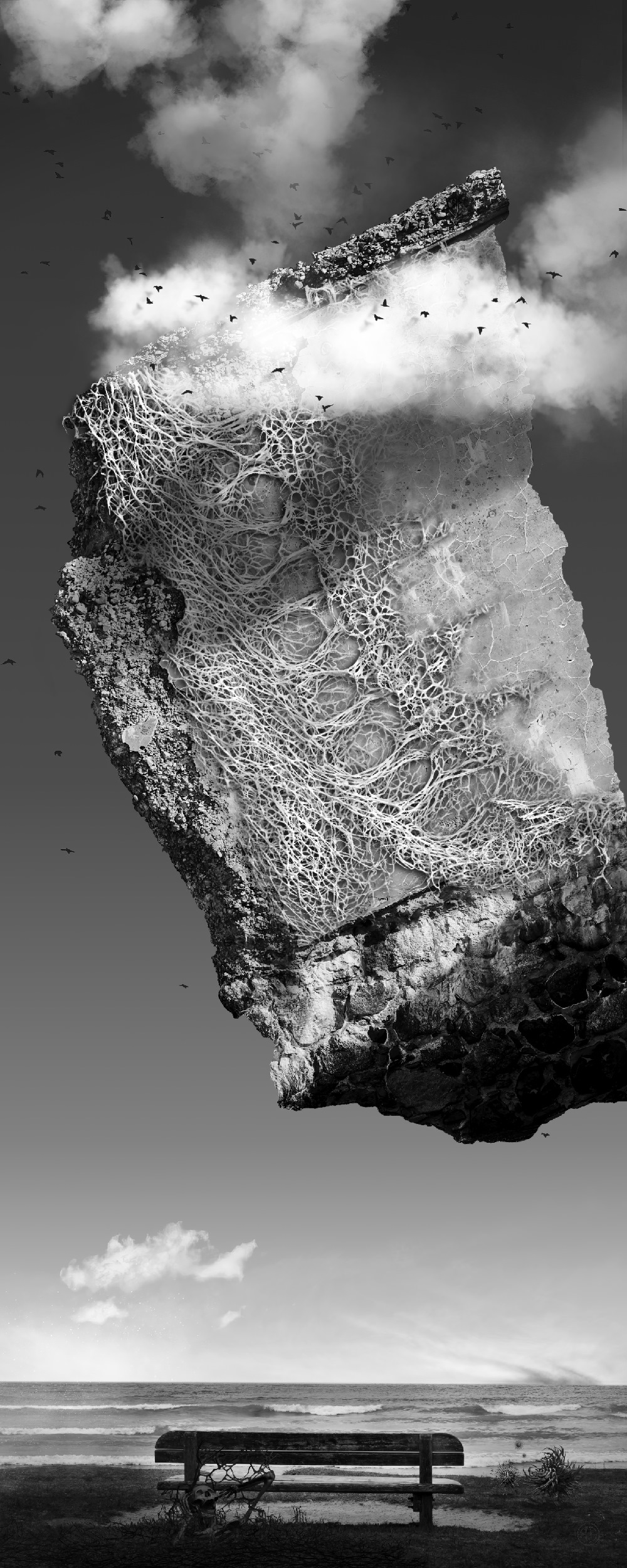
ADAM STRANGE
Adam Strange is a Canadian artist whose work will shock and delight you! Adam’s artistic influence is the Dada/Surrealist spirit and it’s methods. Adam works with computer software and montage at the intersection between twentieth century approaches to analogue painting, collage and film, with twenty-first century digital tools and resources to create contemporary artefacts. Adam’s method includes recontextualizing found photographs and digital assets, sutured with the juxtaposition of internal realities, chance and accident, to reveal global expressions and sensibilities. Adam creates his art for your pleasure or desolation, seeking the essentia, reflecting the under-current, offering respite from the illogics of the outside world, all to tickle your fancy in the disturbed. These are images of realism. By turns, demanding, fearful, and disorienting. They are fit representations of the times we live in.
Artworks

Memorial Bench (2024)
Photo Montage
A memorial to an extinct species.

The Last Supper (2024)
Photo Montage
The last supper of Capitalism.
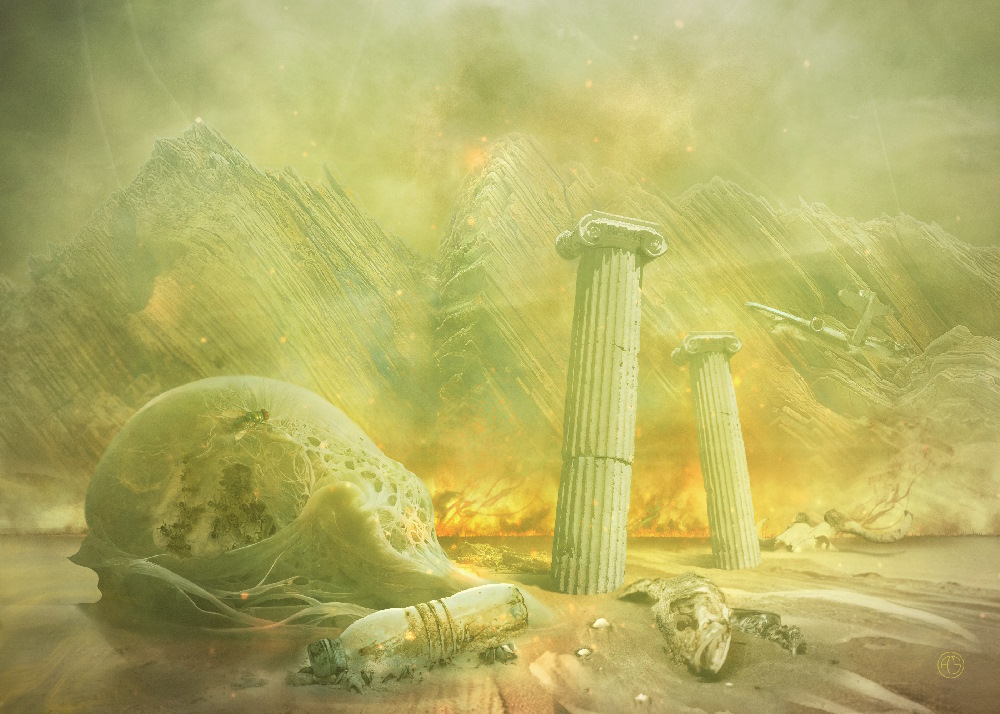
Sold Down the River (2024)
Photo Montage
Living with the lies of the oil and gas industry.
Curatorial Review
Memorial Bench (2024) is a photo montage in which a bench sits at the bottom of the work with a floating giant rock with what looks to be a fossil above the bench. The environment in which these two objects sit looks desolate yet quite peaceful at the same time. The background seems to have an ocean, while the bench looks as though it is slightly weathered. From this, we could see that the bench could be a memory of the past as it seems damaged.
Going further into the mystery of the bench, there are skeletal remains tangled within the soil next to it, which could imply that the memorial bench is a memorial to humanity. The ocean is mostly calm, with occasional waves, along with mostly clear skies. Pairing these elements together gives the scene an eerie and existential sentiment.
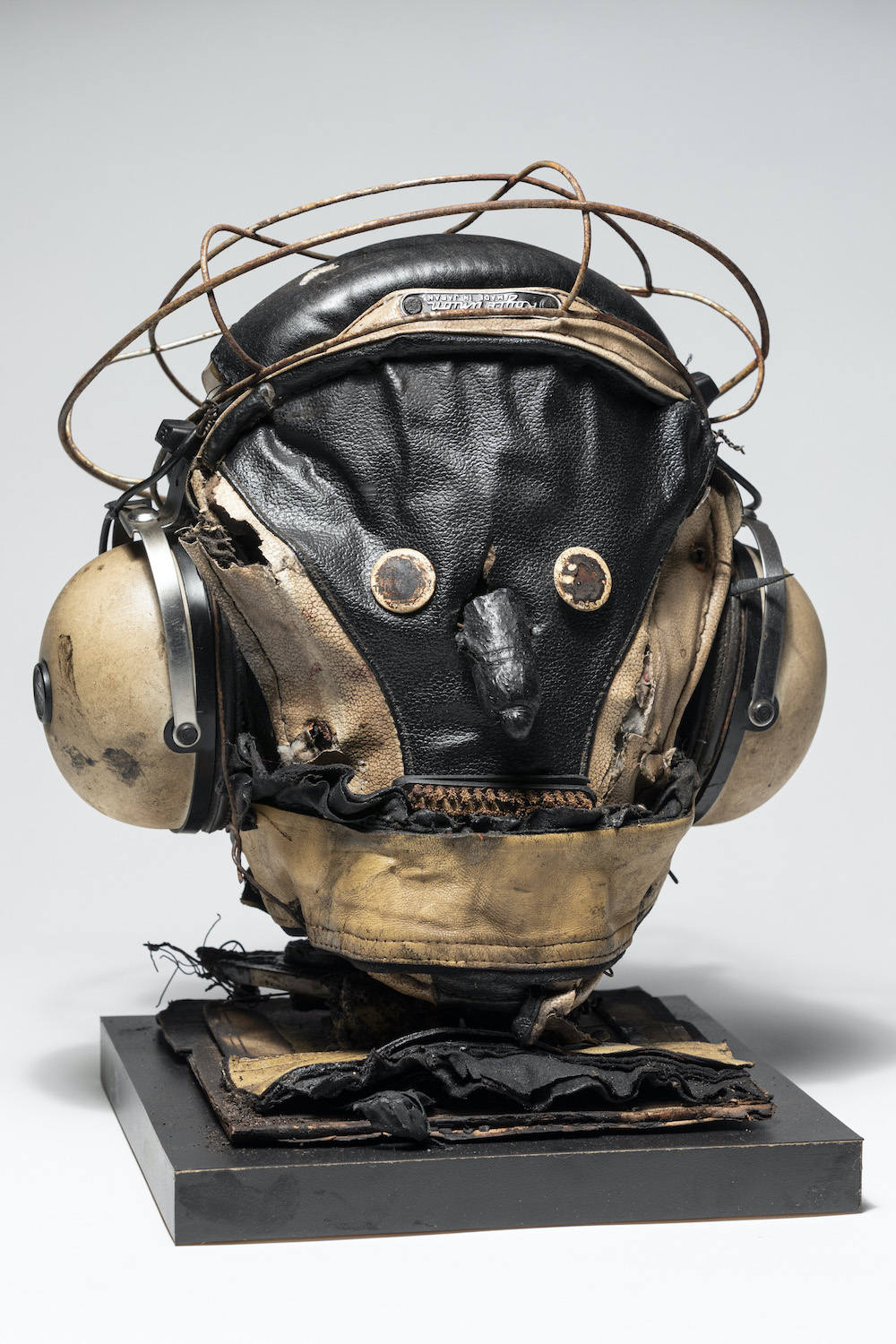
RONALD GONZALEZ
The magic of objects lives in me through memory and imagination. The aesthetics of finding brings the tangible and poetic together in recognition of the tragic vulnerable thing, the crude material given shape that speaks of life and the art of relation to objects. My work is an expression of a found reality where disparate parts exist in a domain populated by the use to be things from yesterday’s decay transformed by time and mortality. Things and humans live in a parallel space between birth and destruction. The found object being replete in its forms is a survivor and remnant cast out among us serves as a metaphor of an inevitable end. I am drawn to a sculptural vocabulary that communicates through the energies of growth and dissolution animated by intuition and chance. It is a quest for innumerable creations that emerge between the boundaries of life and death, using what I find to form a world devoted to things that describe their beauty and fate.
Artworks

Head #1 (2023)
found objects, detritus over steel
Head Assemblage
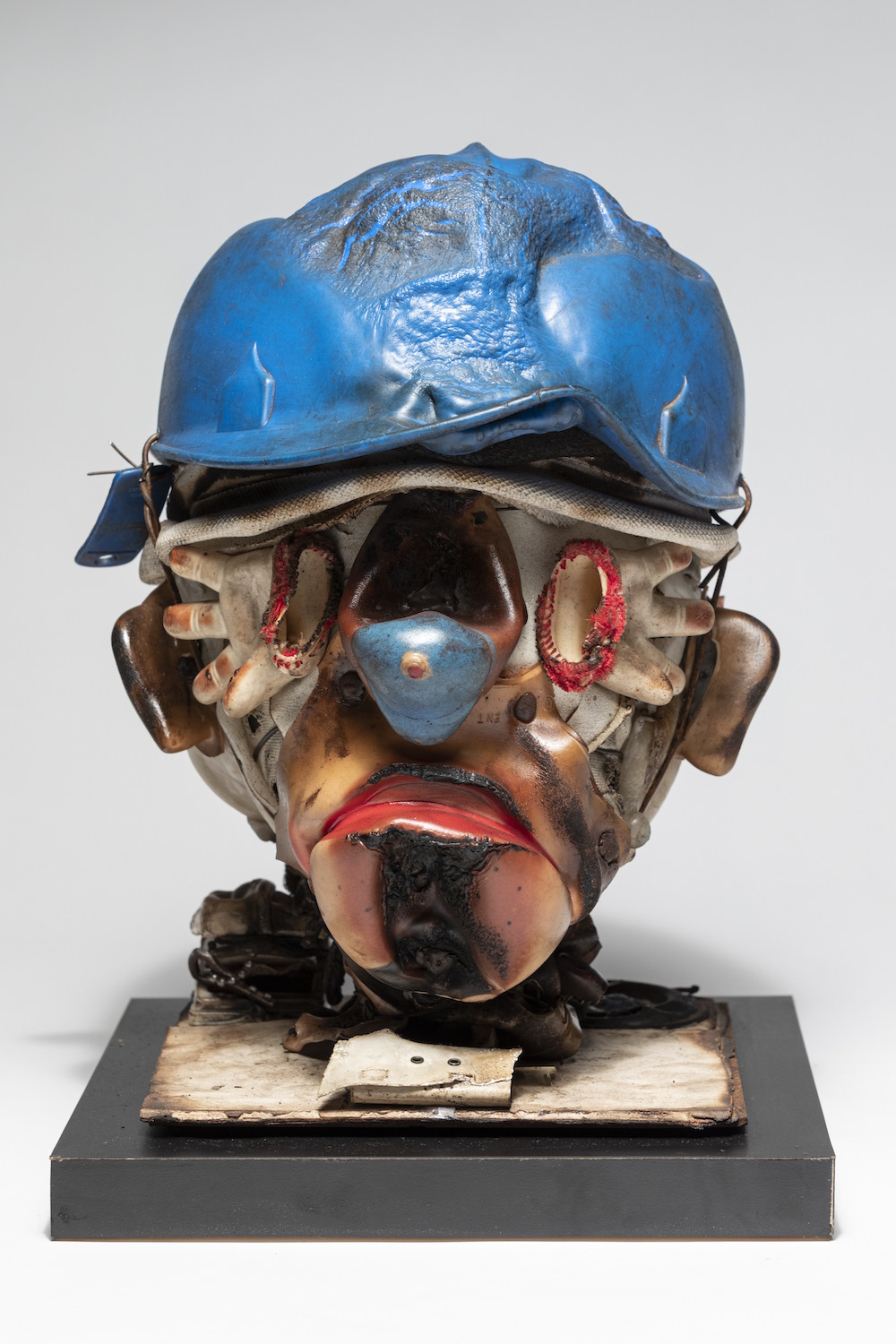
Head #2 (2023)
found objects, detritus over steel
Head Assemblage
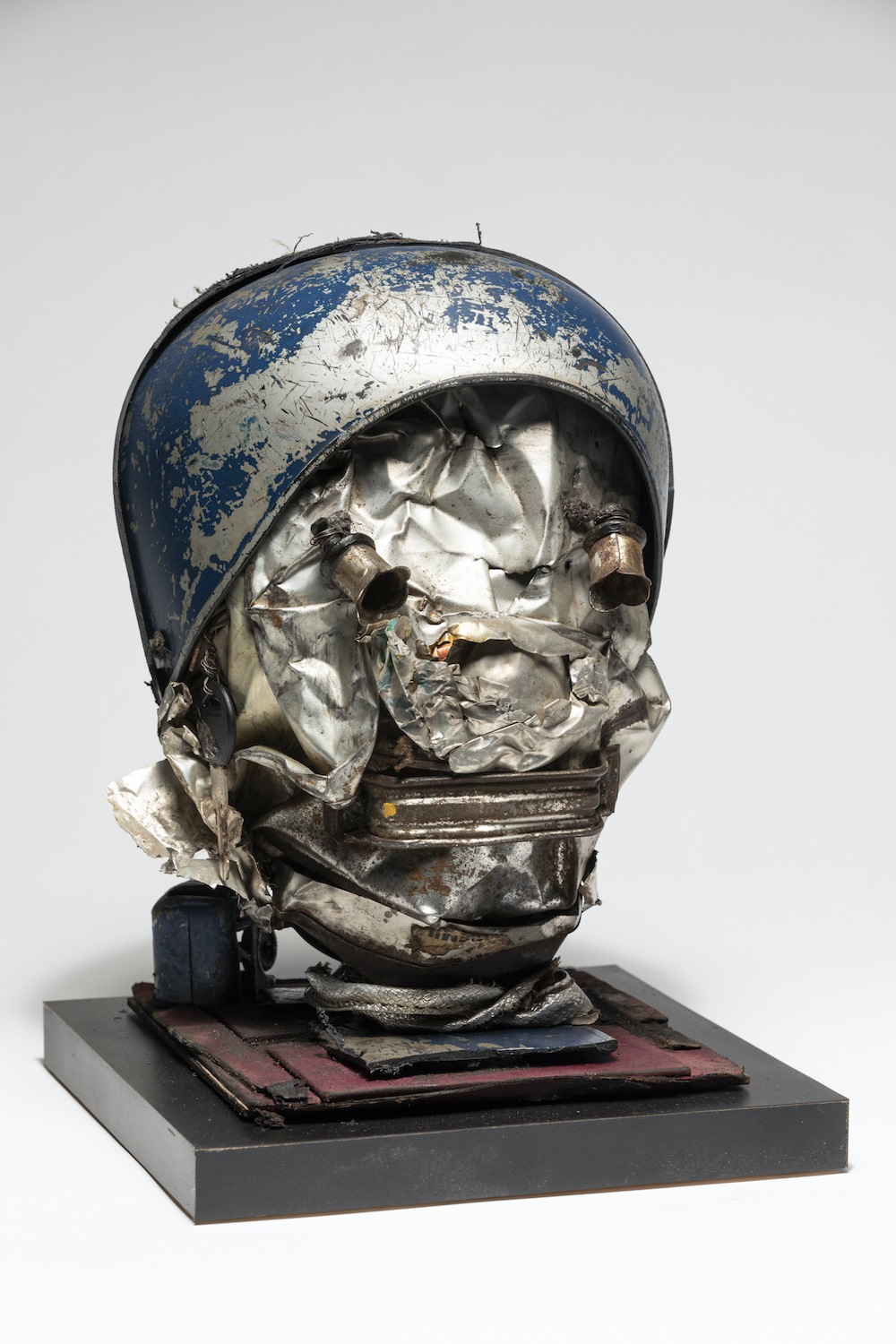
Head #3 (2023)
found objects, detritus over steel
Head Assemblage
Curatorial Review
Head #1 (2023) turns leather, fabric, and steel into a head. Fabric and leather (though leather is less so) are quite fragile and could represent the human self. However, another interpretation could be that leather, a by-product of cow skin, is an aged and dead flesh on the head. The industrial materials, for example, the earmuffs and the metallic wires that encircle the head- of which these objects seem aged turn the head into an object of disuse or its inevitable abandonment.
The leather seems to have been manipulated to add wrinkles to the head, while the hollowed eyes allow the viewer to see the history of the materials that make the head. There seems to be some form of burn marks on the material, which suggests erosion, which may show that the head has been made despite the damage, implying survival….
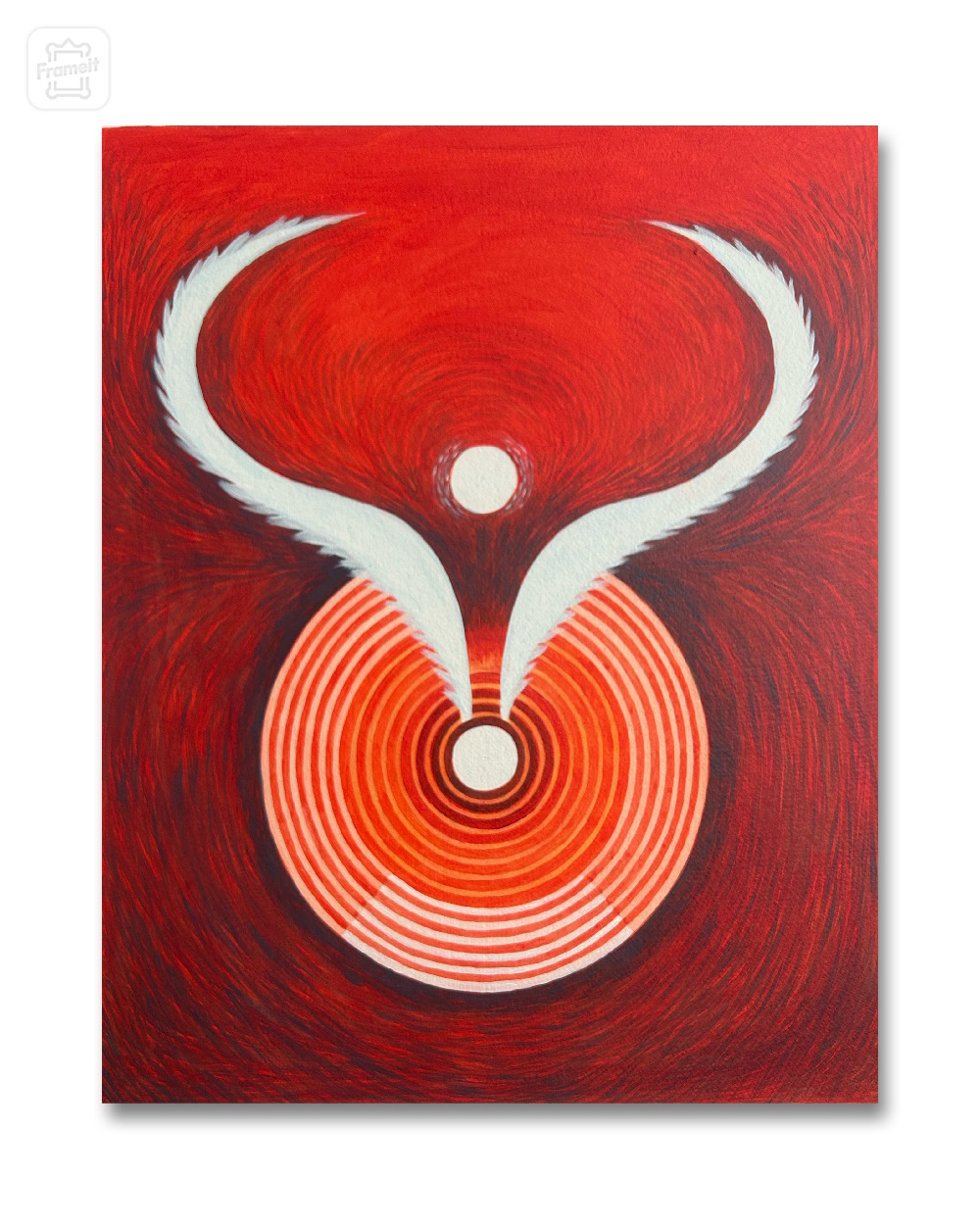
DAWN BEEDELL
As an Energy Artist, I am deeply influenced by a strong connection to nature and my daily meditation practice. My creative process is quite unique. I connect with the energy of the world around me, both seen and unseen, to create visual representations of that energy.
My paintings are a celebration of the incredible power of nature and the energy that flows through everything in our universe. I love exploring this invisible world of energy, frequency, and vibration that gives everything its unique life force. Through my art I strive to give visual form to the energy that permeates everything around us, but my art is more than that, it is intended to empower, enlighten and inspire others and is perfect for meditation, healing practices and creating focus and transformation. I believe that the energy held within the final artwork is a powerful tool for healing and can be transferred to the viewer, indeed this is my ultimate goal and motivation in creating my paintings.
Artworks
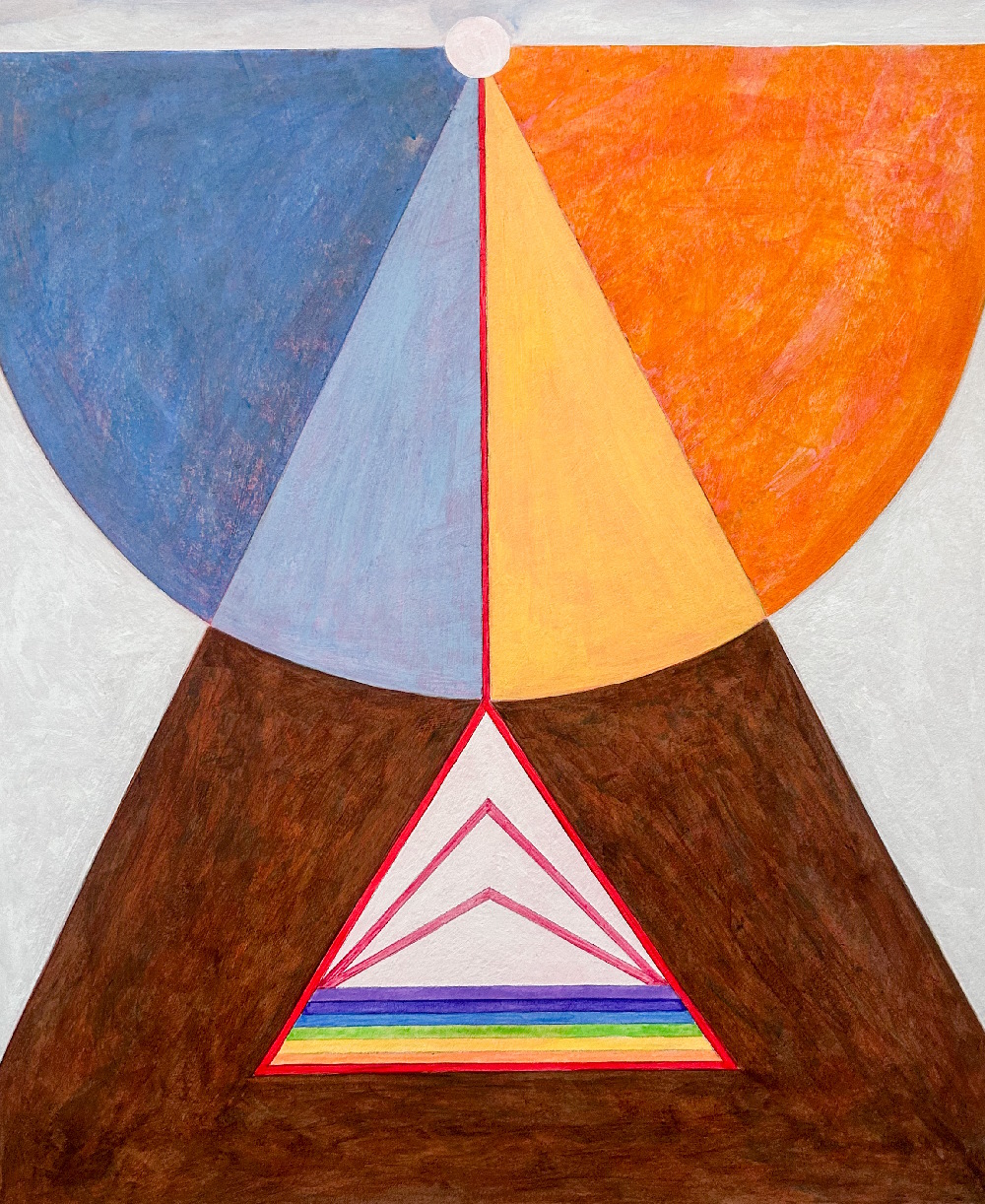
Angel of Protection (2024)
Acrylic
The Angel of Protection is a protector and defender when we are in need of strength, truth and power.

Angel of Ecstasy (2024)
Acrylic
The Angel of Ecstasy embodies heightened feelings of bliss. Expansive, euphoric, reminding us of our beating pulse and aliveness.
Curatorial Review
Angel of Protection (2024) is an acrylic painting which shows remarkable usage of geometry and colour theory. The painting is centred on a vertical axis divided into two connected hemispheres and a triangle. The top half of the painting contrasts with blue and orange, which brings together the calmness and warmth of the orange and the peace of the blue. These colours have thus been converted into energy and are the target of the viewer’s gaze as the viewer is guided to these two colours through the triangle…
Interview
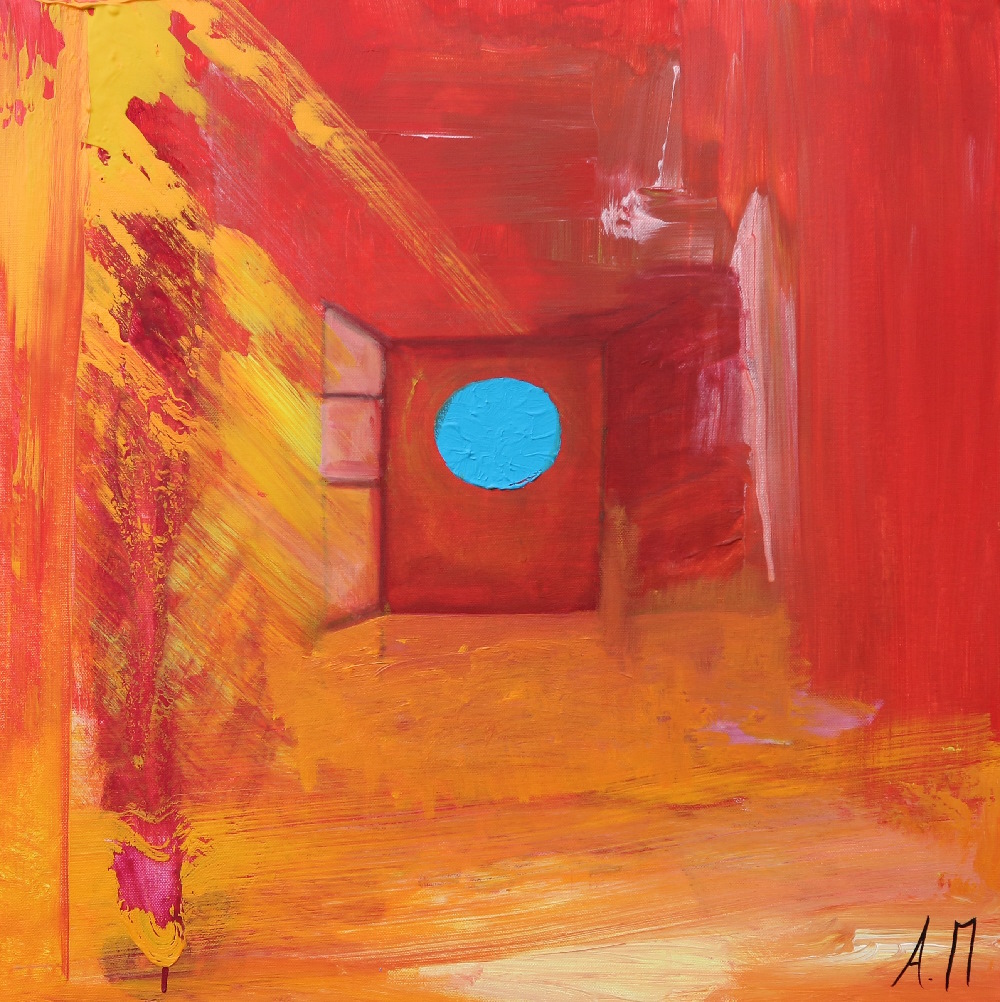
EGLI PETTA
Egli Petta was born in Athens-Greece, her childhood was spent with a rich influence of the aesthetics and heritage within her family environment. In 2000 she moved in United Kingdom where she qualified in Fine Art and Museology. Since then she has travelled the world and participate in different exhibitions. Now she is based in London.
Egli’s art aims to evoke curiosity and raise questions about time and space as historical references, while simultaneously exploring contemporary art within the context of her research. As a visual artist uses mixed media and collage techniques within her paintings. Throughout her research, photography and sketching are important on the process of exploring multiple themes.
Artworks
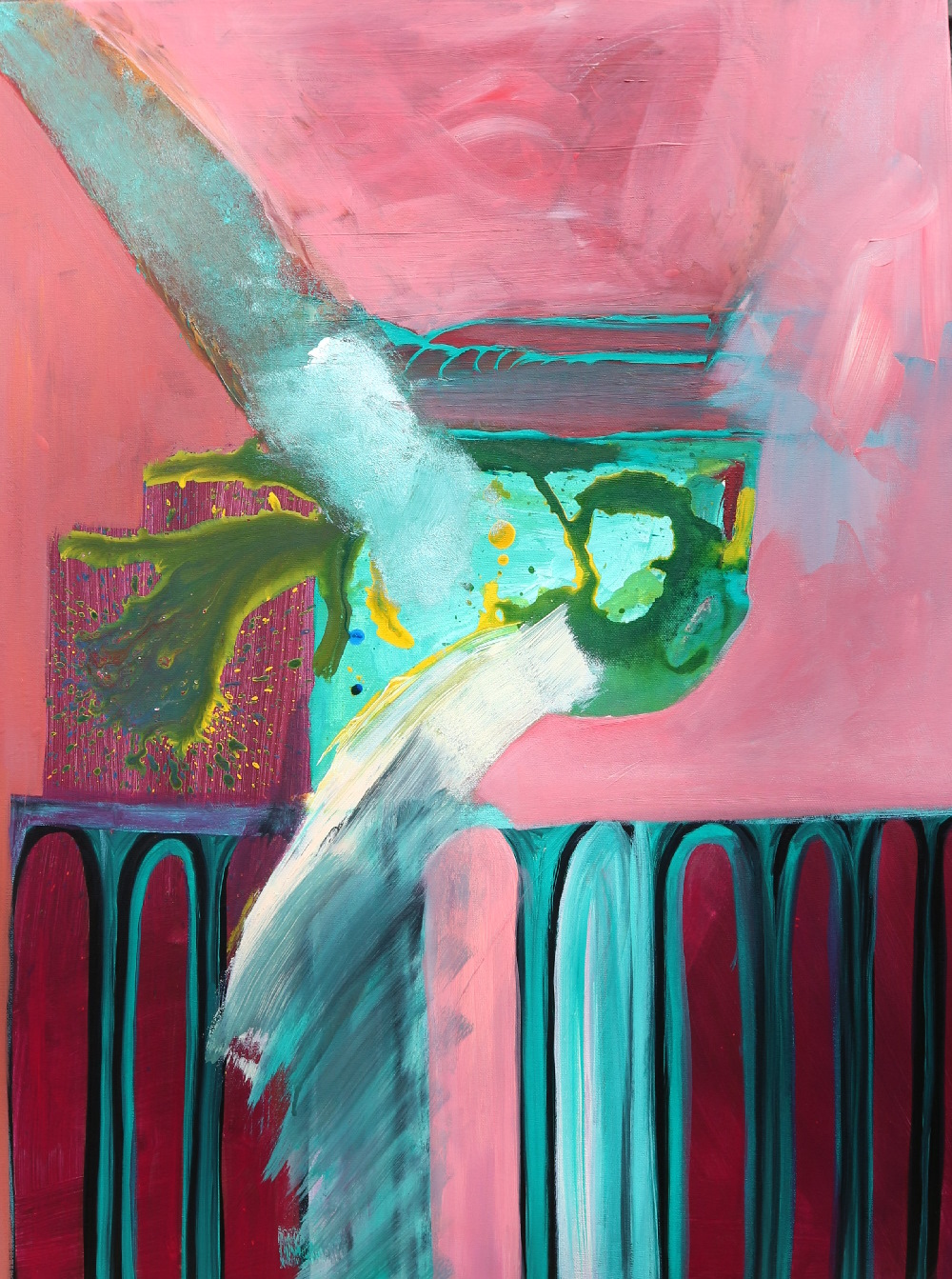
Utopia (2024)
Acrylic and Ink on Canvas
”Utopia” comes from the most recent solo exhibition project which called ‘Dreamland Chronicles’.

Empire of Light (2024)
Acrylic on Canvas
‘Empire of Light’ also comes from the most recent solo exhibition project which called ‘Dreamland Chronicles’.
Curatorial Review
Utopia (2024) is an acrylic and ink painting on canvas produced by Petta’s solo exhibition project, Dreamland Chronicles. From the title of the work and the exhibition project’s title, we can understand that the work explores the idea of a utopia in the context of a dream. The painting uses highly saturated colours and seems extremely fluid as there is disunity in where everything has been placed, which helps to give a very dreamy feel….
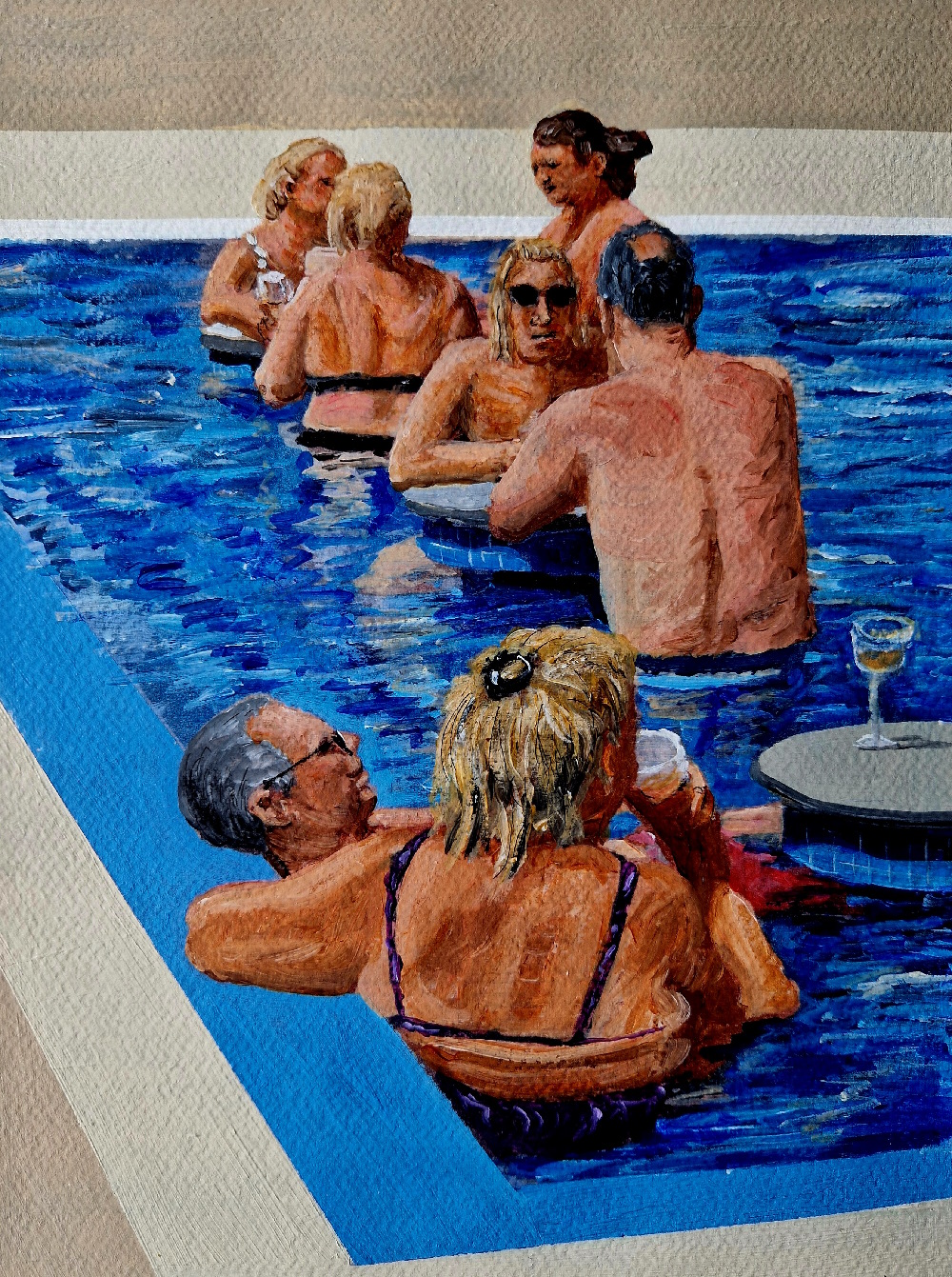
PHILIP R WESTCOTT
As an artist interested in figurative work, Philip always looks for contemporary subjects in situations that reflect today’s way of life. He believes that holidaymakers represent a new field in art.
One of the great changes of modern times has been the growth and importance of the foreign holiday. With the Mediterranean countries providing perfect hot, sunny weather and the reasonable prices of package tours, many more Britons are taking their seasonal two-week holiday away from the unpredictable weather of this country. Early paintings were in oil, but recently, he has experimented with acrylic and digital artwork to capture these images.
Foreign holidays have created a wonderful opportunity to observe people at their leisure. Under the intense, bright light, the colour sometimes becomes muted, and I find trying to capture this effect on canvas quite challenging. In contrast, the gaudy swimwear and beach paraphernalia create instant bold images. Coupled with these are the people themselves. The overcrowded beaches, the position people relax in, and the constantly changing positions look distorted as they seek an all-over tan. Relaxing around the pool or sea areas provides much to observe and capture. The water itself can change quickly, and trying to represent this in unusual and different ways has been one of my main aims. These scenes have been a delightful and exciting source of material from which I have sketched and painted.
Artworks

Swim Up Bar (2023)
Acrylic
An acrylic painting on paper based on a digital sketch.

Family Gathering (2023)
Acrylic
An acrylic painting on paper based on a digital sketch.
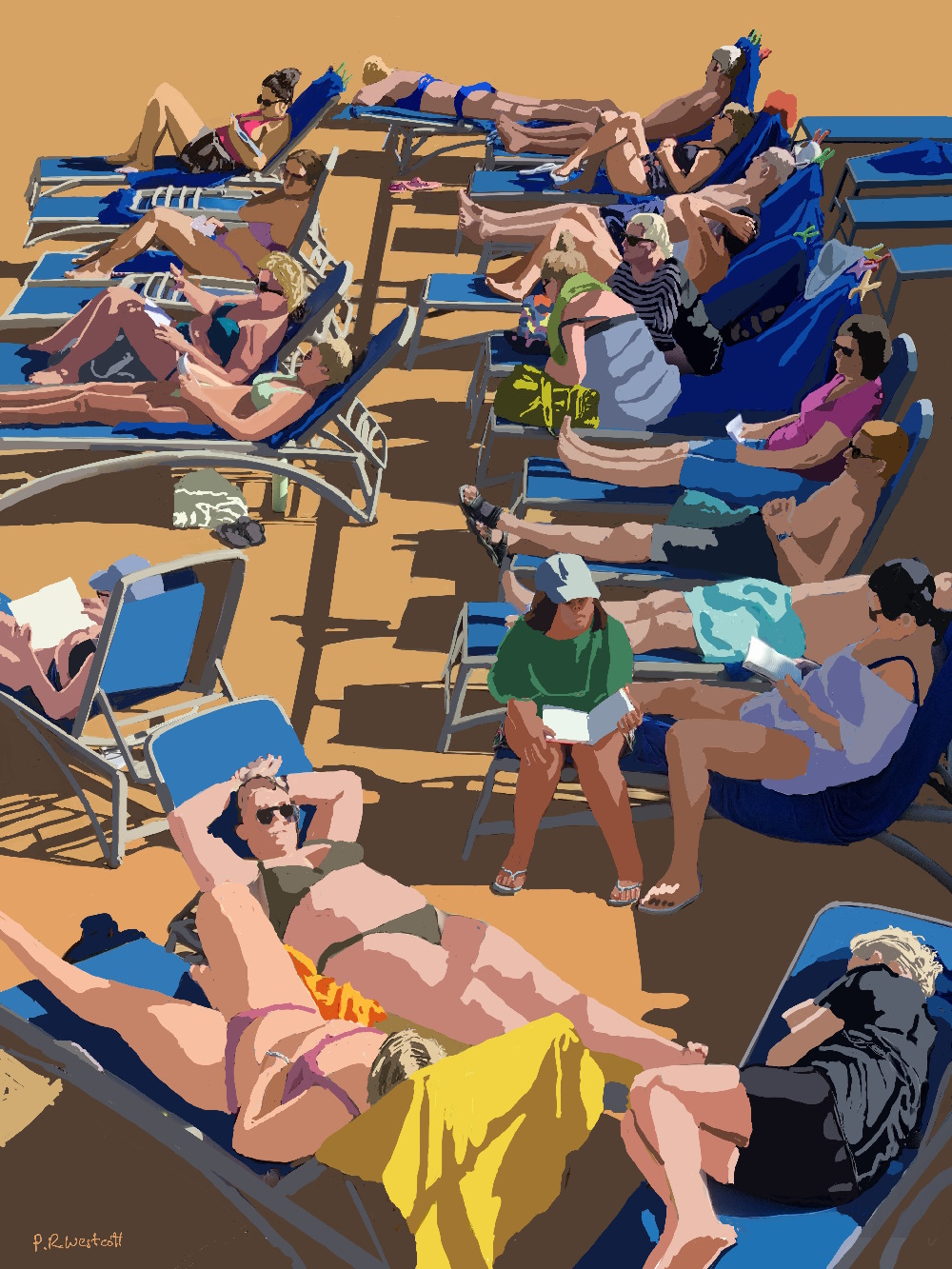
Sundeck (2023)
Digital Drawing
A digital drawing on an iPad drawn with an Apple pencil. This has also been painted in acrylic.
Curatorial Review
Swim Up Bar (2023) creates a relaxed environment with the calmness of the people within the painting who look to be engaged in conversations. The water has great reflective depth, which enhances the relaxing atmosphere of the painting. One can also see the sunlight, which ripples on the surface of the pool’s water and blends subtly into the scene. Every figure within the painting has different expressions and postures, which shows Westcott’s great skill in figurative painting…
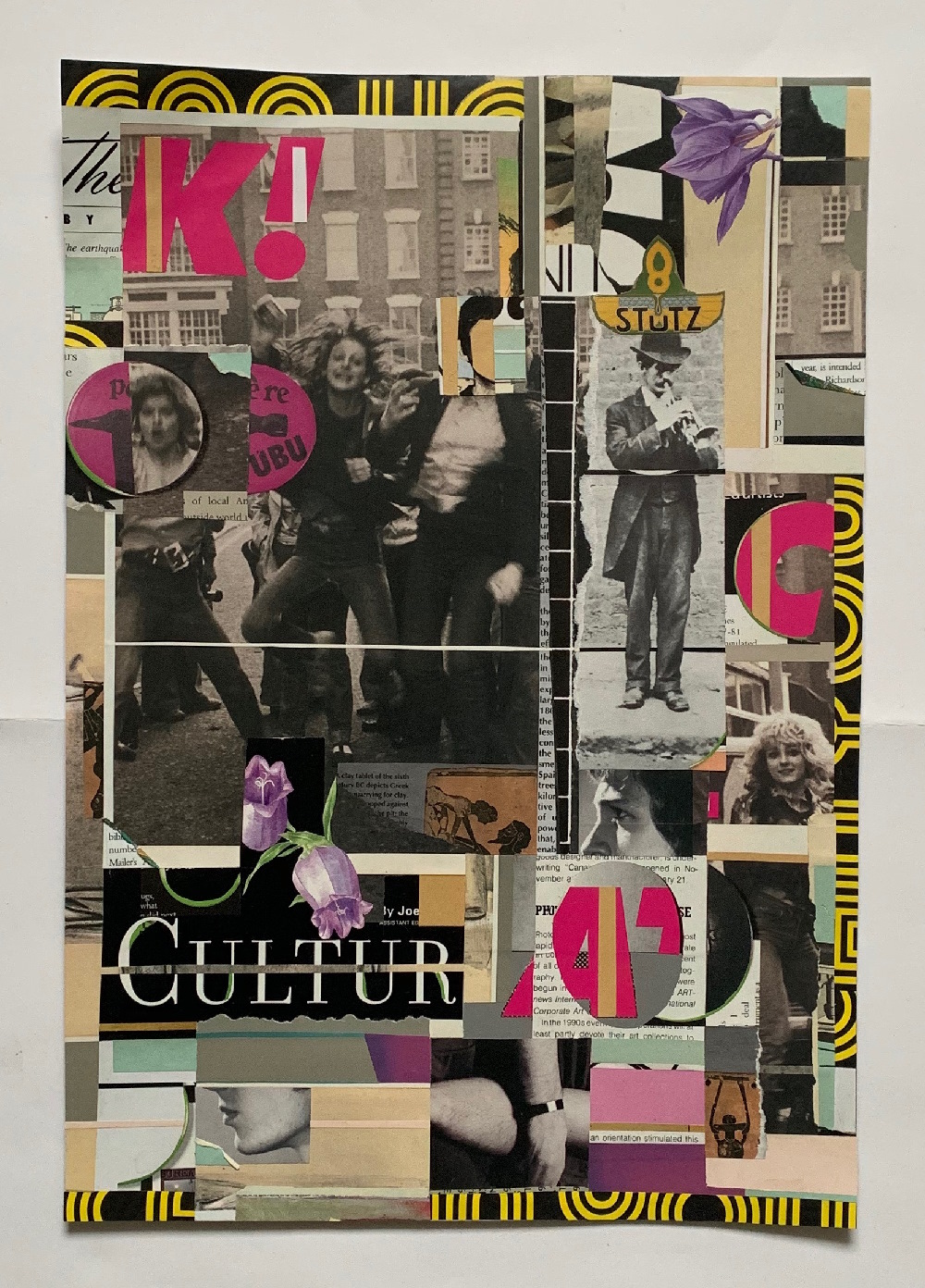
GORAN TOMIC
The series I’m working on is titled “Mapping Approximation” which is a large expansive collection of Collages delving into the consciousness of the Modern Inferno that we inhabit and our oxygen giving participation to its flames. They are Compositions within compositions commenting on the current state of Technology, AI, Climate change, cheap and nasty architecture, disposable culture, medication as food, the new age Jungian world on our doorstep. This is Our Modern Inferno. You won’t find Obvious images of Blood or War or Hell in this series, the underlying theme and Through Line is my personal interpretation of Dante’s inferno.
Artworks

Culture Attack (2024)
Collage on Cardboard
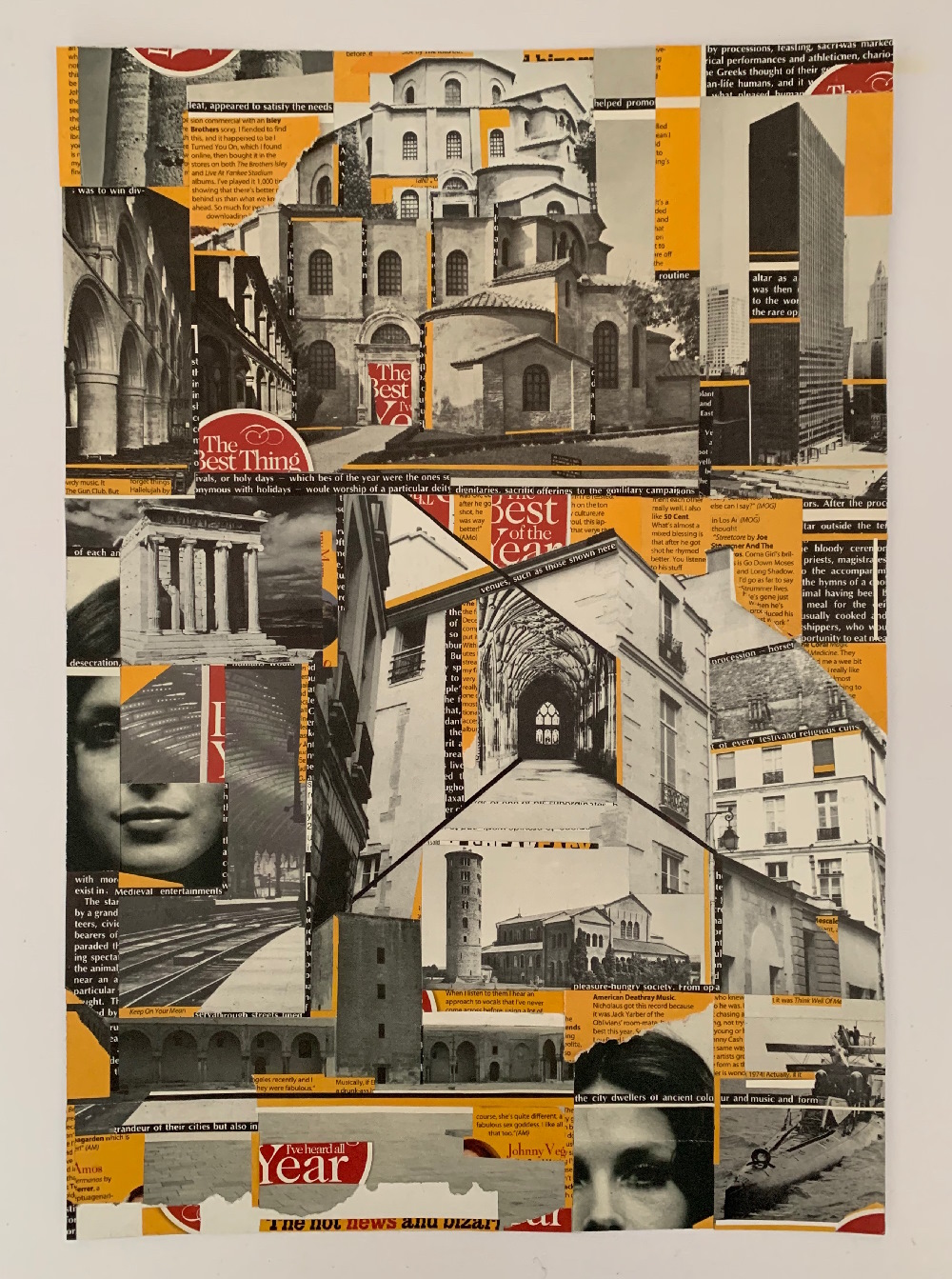
The Best thing I’ve heard all year (2024)
Collage on Cardboard

Turn to page 24 (2024)
Collage on Cardboard
Curatorial Review
Culture Review (2024) invites the viewer into what Tomic considers our ‘Modern Inferno’. The work is part of the series ‘Mapping Approximation,’ which utilizes collage to assemble cultural detritus, history, and a commentary on the state of our world in the present day. The work is a collage on cardboard, which also helps to create a statement on disposability, as cardboard is often disposed of and used to deliver consumerist objects…
DAVID IAN BICKLEY
David Ian Bickley is an award-winning media artist whose body of work spans the primitive technological of the 1970’s to the digital cutting edge of today. His media work has manifested as television, installation, electronic music and video art.
His work has been shown in many major museums, galleries and festivals around the world. LUX London distribute his video art along with [S]edition online. In the early 1980’s Bickley’s video work won 1st prize at the Sony UK Festival and after a move to Ireland in the early 90’s he was fundamental in the evolution of Irish electronic music, earning a Hotpress award in the process. Besides producing video art Bickley has also made important arts documentaries including The Man Who Shot Beckett and the Celtic Songlines. His themes reside in mythic and folklore motif and often use landscape as a form to reflect and process these ideas.
Artworks
CULTIVATE (2023)
Audio / Video
This film abstracts nature to create a hypnotic veil, behind which we glimpse fragments of connectivity from the modern human self to the fundamental materials. Inspired by my own use use of natural elements and minimalistic interventions the film features landscape textures that evoke a sense of timelessness and primal beauty. The visual narrative is interwoven with subtle, ephemeral gestures that echo long walks and land art, emphasising the transient and interconnected nature of our existence. My ambient soundscape further enhance this sensory journey, creating an immersive auditory experience that complements the visual elements. My ambient compositions, known for the ability to transform ordinary environments into meditative spaces, serve as the perfect backdrop to the film’s exploration of isolation and redemption.
Curatorial Review
Cultivate (2023) is a video artwork that moves from slightly realistic natural to highly abstract scenes. The landscapes within the video are seemingly transformed into textured mandala-like patterns. This abstraction helps to enhance the viewer’s immersion as it captures the eye. While watching the video, we notice the pulsation from the video, which helps to create a slight flow of what could be water or foliage…
Interview
What inspired you to start media art and what was it like first starting out in this medium?
I started out in the mid ’70’s, so it was very different to now. No computers, synthesisers were analogue, complicated and very expensive and film was, well, shot on film. All these technologies meant that this wasn’t something you did on a whim or as part of a trend, you had to be really dedicated and willing to physically seek out people who had the knowledge of how to use this gear and who were up for teaching you. My earliest experiments were with an upright piano and two reel to reel tape machines my mother brought from her school, this enabled me to reverse sounds, slow then down and bounce between machines.
What inspired you to move to Ireland in the 1990s and how did moving there impact your creative practice?
I moved to Ireland because I wanted a more raw and immersive rural experience, and this I certainly got. There was little to no electronic music in the early 1990’s Ireland, so my music work saw a fusion with traditional instruments and with the Irish language — this continues to this day. It also saw a move into television and documentary film making, it was this this area where my film training was honed. Documentaries force a director to plan well but also be open to improvisation and more essentially adore to strict quality assurance, something I feel is really important in creative media production.
You mention that your work has evolved alongside major technological advancements, how have these changes affected your practice and process?
As digital technology has evolved I have used my foundations in analogue to bring focus and intent into the process. When we have this understanding we can use devices that are based on pure mathematics in a more organic way. This I believe I have achieved with my work both visually and sonically. It is a matter of using as many machines as possible and finding the most responsive, analogue-feeling way of using each one. Sometimes an expensive device / patch / application may have just one valuable function, although capable of much more, so one mustn’t be afraid of focusing on this — it is all about expression and feel and vibe.
What inspired you to create Cultivate (2023) and how did the idea behind it evolve as you worked on the project?
A recent abstract work. This and others in the series were inspired by reading “The Alfred Wallis Factor” and general research into the St. Ives arts colony and the birth of abstraction in the area known as West Penwith (a place where a lot of my own work has been conceived and created).
The creative / technical process to make these works was extremely arcane & complex and each new incarnation of this style is part of journey of discovery / rediscovery to help build a new calligraphy of process.
Using a HD video images of a small beech wood in West Cork, abstract geometrics are introduced to warp and hide the origin — yet beyond the machinations of the digital lies the essential material of landscape. Still there, underpinning our modern games.
What role does minimalistic intervention have in Cultivate (2023) and why is it important to the work?
Complexity leads to minimalism — by processing and reworking form, the essential material is reduced and fermented until the structure is evident. Minimalism is simple the result of a mediative experience within the focal process of art.
How do you hope viewers will interpret the sense of isolation presented in the work?
As a lingering feeling, a slight sense of loss easing to a yearning for immersion in the essential fabric of organic time.
Looking back on your creative career, what is the most fulfilling moment you’ve had as an artist?
It is all one moment, one can’t separate the work from life nor divide reality any more than perception.
Are there any projects you’re currently working on or any artistic directions you’re exploring that you’d like to share?
Currently working on a number of generative music works, a non narrative film based on Alchemy and an exploration of Irish and West Country Folklore with a number of collaborators both here and aboard.
CHLOE HUGHES
As an artist, I like my work visually representing how I process the world—taking in various forms of information and looking for physical points to hold onto. I am a photographer who makes information art. Working at the intersection of data, information, and imagery, my work explores the evolving relationship between identity and technology in the digital age. Photography transcends mere visual documentation; it is a narrative of personal encounters, reflecting how each experience reshapes our sense of self. In today’s hyper-connected world, the information we absorb and interact with becomes vital to our identity, altering our perception and leaving an indelible virtual imprint—a digital DNA.
My artistic process involves embedding various forms of data directly into the code of a photograph through sound format, transforming it into a living canvas that reflects the inherent distortions of our existence. This technique, known as “glitching,” is a manifestation of data’s physical and conceptual corruption, where the image becomes a tangible representation of the chaotic, unpredictable nature of our interaction with technology. By merging sound, text, and visual data, I create a layered narrative that challenges the viewer to reconsider the authenticity and stability of the digital images that saturate our lives.
I am drawn to this process because of its inherent unpredictability. Much like abstract painters who surrender control to the flow of paint, I relinquish a degree of authority to technology, allowing it to dictate the outcome. This collaboration between artist and machine generates a visual language that is both personal and universal, mirroring the fragmented and dynamic way we experience the world through screens. I seek to provoke reflection on how technology shapes our identity, perception, and the very nature of reality in a constantly shifting digital landscape.
Artworks
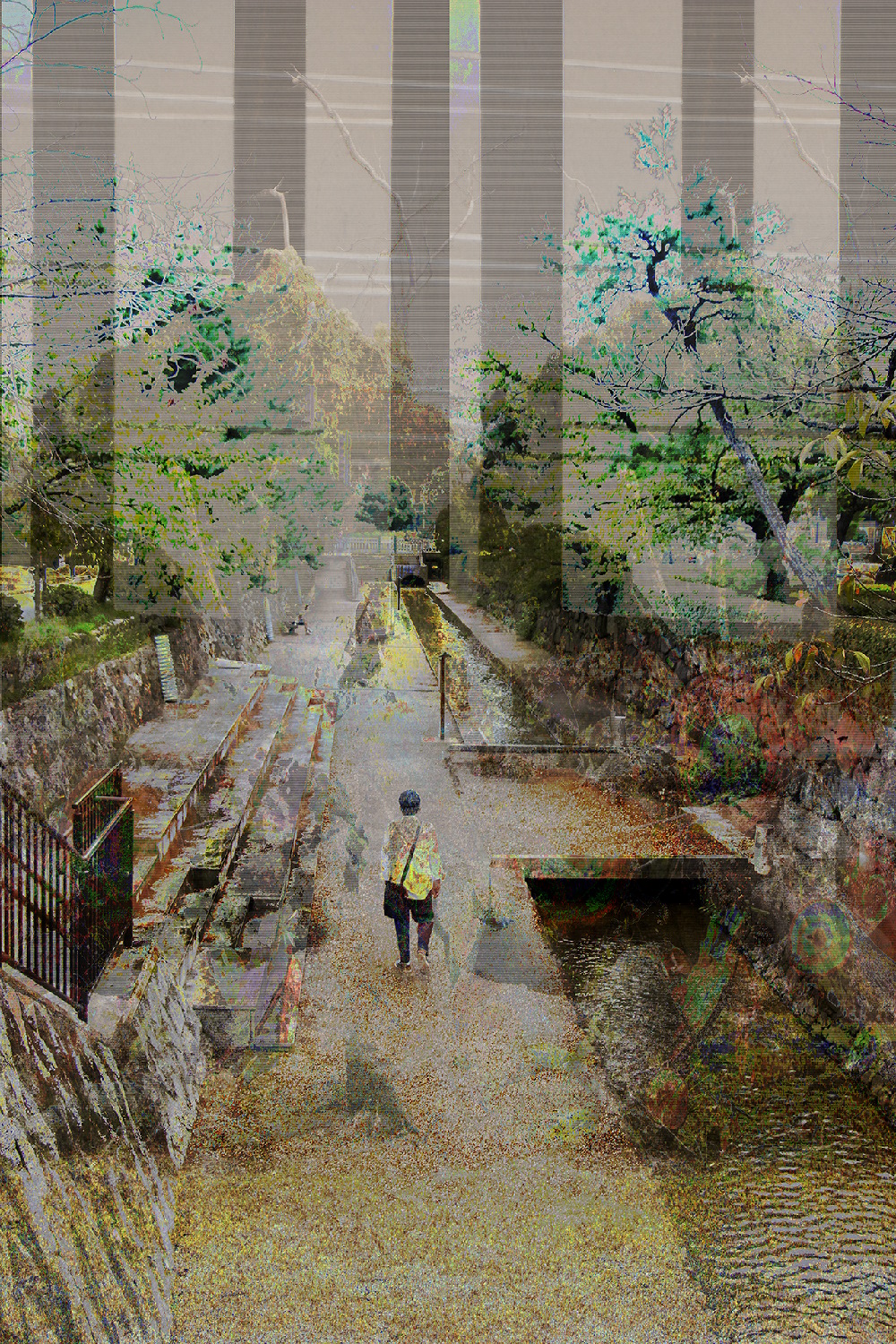
_MG_6201 (2024)
Photography (Information Art)
This image combines sound, photography and information to create a striking, textural look. The aesthetic is visible from the noise produced during the merging process, where the photograph is ripped apart and put back together in a new code configuration. The artwork took over 500 hours to create due to the potential of corruption when changing an image’s code. The photographs were taken in Kyoto in 2018, and the configuration began in 2020. The printing was 2024: Information Art – Hahnemühle William Turner paper, Magnetic Frame. While travelling in Japan, I captured these photographs in Kyoto, tracing a path through some of its most serene and storied locations. The journey began at Higashiyama Jisho-ji temple and continued through the tranquil grounds of Hōnen-in Temple, leading to Nanzen-ji. We wandered further and unknowingly and found ourselves on the Philosopher’s Walk—a renowned 2-kilometre path along a canal with cherry trees. Although it was not cherry blossom season, the walk’s stillness and natural beauty left a profound impression. Although we only did a small section of the walk, you could feel the importance of why it has developed its reputation. This path, whose name came from philosopher Nishida Kitaro, who meditated here during his walks to the university, offered a moment of deep connection to the surroundings. The sparse presence of people amplified the sense of solitude and immersion in nature. This piece is a composite of three photographs taken at different stages of the walk and the temples. The pastel tones reflect the calmness and introspection I experienced, capturing the essence of this meditative journey.
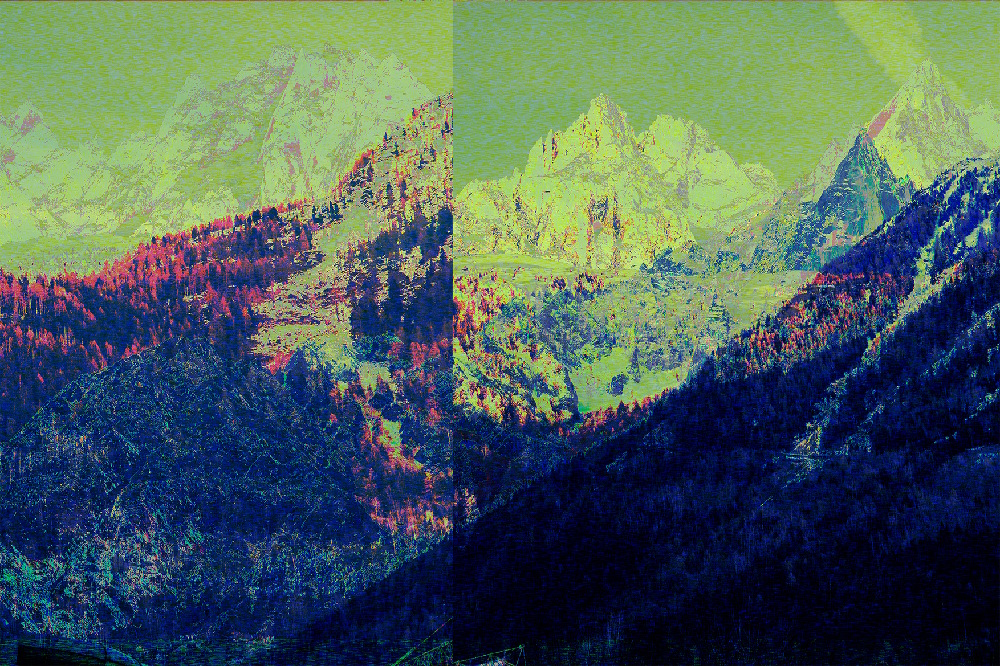
IMG_1544MC.590.2 – Silence of Protest II (2024)
Photography (Information Art)
This particular print was created whilst in Chamonix, France from the Brevent. This is part of an ongoing project, exploring the connection between what we experience, and what is known. Within the digital age there is a constant bombardment of information, but as we lift our heads this travels to our subconscious, with us but not in front of us. Whilst I was exploring the silent vast mountains, a matter of hours from us was the French farmer protests for better living. conditions and better protection for local produce.
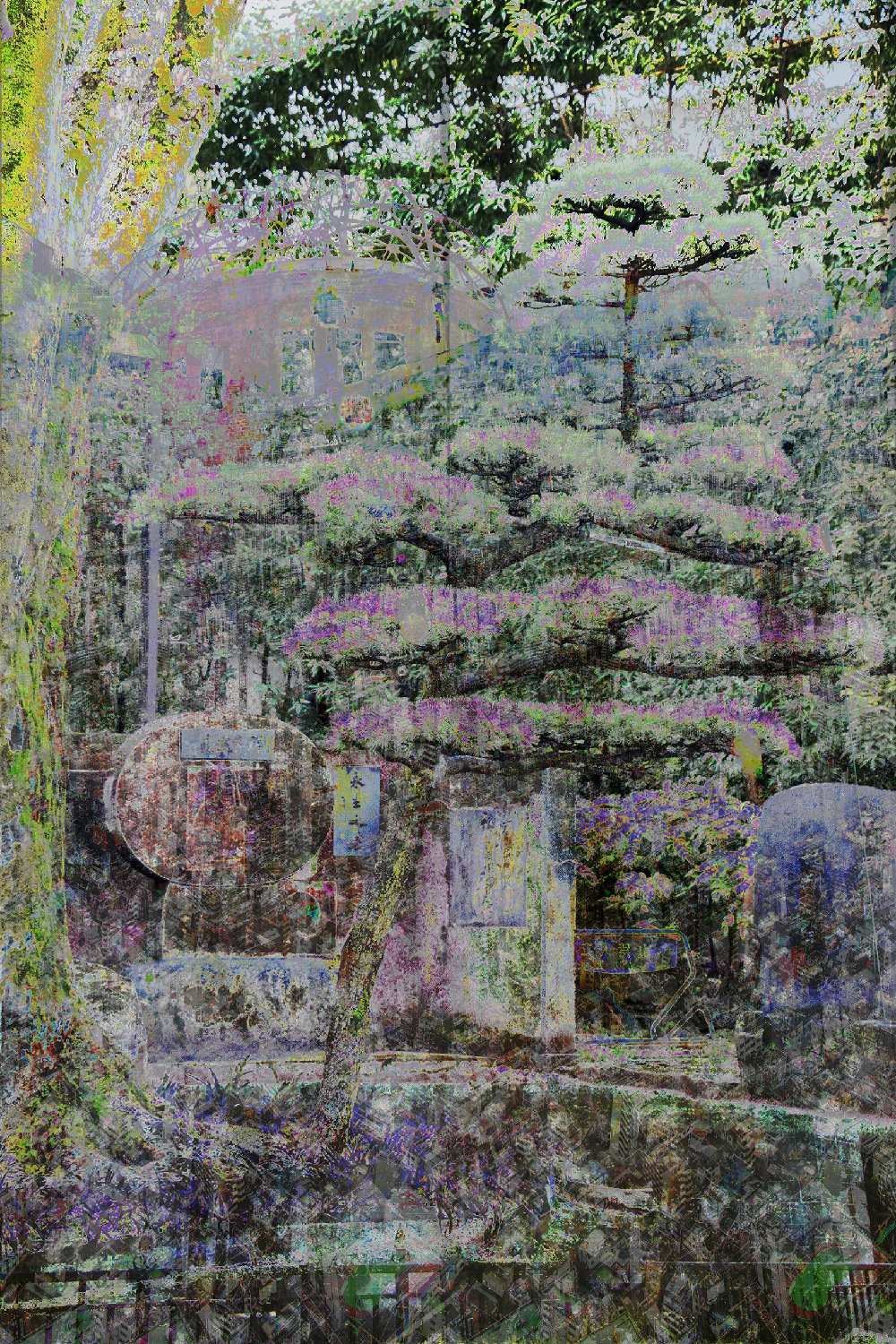
_MG_808083_29 (2023)
Photography (Information Art)
This print is one of my newest using a technique I have been working on over the last six years of combining sound, photography and information, to create a striking, textual look. I have been exploring this technique to see how different forms of information can be presented in a singular format. We take in quantities of information everyday in a technological age, and I have been exploring how I can represent this constant exposure that whilst our consciousness puts to one side, sits within our subconscious stewing. There has been a lot of conversation around the growing exposure to mass information, and the impact this is having on the next generation. This aesthetic is visible from the noise produced during the merging process, where the photograph is ripped apart and put back together in a new code configuration. The artwork took around 800 hours (6 weeks) to create, the photograph and information was collected in 2018, but the artwork was put together over 2023 and 2024. This particular photograph was created whilst in Tokyo. The artwork is printed into Gloss Aluminium as a Premium ChromaLuxe HD Print.
Curatorial Review
MG_6201 (2024) explores Hughes’s journey and memory on the Philosopher’s Walk in Kyoto, Japan. The corruption of the image data has created a great layering of texture within the photograph, while the image is merged with another image. This, therefore, allows the viewer to see multiple elements within one region, which moves the viewer’s eye around to examine every small detail of the work…
Interview
When did (and how) you become first interested in merging photography with data manipulation?
In 2017, while studying, I explored the physical imprints left behind after Motorcycle races at Brands Hatch—crash marks, burnouts, and debris. This led me to consider the invisible imprints we leave, bringing it into a digital approach. I began merging photography with technological data, incorporating sound recordings and telemetry. My approach evolved into what I call “Information Art,” blending documentary photography with self-taught image manipulation. This fusion allows me to capture both the tangible and intangible, revealing unseen narratives within each moment.
Can you explain the process behind embedding data into photographs? What tools or software do you use?
I collect various data types—photography as the base, combined with sound recordings, articles, telemetry from racing suits, etc. The data and photography are all converted into sound, which I manipulate and merge. This often results in corrupted or glitched visuals, requiring weeks to refine. The process involves relinquishing some control to technology, embracing its unpredictability. Currently, I’m refining the sound component, making it more bearable to hear to complement the visuals and enhance the sensory experience.
What inspired you to experiment with glitching? How do you see this technique evolving in your work?
The, Are-Bure-Boke style of Japanese photography, particularly during the Provoke Era, challenged traditional Western aesthetics with rough, blurred, and out-of-focus photography—an early form of what could be considered glitching. This inspired my approach, showing that imperfection can enhance narrative depth. As technology evolves, so does how we define art. New tools offer greater control and intricacy in digital manipulation. I see my practice expanding with emerging software, refining how I integrate sound, data, and imagery into immersive experiences.
Can you describe an unexpected outcome in your glitching process that you liked?
One unexpected outcome was my Crushed into Corruption project, where files became so corrupted they wouldn’t register—turning failure into art: https://wheldonphotographic.co.uk/corruption-of-colour.
Another was in Silence of Protest, a series photographed in the French Alps. The original muted tones of white and grey unexpectedly transformed into vibrant, contrasting colours, creating a striking visual paradox. These moments of digital unpredictability are what make glitching so compelling. Technology, like nature, has its own way of reshaping perception.
How is the digital age shaping how we perceive our identities?
Technology has become an extension of identity. We exist both physically and digitally, though whether this digital-self reflects reality is debatable. Our reliance on technology permeates daily life in communication, commerce, entertainment, even self-expression. Photography, once about seeing, is now about proving existence. My work examines this shift, reflecting how digital footprints construct identity. In an age of instant documentation, we capture before we experience, shaping our sense of self through screens.
What messages do you hope viewers take away from your work?
I want viewers to reflect on the tension between capturing a moment and being present within it. Photography freezes time, but moments are fluid, affected by surroundings, emotions, and unseen events. My work merges different layers of time and data, revealing the broader context behind an image. Whether it’s an approaching storm, an unnoticed movement, or a distant event, I want audiences to feel the motion within stillness, to experience the unseen story beyond the frame.
Which artists, movements, or technological advancements have influenced your work?
The Provoke movement remains a key influence, reshaping my perception of photography beyond traditional aesthetics. Technological advancements, particularly in biotechnologies and digital tracking, have also shaped my practice. My early work relied on telemetry from racing suits, bridging the physical and digital. As technology advances, new tools offer deeper integration of sound, data, and imagery. Each innovation expands the possibilities of storytelling in art.
Where do you see your art in the coming years? Any upcoming projects?
My work continues to evolve, with long-term projects still in development. Silence of Protest remains ongoing, and I’m exploring new directions with a recent project from my time in Istanbul. Each piece takes time, shaped by experimentation and technological advancements. As I refine my process, I aim to push the boundaries of data-driven photography, creating immersive works that challenge how we perceive images, information, and the passage of time. Additionally, I’m developing an immersive experience that merges visuals with sound, allowing audiences not only to see the art but also to hear it, deepening the sensory connection.
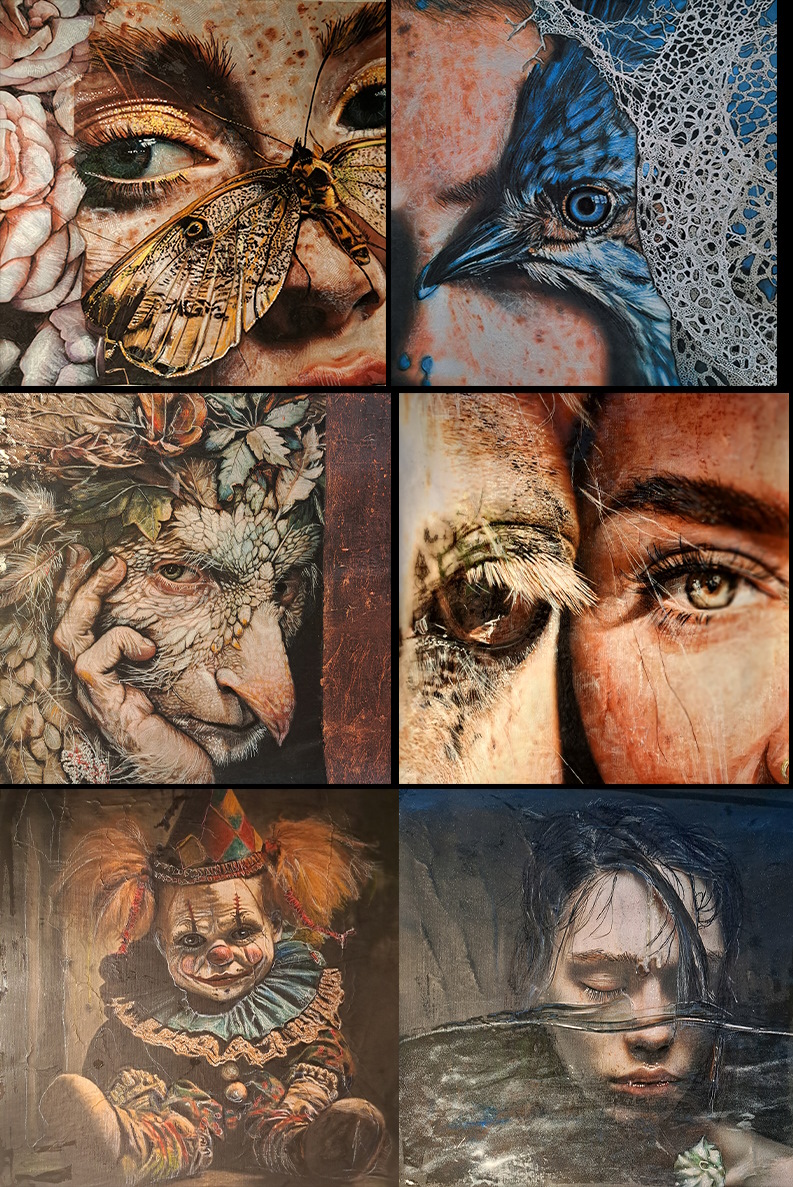
REINHARD RIEDEL
My journey as an artist has been a lifelong endeavour, interwoven with a career in computer science and mathematics. The intersection of these disciplines has shaped my approach to art, blending analytical precision with creative exploration. Now retired from the IT sector, I immerse myself fully in my artistic practice, focusing primarily on small-format portraits. These works develop their expressiveness through collages, allowing for a nuanced exploration of human emotions and relationships. My recent projects reflect a commitment to themes of light and shadow, as well as the intricate dynamics of human and natural forms.
Thematically, I focus on the image of women in every society: the woman as object or subject. I find my motifs in classic fashion photography and photographic art. I am increasingly using the possibilities of AI in my compositions.
My current focus is on small-format square pictures, all in 38 x 38 cm format, which achieve a special effect when grouped together as a collage. The buyer can put together his own work of art and, if hung appropriately, then also extend or change it. The special depth of colour and the realistic painting style are created by layering at least 4 layers of paint in different painting techniques, which complement each other in the right order (airbrush, watercolour, oil and acrylic for the surface structures).
Artworks
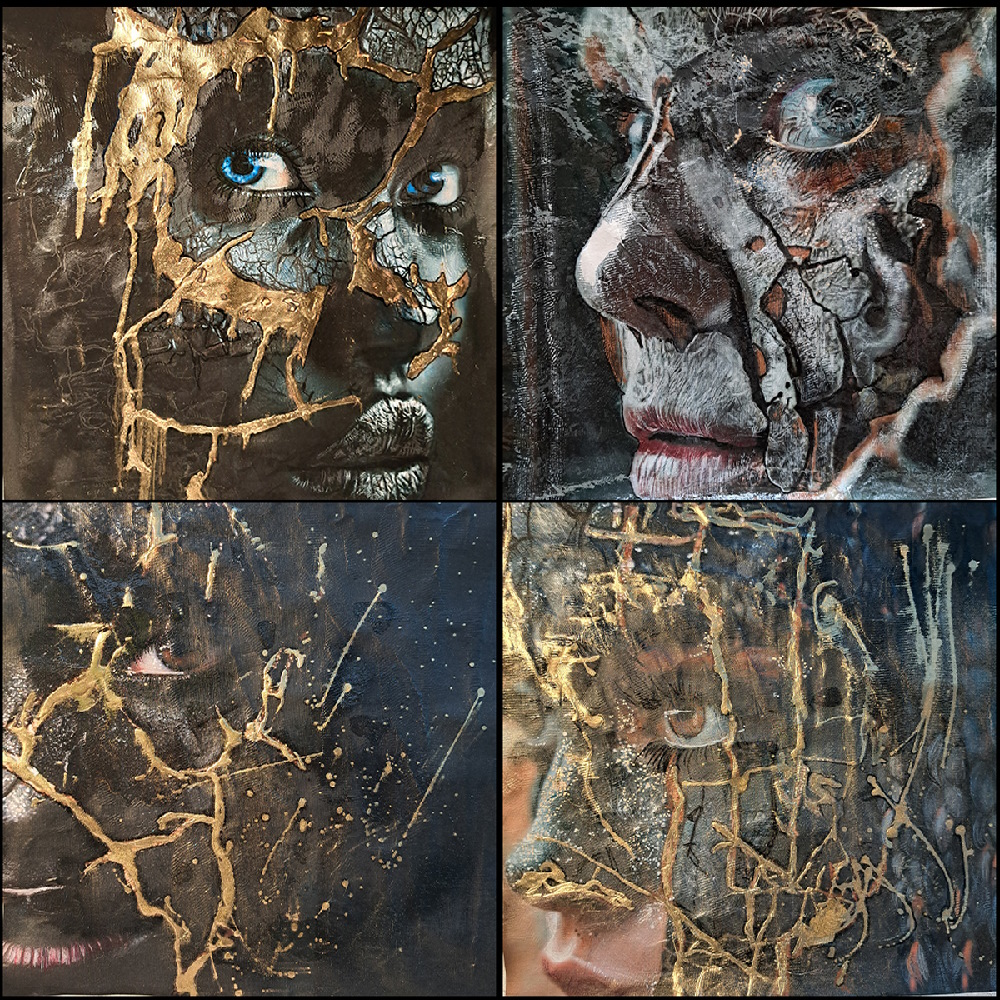
t1 (2024)
mixed techniques on canvas
Due to the combination of different painting techniques (airbrush, watercolor, acrylic, oil), the textures and reflections on the surface, the composition using analog and digital means and the hanging as a tripthychon, the pictures have an undisputed unique selling point in terms of depth of color and level of detail. The collage hanging of the pictures as an installation is then more than a single picture can achieve. It creates a movie in the mind of the viewer.
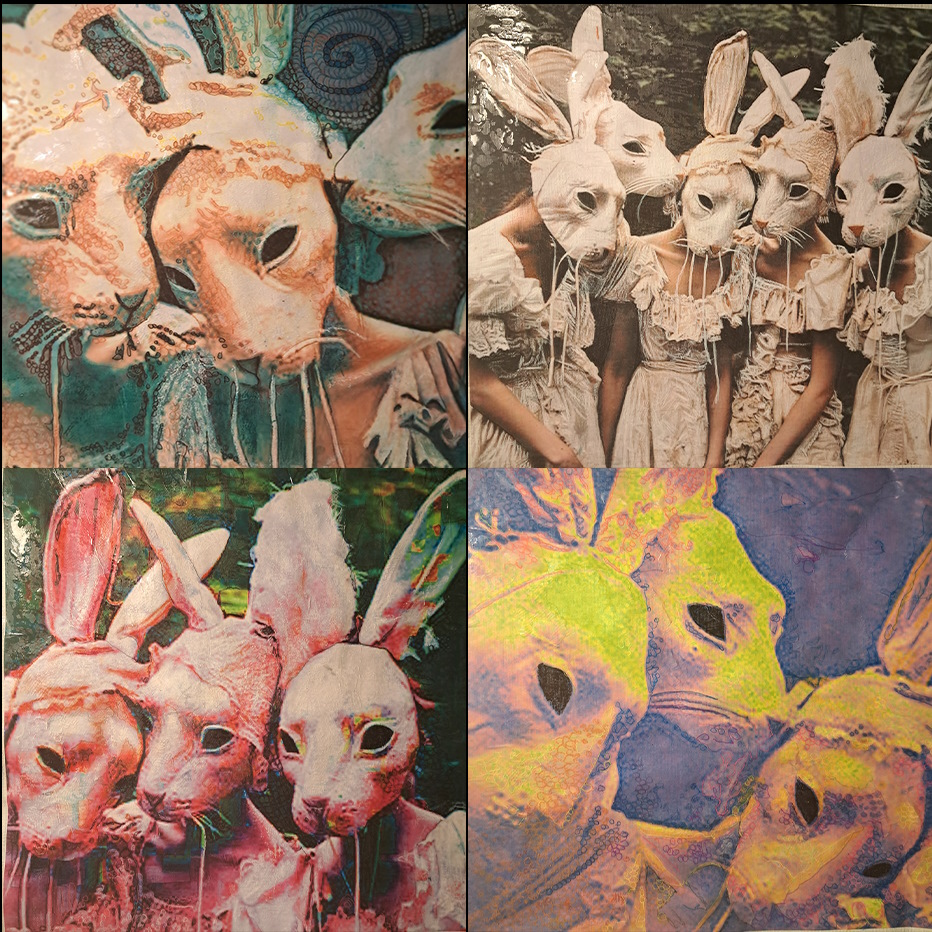
t2 (2024)
mixed techniques on canvas
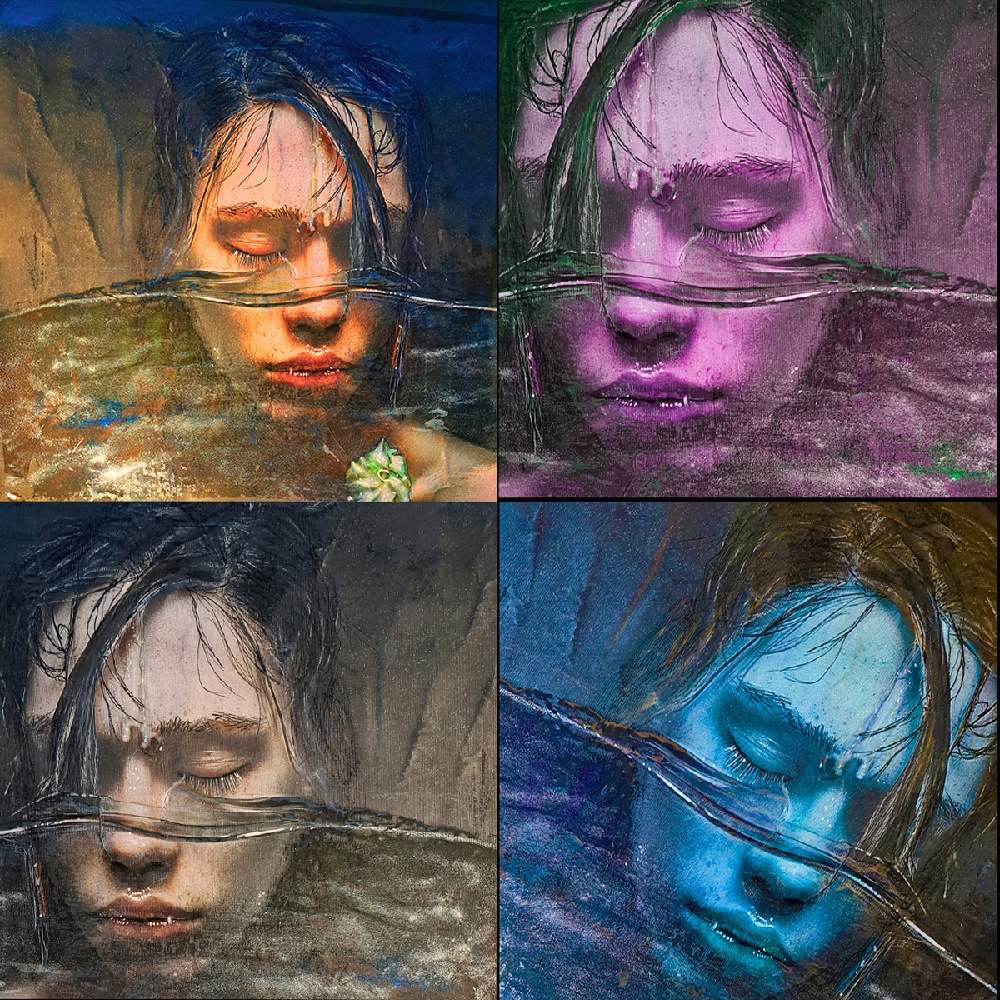
t3 (2024)
mixed techniques on canvas
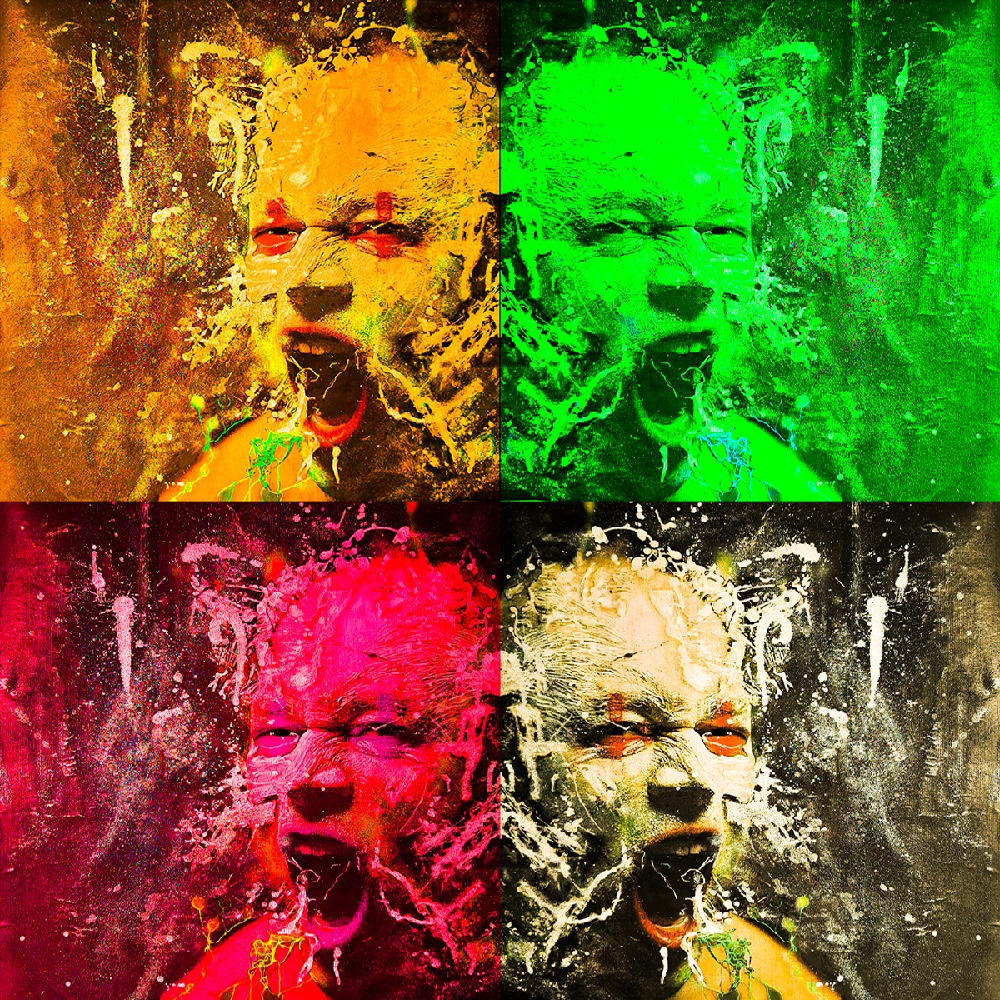
t3 (2024)
mixed techniques on canvas
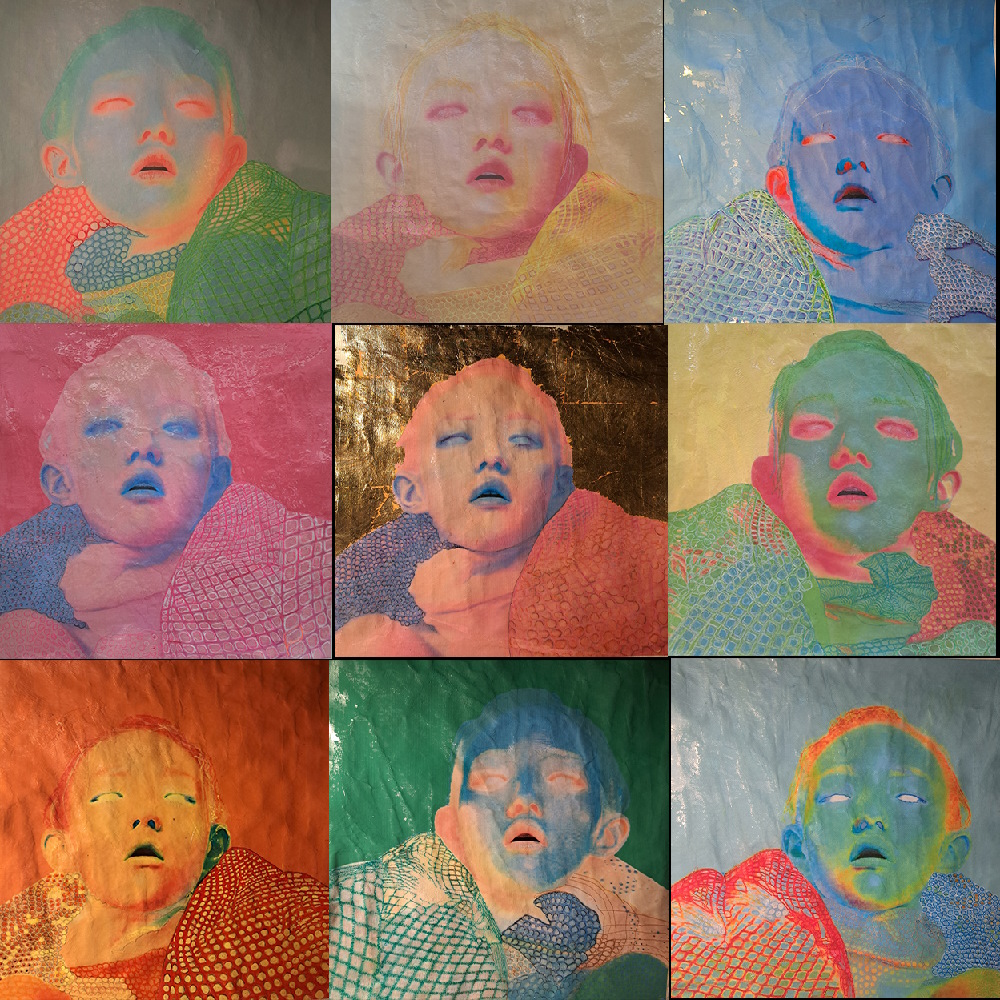
t4 (2024)
mixed techniques on canvas
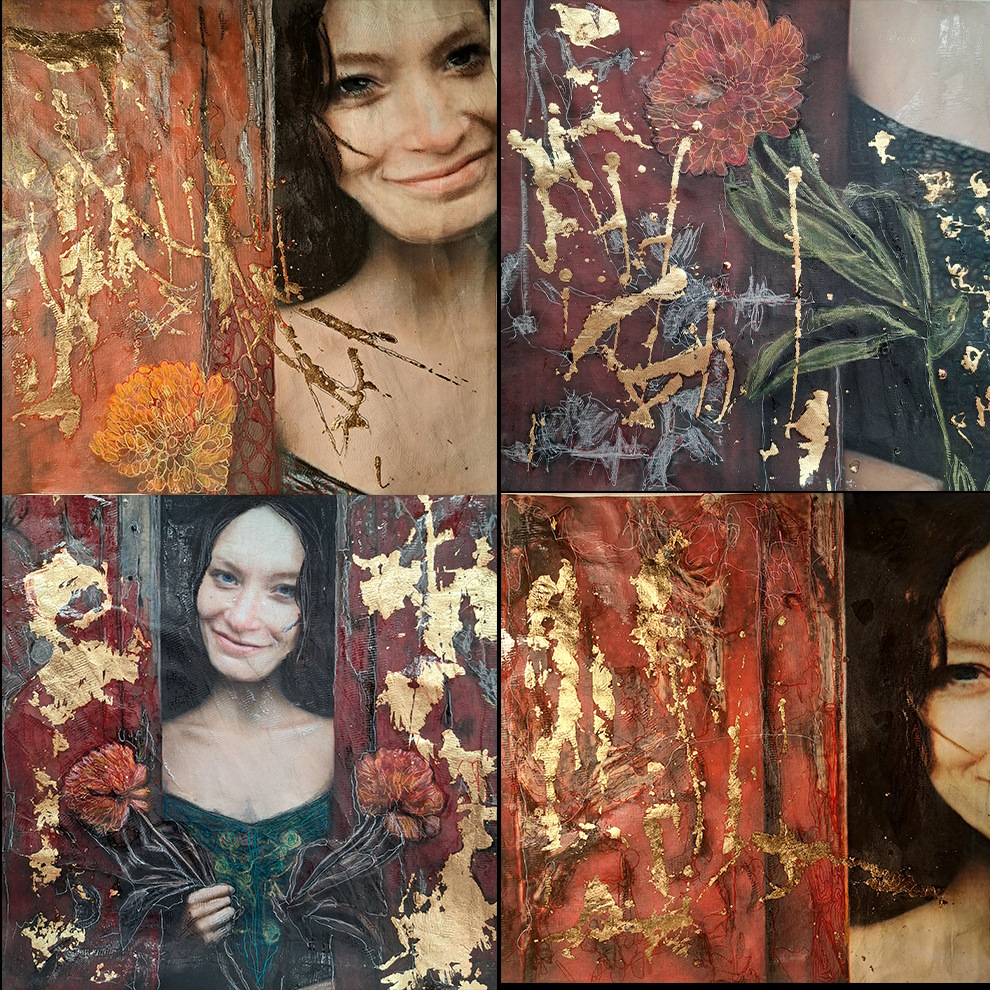
t5 (2024)
mixed techniques on canvas
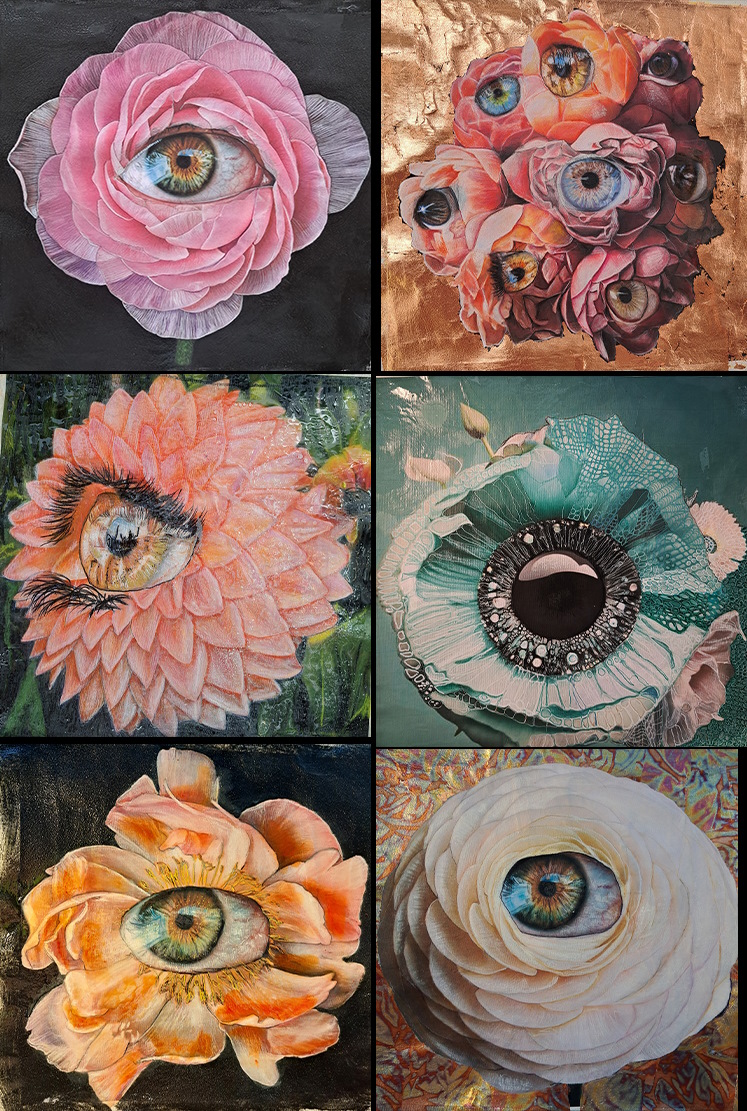
t7 (2024)
mixed techniques on canvas
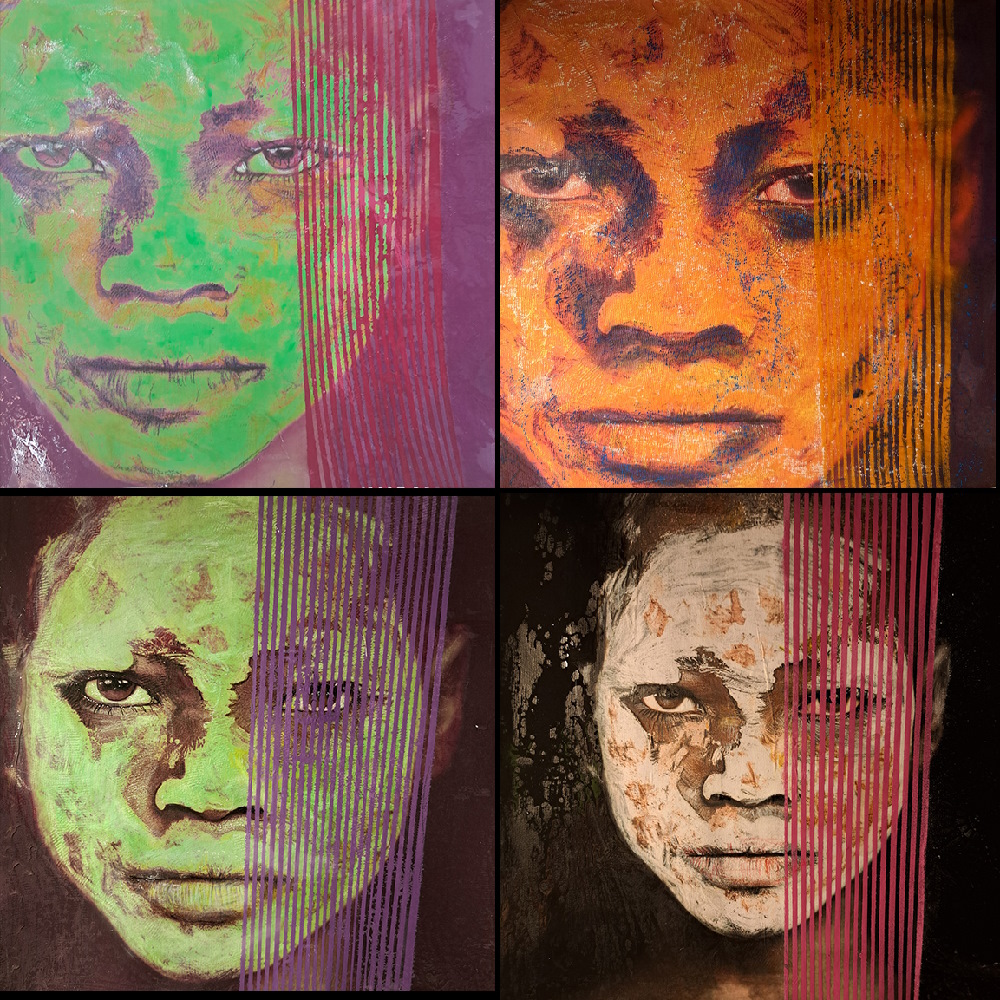
t6 (2024)
mixed techniques on canvas
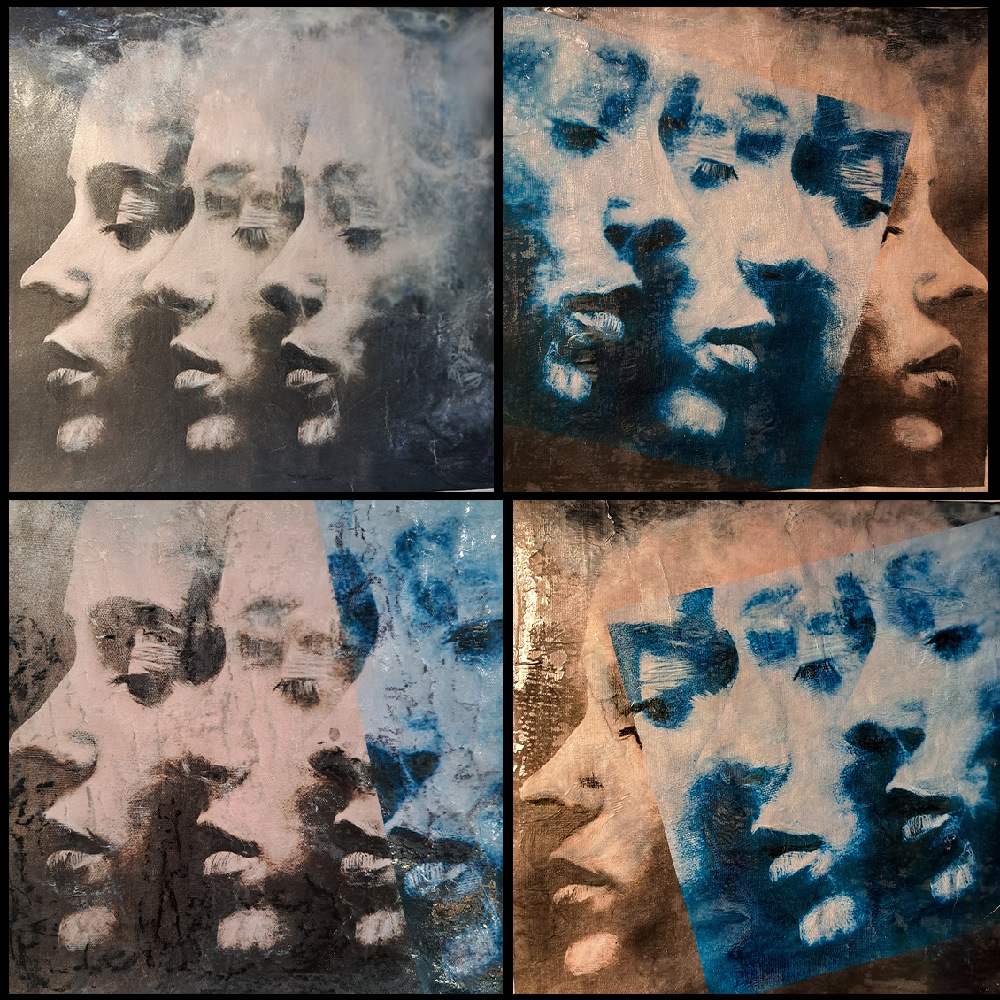
t9 (2024)
mixed techniques on canvas

t8 (2024)
mixed techniques on canvas
Curatorial Review
When you first look at t1 (2024), you will see that it blends texture and realism quite skillfully. On a closer examination of these textured parts, the layering stands out, as there is great luminosity, shadows, and depth within the composition. This creates quite a sculptural appearance to the figures in the work, while the contrasts with the light and dark help to enhance this feel…
Interview
How has your career in computer science and mathematics influence or change your approach to art?
For me, art comes from professional skill. Professional means repeating, comparing, changing. Here I am certainly very strongly influenced by IT technology and IT procedures. Once you have acquired the technical skills for realistic figurative work, you can use this as a basis for thinking about series. And only at this point do I use the possibilities of digitization. And essentially for the composition of the series. Before I go to the canvas, the composition work is finished. Unfortunately, for me as a (hyper)realistic painter, the digital world is an unconquerable competitor. That’s why I have to set myself apart from it in terms of textures and surface techniques and do things by hand that a print simply can’t do.
Can you describe your creative process on one of the works you’ve submitted in this publication from the concept to its completion?
Picture t9 is perhaps the best way to understand my approach. The source of ideas for a new painting is actually always fashion photography or photographic art. Every painter working realistically needs a model, in the classical sense a human model in the artist’s studio. Like every graphic designer, I then choose the section, the direction of the motif and then build the final motif myself, or with the help of an AI or simply with Photoshop, from various sources. So here is the side view, selected differently and put together again. Shadows and color transitions play a subordinate role for me, because I can create details myself by painting. And now I paint the first picture of the new series to find out whether the composition on the screen also works on the canvas, which is not always the case. If I think it works, then I assemble the collage on the screen. Either by grouping different basic designs or I develop an overall picture, which I then cut into individual pictures or reassemble from parts.
Your work explores the image of women in society; what has drawn you to this subject?
Nothing else ever came into question for me. Unlike in classic fashion photography, however, my focus is more on the beauty of the female as a subject. There it’s more the object. It was only over time that animal portraits were added. It was unexpected for me that these also develop a very strong individuality in the picture.
You mentioned about AI- how do you think AI-generated imagery is influencing contemporary art and how do you integrate AI into your work; what is the process for this?
Realistically working painters cannot compete with digitally created realistic images in terms of craftsmanship. But when it comes to color depth, color transitions, textures and reflections, they can. Because this is where people have to painstakingly rework the digital suggestions. Textures and reflections are not yet possible in a comparable way with prints.
What advantages or challenges have you encountered when using AI?
I certainly save myself 80 percent of the effort in the composition and on the way to the point where the details in the picture play the decisive role. But the challenge is certainly that an AI takes something from another artist and places it in a different context. Somehow I always feel like a kind of plagiarist.
Are there any artists who have inspired or influenced your work?
Gottfried Helnwein
What first brought you to a collage format?
As always in life, coincidence. Three years ago, I exhibited as a sculptor at a large art fair and wanted to use the space above the sculptures to present my diversity as a painter. But there was only room for small formats. As Petersburg hangings are not permitted at art fairs, I came up with the idea of the collage, because as an installation, the curator cannot prohibit the hanging of several pictures. A gallery then gave me the idea because they said: “The individual pictures are ok, but the collage is what adds value.
Are there any memorable viewer reactions you’ve had to one of your collage compositions?
The concept is not initially supported by galleries. The aim here is to present large formats in line with the art zeitgeist. My idea that interested parties should put together their own work of art and see this as an opportunity to become artists themselves is too much for most visitors. If I succeed in persuading the interested party to choose several pictures from my large selection of different motifs and colors and then group them together with him to form a collage, then the AHA effect is created. If the collage is also professionally framed, then he understands this in particular as a picture created by him, consisting of several individual pictures. And the reluctance turns into enthusiasm, because what is then hanging on the wall, perhaps in an unusual format to suit the room, is something very special and individual. And the owner has created it himself.
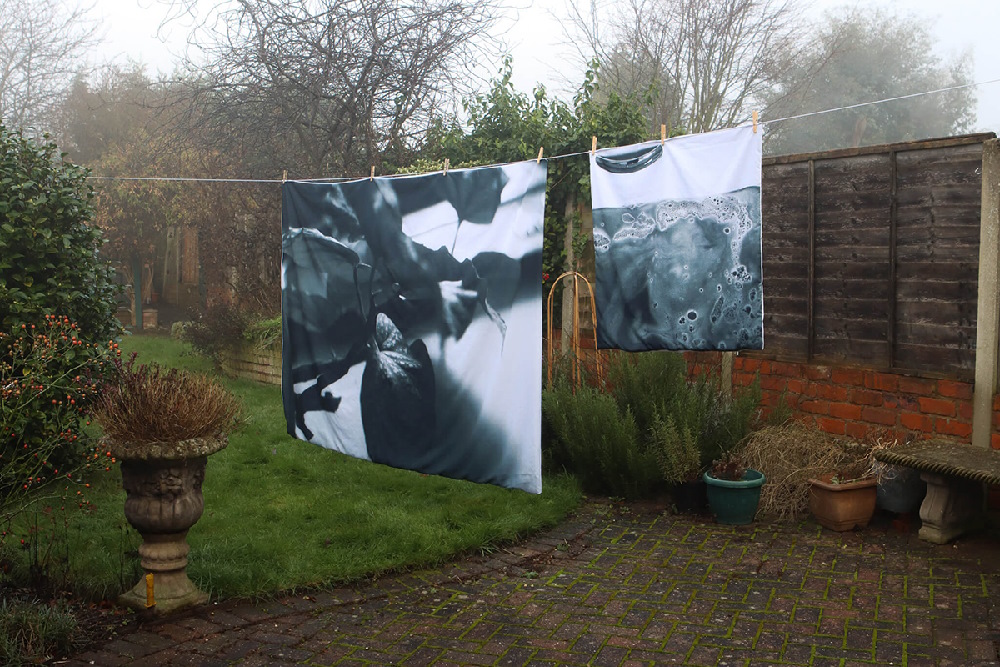
HAZEL E HUTCHISON
Hazel Hutchison is a multi-disciplinary artist based in the Midlands UK, who works with experimental and alternative photographic methods, collage, and installation. She is interested in alternative photographic processes such as Caffenol or plant-based development, materiality, and display techniques. Hazel’s work explores topics of landscape, domesticity, and identity. Her recent artwork “Route’ has focused on looking at natural adaptations and learning from nature’s resilience. She has been using this connection to nature to express emotions and a desire to adapt to life’s challenges.
Both artistic processes are related to the impact past surgery has had on her: she uses economical photographic methods (developing photographic negatives with coffee/soda washing/vitamin C) that are considered a lower risk to health, which are then displayed onto glass to covey fragility.
Artworks
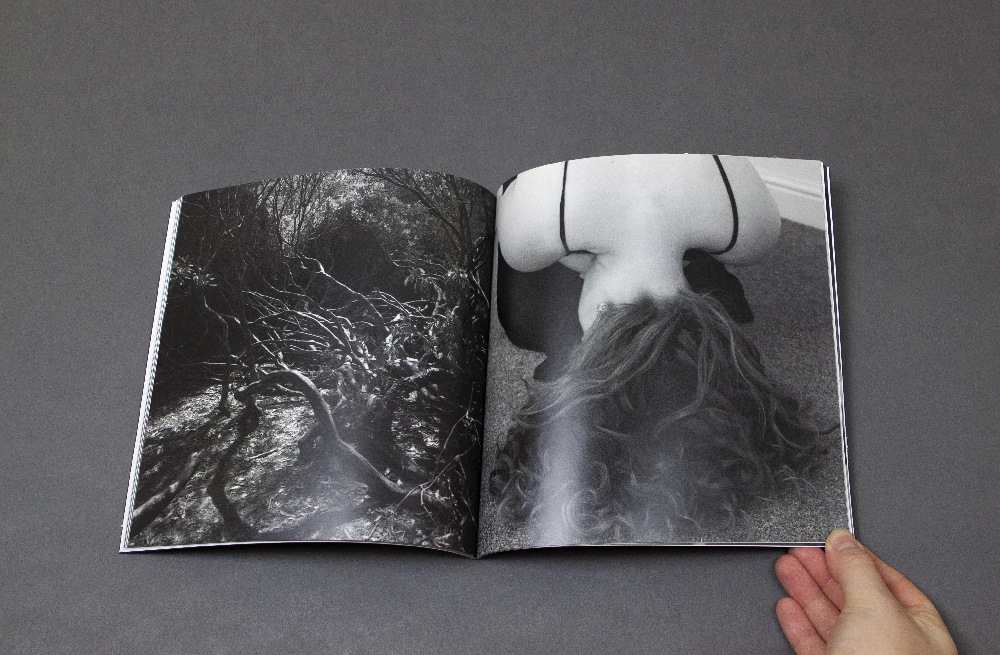
Route (2021)
Photography
Route illustrates a journey of personal recovery. I have been exploring a personal examination of bodily and mental fragility which stemmed from a surgical experience in 2019. I wanted to demonstrate a motivation to be out more in nature while inside during lockdown (2020-2021), and to reflect the connection between myself, my body, and the adaptations found there. Conceptually, I decided to explore how external factors affect appearance and draw comparisons with my own body post-surgery; observing the idea that humans and nature both go through challenges. Route has resulted in a sequence of photographic diptychs, one larger and one smaller sculpture. I wanted to show domesticity (which was my landscape during lockdown) by creating indoor self-portraiture influenced by a natural adaptation outside. I have been drawing on lessons from resilience in nature, as a way of representing my own emotions and desire to adapt after life’s challenges.Both of my artistic processes are related to the impact surgery had on me; I use economical photographic methods (developing photographic negatives with coffee/soda washing/vitamin C or plants) that are considered a lower risk to health, which I then display onto glass to convey fragility.

Route (2021)
Installation
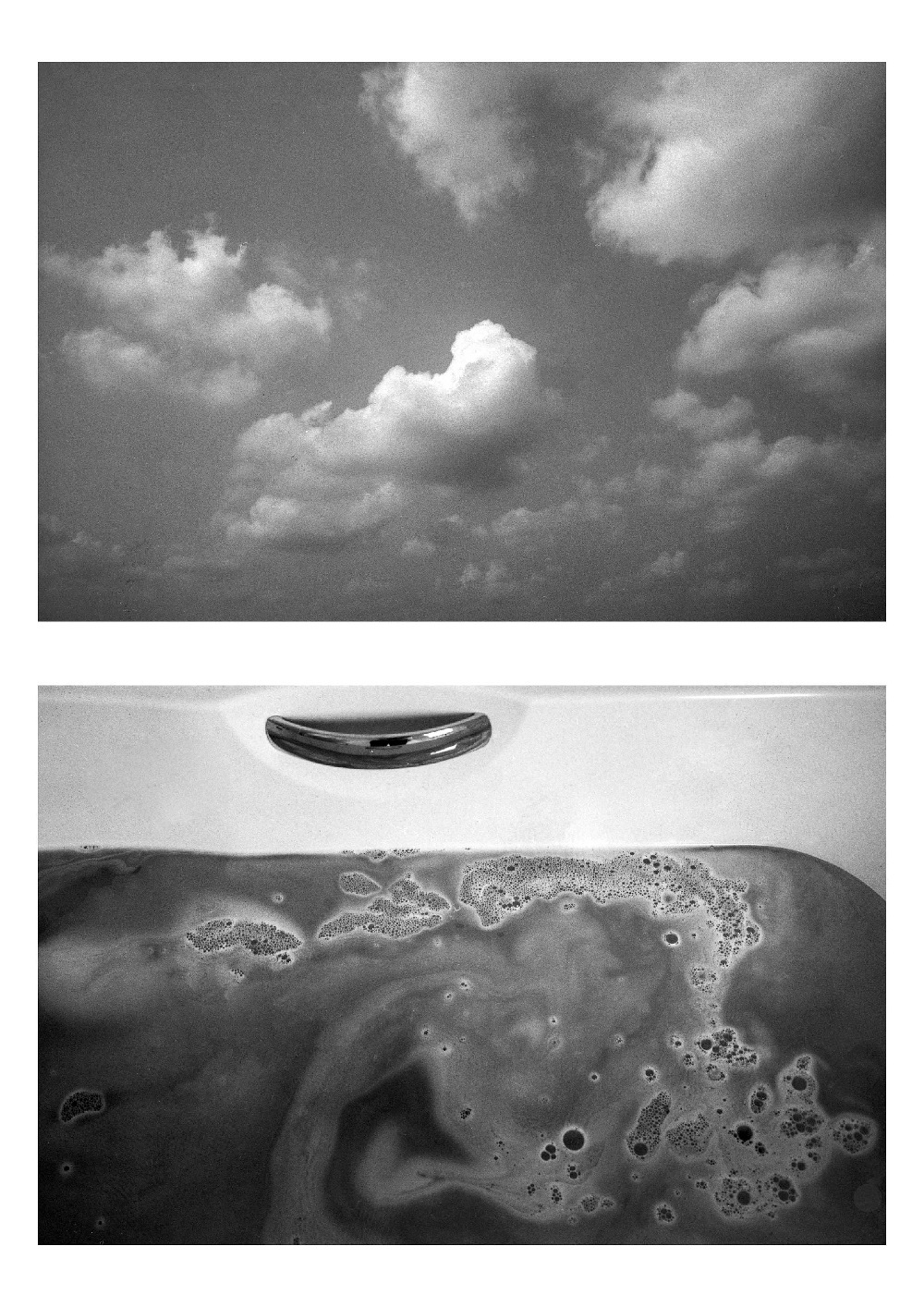
Allusions of Grandeur (2022)
Photography/Installation
I wanted to explore the idea of grandeur in a domestic setting. I have been thinking about how landscape and domesticity have been portrayed as separate subjects in photography, and I want to combine the two. Presenting parallels between vast landscapes and ordinary household items I have experimented with perspective and scale. I have frequently found myself photographing large landscapes and then returning home to develop them using household items! Our experience of lockdown has shown that people are craving vast open spaces after being constrained at home. I plan to investigate the notion of grandeur further and what it implies in a residential setting, with the objective of recreating the effect of a traditional landscape shot indoors. I have paid tribute to landscape photography by using a 6×9 medium format camera and making all this artwork in my home, incorporating my surroundings in the photographs and trying to capture the awe of a traditional black and white landscape shot.

Allusions of Grandeur (2022)
Photography/Installation
Curatorial Review
Allusions of Grandeur (2022) presents both domesticity and landscapes, combines them, and challenges the convention that they cannot be merged. Using a skyscape at the top of the composition and the bathtub at the bottom of the composition combines them and makes it as though the water within the bath is potentially a landscape (or a set of islands) of its own. The scale of both- the skyscape being infinite while the bath being much smaller in person interacts with the viewer as it challenges perspective, scale and, within the context of the title, grandeur…
Interview
What first got you started in experimental photography and mixed media?
In my line of work as a graphic designer, I spend a lot of time in front of a computer screen for commercial projects. I try to minimise the technical aspects of my own artistic work and embrace the flaws that come with analogue photography and printmaking. The small nuances that I find so fascinating are not something that I believe a machine can capture. Additionally, I believe that in art, material should always be taken into account within the concept. I want to try new things, and I think that both the approach and the content are important. Since these two elements are related to health, I felt that they should both be highlighted.
Are there any challenges or advantages to working with these economical photographic methods?
Indeed, learning about Caffenol was a fascinating experience, and it took me some time to get the desired effects—a lot of this was due to research and experimentation. Anxiety over my health initially sparked this desire to learn more, but it eventually evolved into a new challenge and an awareness of a whole community of photographers looking for eco-friendly methods to guarantee the survival of analogue photography in the future.
Can you explain your process of developing with these methods compared to more traditional methods?
My preferred method of photography is called Caffenol, which was developed in 1995 by Dr. Williams of the Rochester Institute of Technology and involves the use of coffee, washing soda, and vitamin C to develop photographic film (Killmayer, 2015). It was appealing to be able to utilise readily available, safe, and widely used ingredients at home. Chemicals used in traditional photography are known to be hazardous, and because of their negative effects on the environment, large quantities of them should not go down the drain. I believed that consideration should be given to the importance of working in a location securely and mindfully as well as the effects of choosing different creative supplies.
Caffenol’s drawbacks include the possibility that it won’t always yield the desired effects and guesswork about development times, but I’ve learnt a lot more about analogue processes than I may have with conventional photo chemicals. Additionally, Caffenol may leave a faint coffee stain on your negative, so scanning them in will give your photos a warm tone that, in my opinion, creates a pleasing impression. You could experiment with a lot more things, like beetroot developer, lemon balm, etc.
What do you hope that viewers will take away from engaging with your work?
Once more, I believe that spending a lot of time in front of a computer screen is the reason I want to incorporate an interactive element into my artwork. Helen Chadwick’s Ego Geometria Sum is another work that greatly inspires me. In order to convey to the audience a sense of openness and acceptance of mental and physical health issues, I sought to replicate a freestanding illusion-like sculpture in my series.
What inspired you to connect your personal recovery, which is seen in Route (2021), with the themes of nature and adaptation?
I find it interesting how humans place meanings and associations onto landscapes, maybe as a way to understand place and circumstances better. I did not want to show human action but be more of an observer of a natural adaptation, as an admiration of naturally occurring resilience, I guess I wanted to encourage this for myself and processing my own trauma.
How did observing the natural world- in its resilience- help you cope with or process your personal challenges?
Overall, my art grew out of an experience in life that had a profound effect on my work and process. My conceptual ideas, presentation, and development of them for example, have changed considerably. This is evident from previously working mostly as a digital artist to becoming someone who works more physically and experimentally. I will continue to explore landscape, domesticity and identity in themes. I think looking externally has helped me process trauma, but also helped me see that everything in life (not just humans) adapts.
Can you describe a specific moment in nature that has inspired one of the diptyches in Route?
After exploring the Peak District, Stanton Moor and coming upon a weather-beaten tree, I got the concept for Route. It made me think of my body following a series of surgeries that I had undergone within years of one another. Collision changed the tree’s shape, but it continued to stand and grow in a different way. This struck me as a graphic representation of the difficulties and adaptations of life.
What were some of the challenges you faced while creating Route?
My main challenges were to do with the glass aspect of the work. I sought a more direct way to display photographs within the viewer’s setting, contemplating whether an architectural approach could give creative strength to visual storytelling. Glass is expressed as a metaphor for the thoughts and the sense of delicacy felt during trauma. The Caffenol negatives are scanned into a computer and then digitally printed as transparent, ceramic decal transfers, which are then wet and carefully placed on glass cut sheets. Finally, these are sent off to be heated by kiln which retains the image indefinitely, embedding the image into the glass.
Originally I had tried screen printing but this lost the tonality that wanted for my photographs.
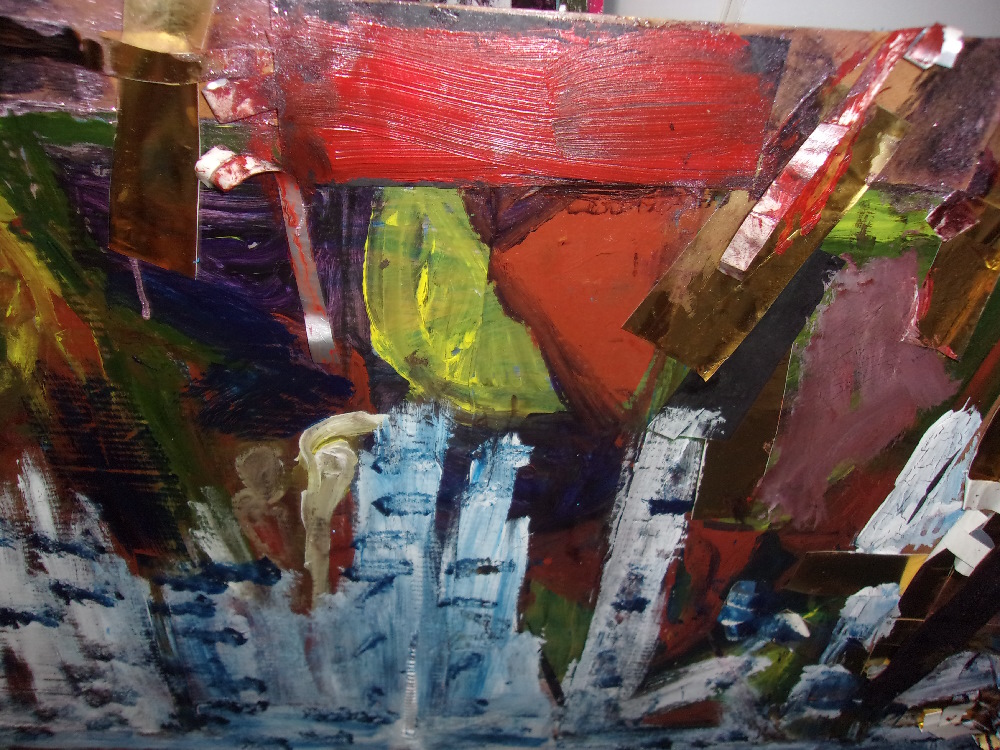
FATMA DURMUSH
Art continues to Miss Fatma Durmush’s interests making her into an artist makes her life worthwhile. The gong sounded when she was attacked and she realised she may have died and then she began to paint. After the harrowing experience, she left writing her unpublished novels and said enough is enough I want to paint instead. This serious decision made everyone shake their heads. What if she did succeed? What then would they have to know, and shame on them, they did. They found she was just not a fool.
Artworks

I see red (2024)
Collage
I see red as a child’s toy with the world the worst thing in life is to live not by the rules but by your own rules.
Curatorial Review
I See Red (2024) explores the artist’s exploration of their trauma, along with the chaos of life and being able to control it with your own rules. The artwork itself is a declaration of the artist not to be held by other people’s rules but rather her own. It thus captures the self-realisation of the artist’s transformation and empowers the artist…

LUCY FENNELL
Lucy Fennell (she/they) is a person claiming to be an artist, although they don’t have much to go by, in terms of an artist career. Currently in her third and final year of battling for a fine art degree at Falmouth University, her impressive body of work (according to her parents) traverses the themes of surrealism, postmodernism, feminism, performance art, body art, and whatever else that comes up on their foryou page that remotely piques her interest.
Most recently, they have been exploring the body as an art form in terms of performance and video, as to how we can use this to investigate identity, senses and physical and mental limitations. Their aim is to facilitate the viewers to conceptualise their own interpretations of the works, to share these with others, to foster communion, and above all, to question the essence of what the hell they’re looking at.
Artworks

The Dress (2024)
Acrylic, pomegranate, beetroot, stitching and printed text on cotton dress
I’m quite interested in the whole concept of interactive artworks and displays at exhibitions – it reminds me of the ones I’d go to as a child, and seeing the ‘please touch’ signs next to a stuffed bear would bring me immense, indescribable joy. In retrospect, perhaps it was the overall sensory seeking aspect that I enjoyed the most. Influenced by Ana Mendieta’s performance Rape Scene (1973), an extremely confrontational work made in response to a rape and murder that had recently taken place at the University of Iowa, (where she was studying at the time) she posed as the semi-nude, bloodied victim of sexual assault. She is growing up, no longer an innocent child, but a young woman – a crucible of metamorphosis, caterpillar to butterfly, bud to rose, subject to object – for this transformation comes with the price of sacrificing your innate purity for the sexual gratification of this cruel, cruel world.

What were you Wearing? (2024)
Acrylic and pomegranate on cotton shirt and jersey trousers
I paint my hands red, pressing them to the shirt. Once white, blank, untouched, bare, pure, now sullied by unknown hands – now the damaged virgin. This work may very well relate to me being touch starved. I feel ashamed in admitting this. To long for skin contact or a simple hug seems low, to the point where I’d do anything at all to just feel the brush of his skin against mine. Harvey’s Myra and Mendieta’s Body Tracks/Silueta series informed this piece. The handprints speak for themselves in demonstrating the implications of the piece – assault. There are multiple handprints on the shirt, implying multiple assailants.
Curatorial Review
The Dress (2024) is a dress that has been stained with red and pink stains, which are a resemblance to violence, blood and vulnerability. The dress is made of white cotton which perfectly allows for these stains to be imprinted onto it and show the scene as it is. The stains are made from acrylic, pomegranate, and beetroot ground the work in a more organic state. This can be compared to the organicity of the human body. Along with these materials being organic- they much more resemble blood than acrylic.
From a closer inspection of the work, the viewer should notice a poem on the dress. However, from the publication, it is too small to see that red and pink replications of blood have enveloped the poem. The poem would, if you were to be near the artwork, invite the viewer to get closer to the work to inspect it much more closely. The poem seems to explore the metamorphosis and transformation of the body in which, in this artwork, the body seems to have transformed through brutality and violence…

NOLAN FLYNN
Each painting begins as a spark of an idea, akin to a lucid dream with an audience of one. This impulse stems from the urge to create something unseen, essential, and challenging. My work seeks raw honesty and boldness, allowing materials to remain vital and visible. There’s a controlled lack of finality, where strokes, marks, and mediums coexist freely, unfiltered by external intervention.
I often start with everyday objects like Crayola markers or charcoal, grounding the work emotionally and visually. These tools are manipulated; water erodes pigments, and mediums reshape surfaces forming a skeletal framework, a “launch pad” for what follows.
This evolves into a phase where paints and airbrush layers interact like an improvised dance. The rhythm between control and surrender builds a dynamic interplay, much like the Argentine Tango. Media such as oil sticks and airbrush become part of a negotiation with positive and negative spaces, balancing compositional tension.
Floating forms, fleeting marks, and non-anchored compositions invite viewers into spaces of instability and impermanence, rejecting traditional grounding. My work explores deeper questions: What is worth keeping or discarding? What does it mean to be deeply impacted yet unchanged? It seeks beauty in fleeting discovery, embracing experiences without tangible permanence. Some things exist to be felt, not understood: this tension between transience and impact is where my art lives.
Artworks

Untitled no. 1 (2024)
Mixed medium on 140#C2
Each piece begins with an embryonic sketch, created with Crayola markers—chosen for their water-soluble properties. These initial marks, urgent yet intentional, evoke a sense of fragility, much like the ephemeral quality of Michael Krebber’s work, as if they might blow away with the wind. Water and brush are then introduced to soften and blend the lines, transforming the sketch into something akin to a watercolor painting. From there, I layer oil paint, carefully preserving the tonal essence of the original sketch. The oil palette is rich yet balanced, leaning on complementary color schemes to maintain harmony. The finished works are lighthearted, playful, and deliberately noncommittal, capturing a spirit of experimentation and spontaneity.

Untitled no. 3 (2024)
Mixed medium on 140#C2

Untitled no. 6 (2024)
Mixed medium on 140#C2
Curatorial Review
Untitled No. 1 (2024) is an extremely abstract mixed-media painting; from the bottom, we can see what resembles flowers. This could suggest a landscape scene as it evolves into two trees alongside red blocks of colour; these blocks could be an extension of the field of flowers or shadows from the trees. Above the trees, the glowing red areas look as though they have wings coming from them, which could be interpreted as angels…
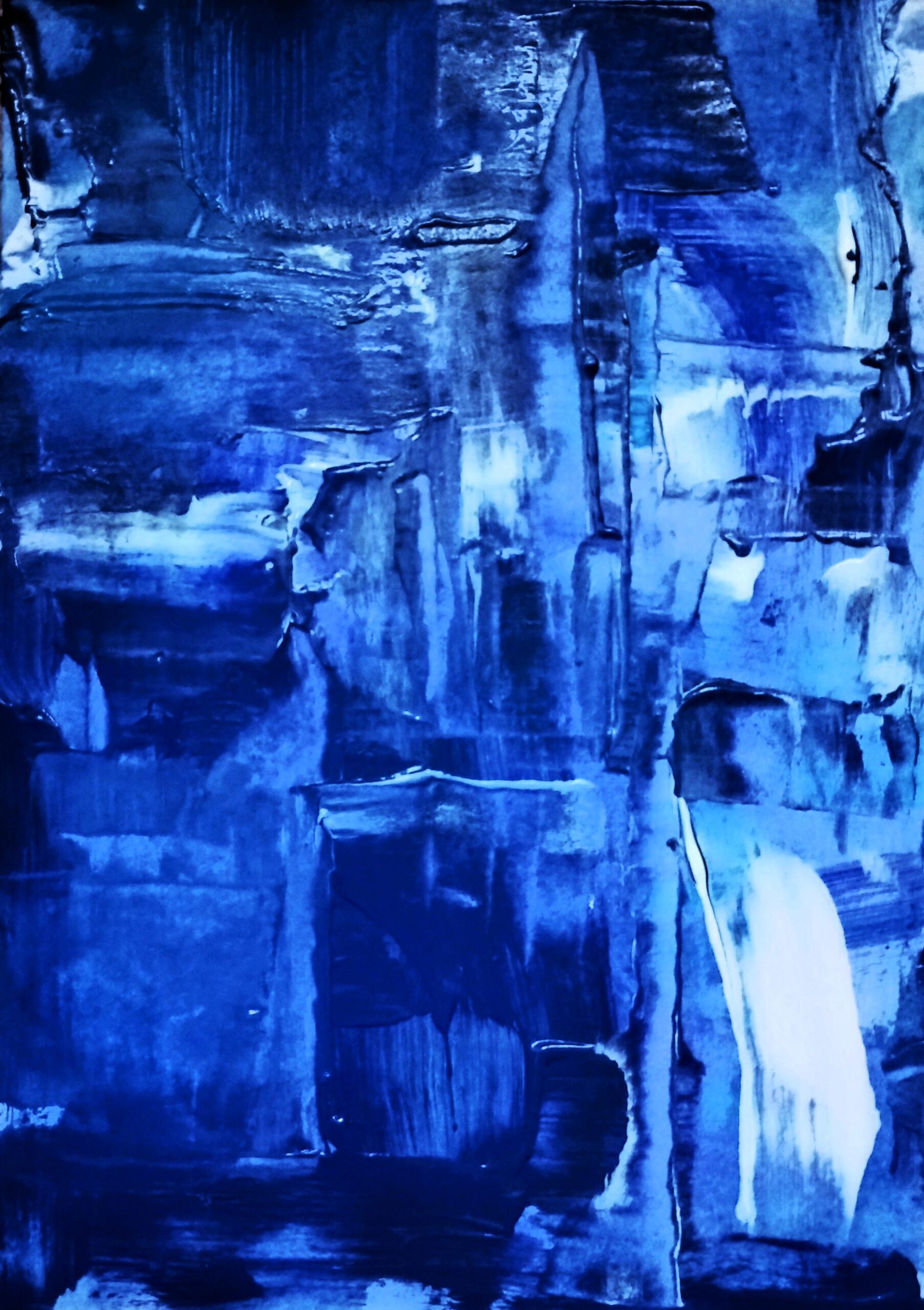
NIKOL PINTOVÁ
Nikol Pintová is a multidisciplinary artist residing in the Czech Republic. Her artistic journey is deeply rooted in the rich and intricate field of art history, as she delves into its theory and methodology with unwavering dedication. Her work is characterized by an insatiable curiosity and a relentless quest for new knowledge, which drives her to continuously explore new territories in the realm of art. Her creative practice is marked by a persistent effort to push the boundaries of artistic expression and to venture into uncharted areas. Nikol eagerly absorbs new information and enthusiastically embraces diverse artistic disciplines, all in the pursuit of expanding her creative horizons. She is committed to infusing her work with innovative qualities and making meaningful contributions to the dynamic and ever-evolving landscape of contemporary art. In her relentless pursuit of artistic excellence, Nikol seeks to challenge conventions and bring fresh perspectives to her audience. Through her multidisciplinary approach, she strives to create art that resonates deeply and leaves a lasting impact on the world of contemporary art.
In 2024 she pursued her Master’s degree in Art History at the University of Ostrava, where she delved into the intricate world of art and its historical contexts. During her studies, she developed a keen eye for detail and a deep understanding of various art movements, techniques, and influential artists. Her research often focused on the cultural and societal impacts of art throughout different historical periods, providing her with a comprehensive perspective on the subject. She is currently continuing her academic journey by studying for a PhD in Didactics of Art Education at Charles University in Prague.
Artworks

Moments in Monochrome (2021)
Installation Art, Sugar on Paper
The interplay of black and white in this work captures the duality and contrast inherent in our perception of time—moments of clarity and ambiguity, light and dark. This contrast is not merely an artistic choice but a profound representation of how we experience time itself. The stark difference between the black and white elements mirrors the extremes of our temporal experiences, highlighting the moments of clear understanding against the murkiness of uncertainty. The repetition of forms and patterns within the artwork suggests that history and experiences are often repeated, while each moment retains its unique essence. This cyclical representation of time speaks to the repetitive nature of life’s events and experiences. Yet, it also underscores the uniqueness of each moment, emphasizing that no two instances are ever truly identical. Each repetition brings with it a new perspective, a different context, and unique emotions, which the viewer is invited to consider and reflect upon. Sugar, which dissolves quickly in water, symbolizes the transience of time and experience. This artwork is made of sugar and emphasizes the impermanence of life, capturing sweet but fleeting moments. The simplicity of the black and white palette emphasizes both the purity and complexity of the concept. Overall, this artwork is a thought-provoking reflection on the continuous passage of time, the beauty of fleeting moments, and the ever-present duality in our lives.
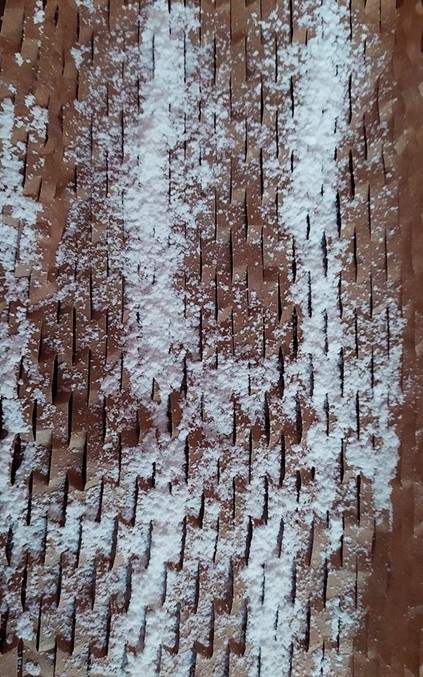
Lines of Growth (2021)
Installation Art, Sugar on Paper
This work, with personal transformation and professional growth as its central themes, is an image of the journey one goes through in one’s career and life. The intricate lines and patterns in the work symbolize the different paths and decisions that shape an individual’s career path. The use of abstract forms and lines also speaks to the unique and individual nature of each person’s journey. The lines, which vary in thickness and direction, reflect the different experiences and challenges encountered along the way. Some lines are straight, indicating moments of clarity and decisive action that lead to significant progress. Others are thin and winding, representing uncertainties and obstacles that one must overcome. The transitions between sections of the work, where the lines evolve, mark key moments of transformation. These moments may include the achievement of a long-sought goal, the overcoming of a major challenge, or a profound change in perspective. The fluidity of the lines suggests that growth is a continuous and dynamic journey. In essence, this work serves as a visual metaphor for a transformative journey of personal and professional growth. It invites viewers to reflect on their own journeys, to realize the significance of their experiences.

Kind of Blue (2025)
Painting, Acrylic on Paper
This abstract painting in blue shades represents a nostalgic memory of Greece. The work captures the essence of the Mediterranean with its endless shades of blue from the deep sea to the clear sky. The painting embodies the tranquil, almost dreamlike quality of precious memories. To delve deeper into the essence of this painting, it is important to understand the artist’s intent and the emotions conveyed through the use of blue hues. The different shades of blue create a sense of depth and movement, inviting the viewer to immerse themselves in the painting and experience the beauty and serenity of the Mediterranean. The artist’s use of blue shades is a deliberate choice to evoke memories of peaceful moments spent by the sea. These memories are often tinged with a sense of longing for simpler times, when the worries of the world seemed far away, and the only thing that mattered was the present moment.
Curatorial Review
Moments in Monochrome (2021), sugar has been transformed into an art medium, which is contrasted by the black background. The sugar symbolises the sweet fleeting moments while also a symbol of light against the dark (black background) in the work. The black background contrasts with the sugar, pushing a more existentialistic concept to the artwork. Sugar dissolves in water quickly, and its effects on our bodies are quick- which, within the artwork, invites the viewer to savour life’s moments that don’t last long…
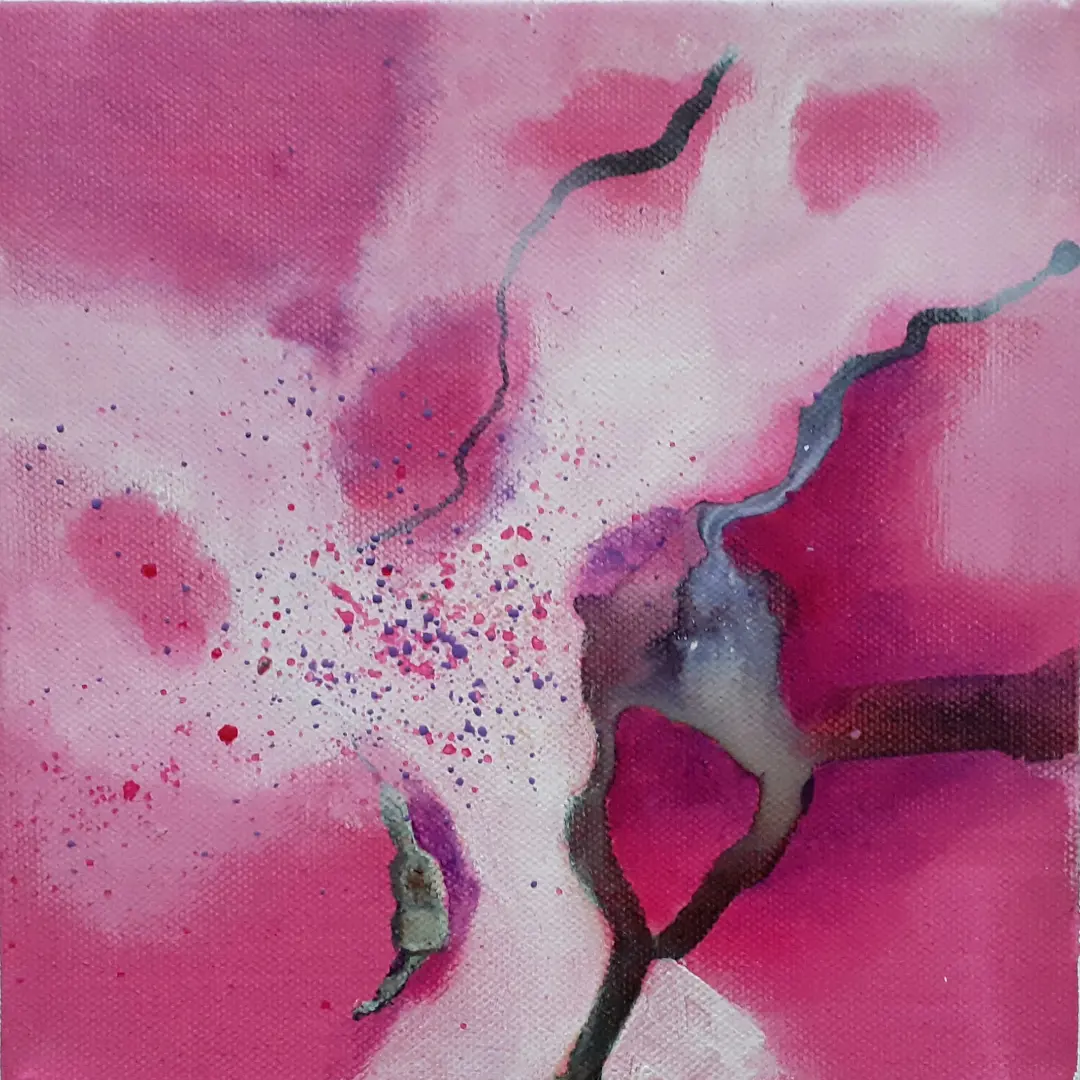
GERALDINE LEAHY
Concerned with the exigent and immediate issues of climate change, my practice focuses on coastal erosion and involves an awareness of the entanglement of natural and manufactured debris on the beach. As I walk the coastline I investigate residual marks in the littoral environment following severe weather events. A sense of local memory, embedded and submerged, resurfaces and is exposed in personal belongings as the terrain disintegrates and dwellings subside. Fragments of crockery and broken bottles jut out of the sand. Walking is interrupted by tilting fence posts and scattered fragments of corroding metal. Coils of wire, flex cable, netting and splintered wooden planks lie in the sand. These items linger on the beach, traces and imprints of the processes of a changing climate. It is disquieting to consider how long it took this tenuous landscape to form and yet how relatively quickly it can be destroyed.
As I walk the coastline I become increasingly aware of the entanglements of the natural and the manmade – the pernicious inseparability of materials such as plastic and seaweed, wire and grass. Natural and manufactured materials are similarly embedded in the sand and can be difficult to distinguish. My approach involves working with layered processes that reflect the mutability and fragile beauty of a littoral environment under threat. My use of shoreline debris suggests changes in the environment and encourages reflection on the harmful effects mankind has had on the coastline. Intriguing combinations of monoprint and paint reveal the incongruity of manmade materials which often strangely assume the appearance of organic forms throughout the painting process. These forms mutate into evocations of the catastrophic entanglement of mankind and the natural world.
Artworks

Found Wire (2022)
Acrylic inks, acrylic & gouache
Acrylic inks flow and merge into representations of fragments of found wire. The pink tubing around the wire has broken up and is dispersed into the environment.
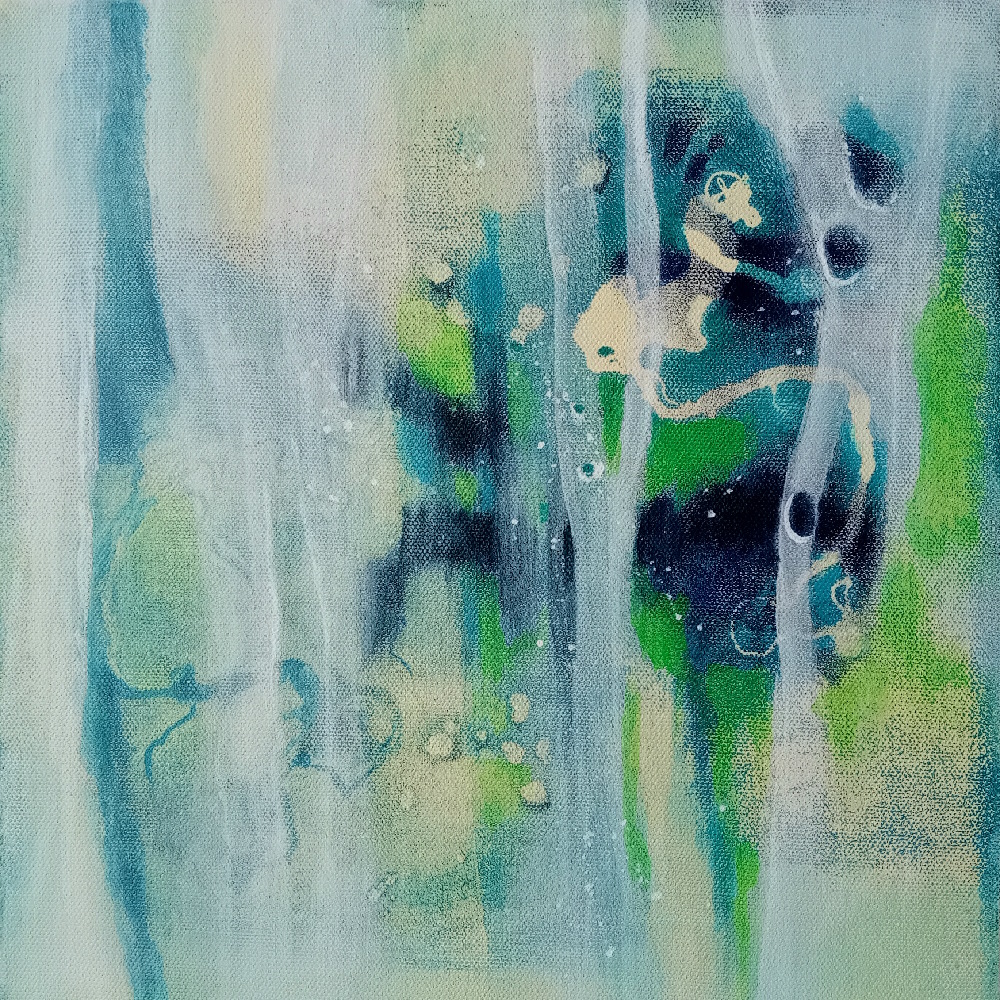
Manufactured Seahorse (Found Rope) (2024)
Monoprint, acrylic & gouache
A length of found rope has undergone an ironic transformation during the painting process and now resembles a seahorse, creating a sense of confusion as to what is natural and what is manmade on the coastline.
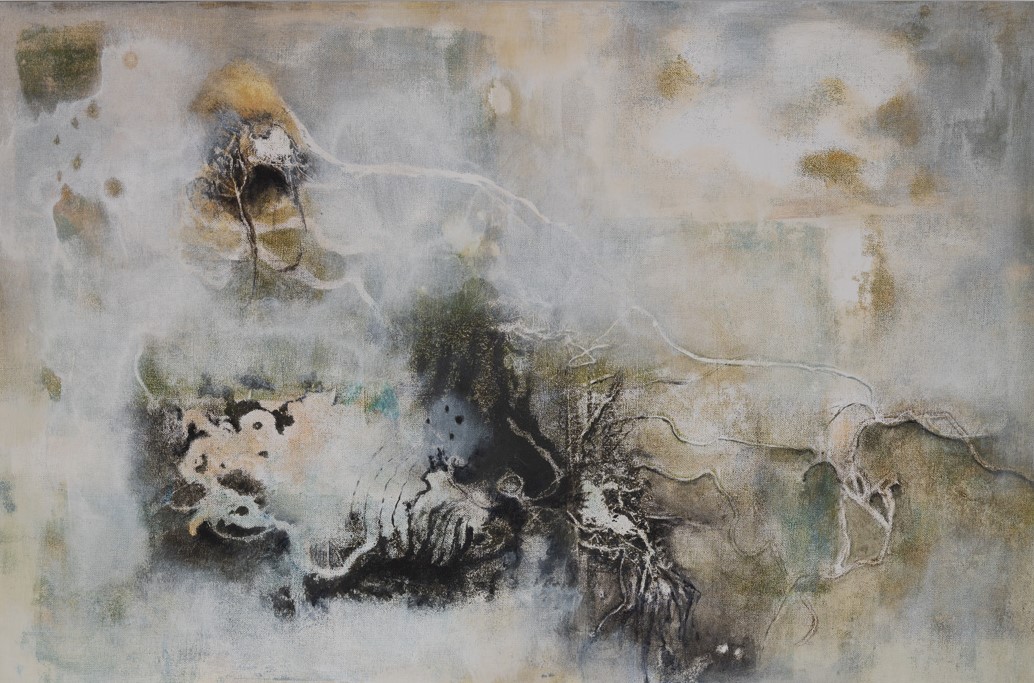
Expired (2021)
Monoprint, acrylic & gouache
Monoprinted plastic debris has assumed the appearance of dead or dying fish during the painting process, signifying the dangers of plastic to marine life.
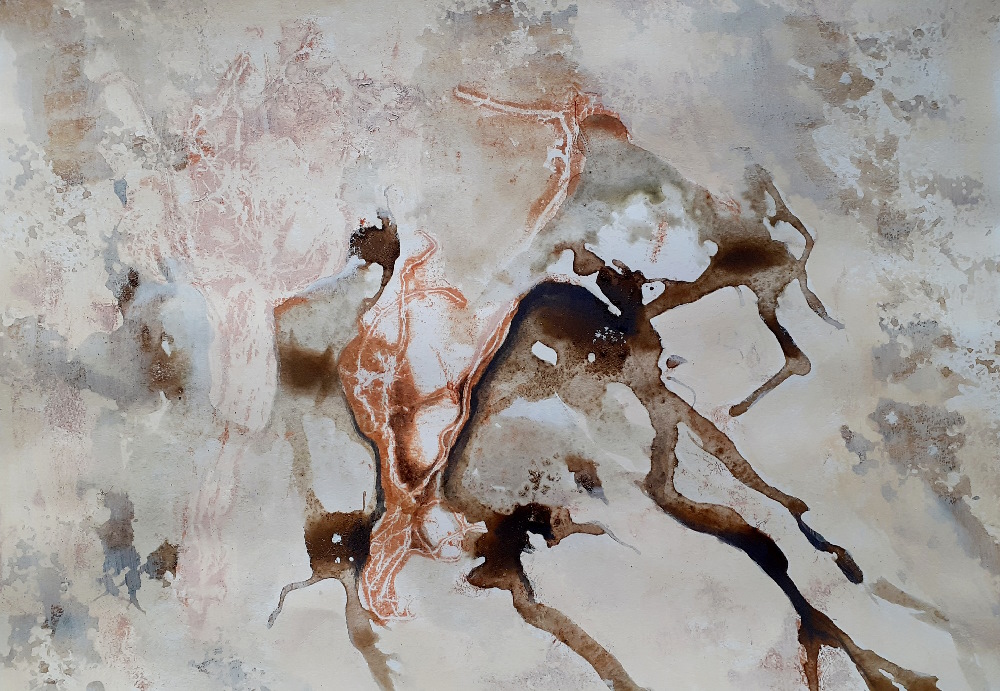
Flow (2020)
Monoprint, acrylic, sand & gouache
Monoprinted found debris has been covered with paint, then partially washed away, referencing coastal erosion. Sand added to brown pigment flows diagonally across the surface, signifying polluted waterways.
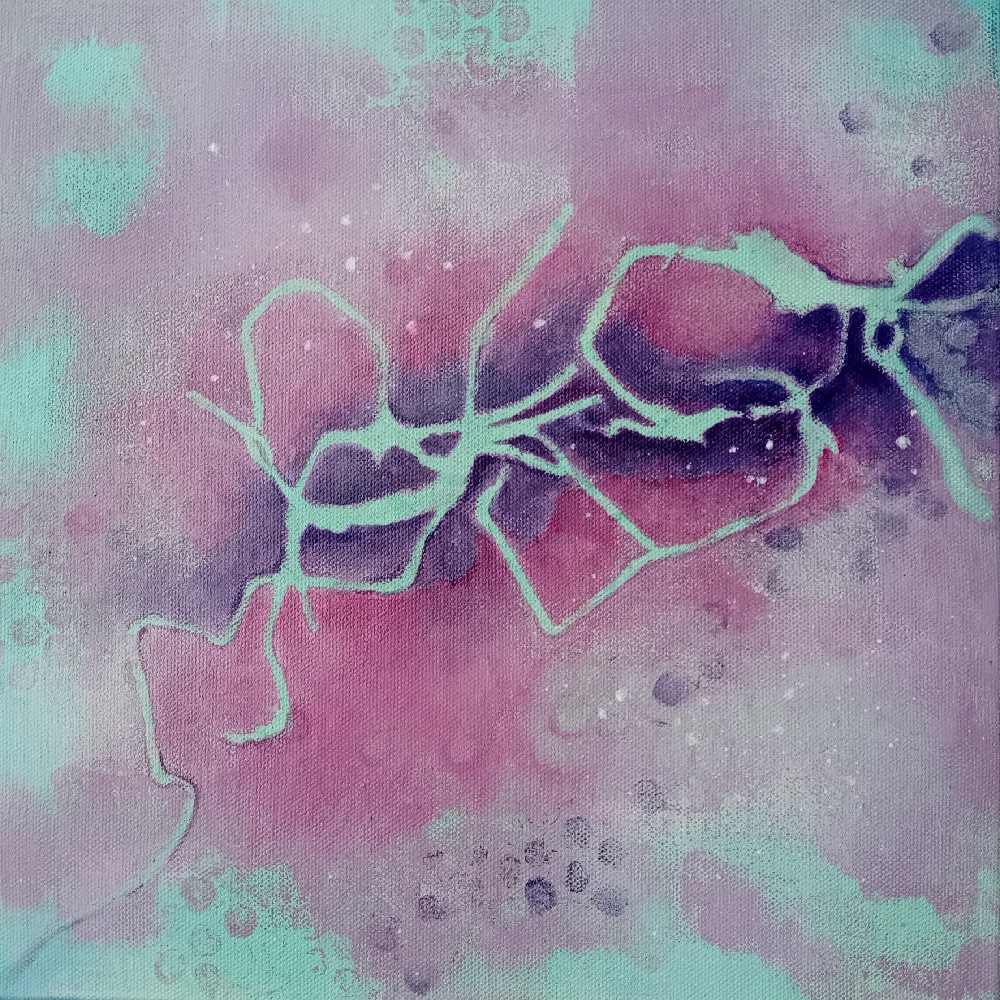
Plastic Dispersion (2024)
Monoprint, acrylic & gouache
Found plastic strands are breaking up and dispersing into their surroundings, creating havoc for the environment.
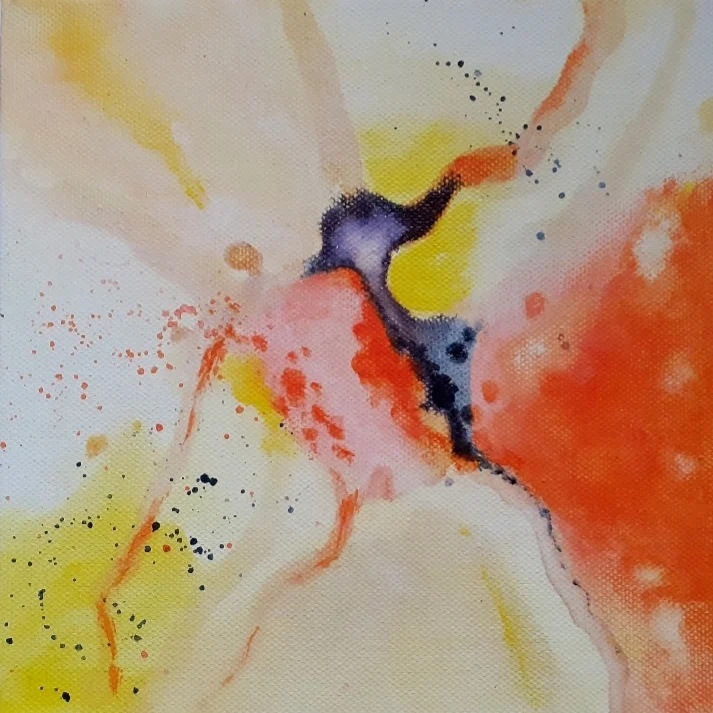
Natural or Synthetic? (i) (2022)
Acrylic inks, acrylic & gouache
Acrylic inks flow and merge on the canvas revealing forms which could be either natural organisms or manmade pollutants.
Curatorial Review
Found Wire (2022) is vibrantly pink which is separated with darker vein-like forms which may be the fragments of the wire. The dark lines from this spread through the softer colours of the pink as though they are invading the space. There are speckles of pigment, especially within the central area of the composition, which mirrors the scattering of broken fragments and litter in the environment…
Interview
What initially inspired or influenced you to focus on coastal erosion and climate change in your art practice?
I’ve always been inspired by landscape and the natural world and I brought these concerns into my work when I began my studies for a BA (Hons) in Painting. In Year Two of my degree, I carried out a parallel project on the subject of coastal erosion on one of my local beaches where several severe weather events had resulted in a considerable loss of dunes, posing a danger to coastal structures. During Year Three, when I was free to choose my own subject for my Major Project, I returned to the same beach and continued the work, developing new ideas and processes. My work is situated locally, yet its concerns are universal. The Covid pandemic struck as I began this project and it quickly threw into relief the many environmental problems facing the world today and the urgency with which they need to be addressed.
Can you describe your process of collecting materials and how they influence your compositions?
When my Major Project began in September 2019, initial visits to the beach revealed a surfeit of both natural debris and manmade objects embedded in the sand following severe weather events. I observed with interest not only the quantity, but also the entanglement of these materials and they quickly became the focus of my work. I engage in regular sketching on the beach, recording debris that is firmly embedded in the sand and too large to extract. I collect small scale items for use in my studio. These include lengths of plastic, rope and wire and small pieces of netting. Influenced by Jane Bennett’s Vibrant Matter: A Political Ecology of Things (2010), I regard this debris as possessing a kind of energy that informs both artist and viewer about the catastrophic state of the coastal environment.
Are there any challenges you face when working with found debris? How do you integrate these materials into your work?
I am obviously limited to working directly with small scale items as larger debris cannot be extracted from the sand. However, the larger items which I sketch and/or photograph also often influence my final pieces regarding composition and colour. I use a simple gel plate printing technique to create monoprints of small materials such as plastic strands and lengths of rope directly onto the painting surface. In this way, the material is visually embedded into the painting surface, referencing the way it is similarly embedded in the sand on the beach. Subsequent layers of acrylic and gouache are added and partially erased, which describes the erosive action of wind and water.
What role do you believe artists have in raising awareness about climate and environmental issues?
In his book, Art Since 1989 (2015), Kelly Grovier makes the point that great art is inspired by the particular age that triggered it and that a provocative piece of art has the power to influence the viewer in ways that other documentation cannot. Whilst Grovier was referring to the era following the fall of the Berlin Wall in 1989, his statement resonates with a sense of urgency today. Climate change has become a persistent and pressing subject for today’s artists who are trying to change the hearts and minds of viewers with their thought-provoking work. Their role is a vital one as they draw attention to those corporations who have, uppermost in their minds, financial profit at the expense of the environment.
British artist, Emma Stibbon RA is an example of an artist who works tirelessly on environmental issues. She conducts much of her research in the world’s polar and alpine regions where she witnesses landscapes that are immense in scale yet precariously at the mercy of a changing climate. Bernadette Kiely’s work, on the other hand, is located much closer to home, although it is also influenced by global weather events. Her practice involves the acute observation of varying weather and atmospheric conditions on water, including fog, mist, and flooding. Much of her work is inspired by the River Nore near Thomastown. County Kilkenny, where she lives and has her studio. These are just two examples of the many environmental artists working in diverse ways today who are highlighting climate change concerns.
What reaction do you hope viewers will have when engaging with your work?
I try to have an element of intrigue in my work, so that the viewer has to really look and think about what they see. For instance, in my painting Expired (2021) the viewer might wonder about the significance of the title and how it relates to the image. They might also be intrigued by the fact that monoprinted plastic strands have adopted an organic appearance during the painting process and now resemble dead or dying fish – an ironic confirmation of the effects mankind has had on the coastal environment.
In Found Wire (2022) was there a particular event or observation that directly influenced the creation of the work? Also, what was the process behind the creation of this work?
Found Wire was influenced by the overabundance on the beach of short lengths of wire encased in coloured tubing (in this case, pink). Based on the found wire and some of my sketches, I dropped acrylic inks onto the canvas and let them flow into distorted wire-like shapes. The pink background describes the colour of the tubing while the spattering reflects the fact that this intrusive manmade item is being gradually disseminated into the environment. Pink is regarded as a pretty colour and my aim was to create a painting that is ostensibly quite attractive. This would draw the viewers in and encourage them to look closely until they come to realise that the prettiness is counteracted by an ominous element.
Going further, how do you choose the specific technique – monoprinting, painting and layering that expresses the artwork best for each individual project?
I use monoprinting for small, flat materials such as plastic and thin strands of rope. This technique visually embeds the material into the painting surface. I generally use canvas board which is strong enough to withstand a lot of scraping and wiping away of subsequent layers. Items such as wire cannot always be monoprinted successfully (although I have managed to do so occasionally), which is why I used the acrylic inks and dropper for Found Wire.
Do you have any projects coming up that you’d like to share and where do you see your art in coming years?
I have often considered how some small sections of a painting, taken on their own, can change the narrative of the overall piece and how these would make interesting compositions in themselves. Changing the scale could produce some interesting results, too. I am planning on repainting details of some of my paintings as a series of new works. This would increase the abstract element of the artwork which I hope will make it more intriguing.
In future work I am also interested in delving further into the found materials – I am hoping to hone in on tiny details, perhaps viewed under a microscope, to really get inside the materials. I think this will make the work even more intriguing as materials become harder to identify and their appearance becomes seemingly more innocuous and, perhaps, even beautiful. This will increase the sense of irony associated with manmade materials and how they have become entangled with organic matter to the point of being indistinguishable.
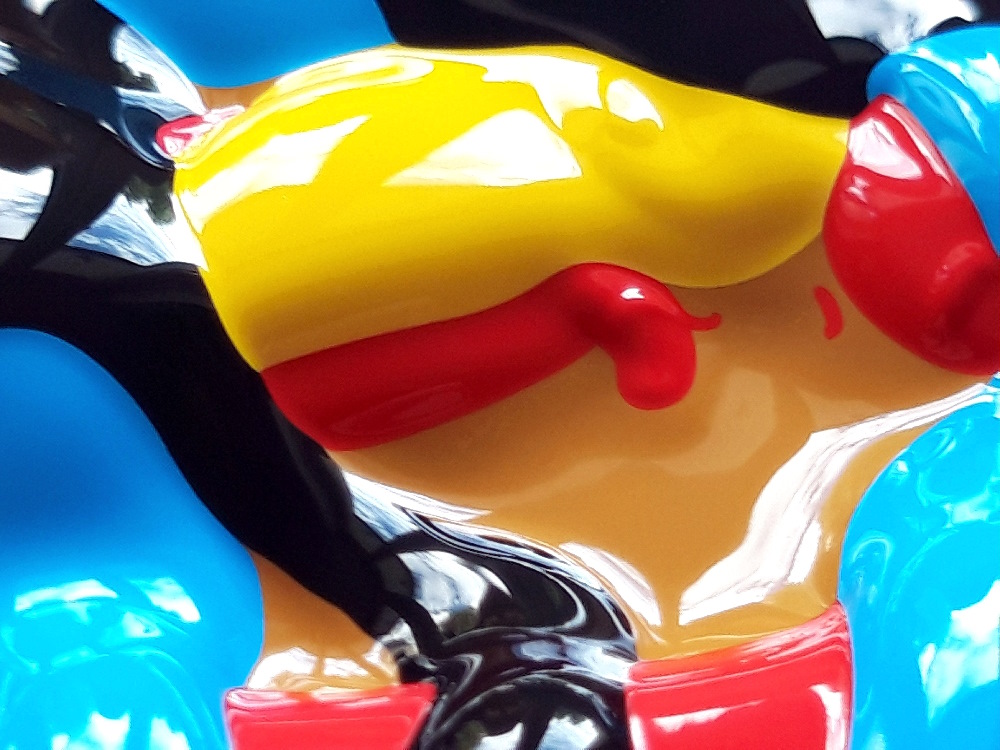
MICHAEL WAGNER
For me, photography is a means of poetic expression. I am interested in images that reveal something that goes beyond everyday experience. Images that raise questions instead of providing answers. And images whose appearance evokes a meditative gaze rather than rationality. I like to use photography as an experimental medium. My aim here is not to depict, but to visualize. In this way, I mainly make use of macro photography, motion blur and double exposure. These photographic means promote the ambiguity, the complexity of my work. Basically, I am interested in the open picture, in a creative approach whose aim is to create content that gives the viewer considerable scope for interpretation. This leeway is, so to speak, part of the creative process. This results in photographs that are ambiguous in a certain way and yet have a firm character and suggest a clear goal.
Artworks
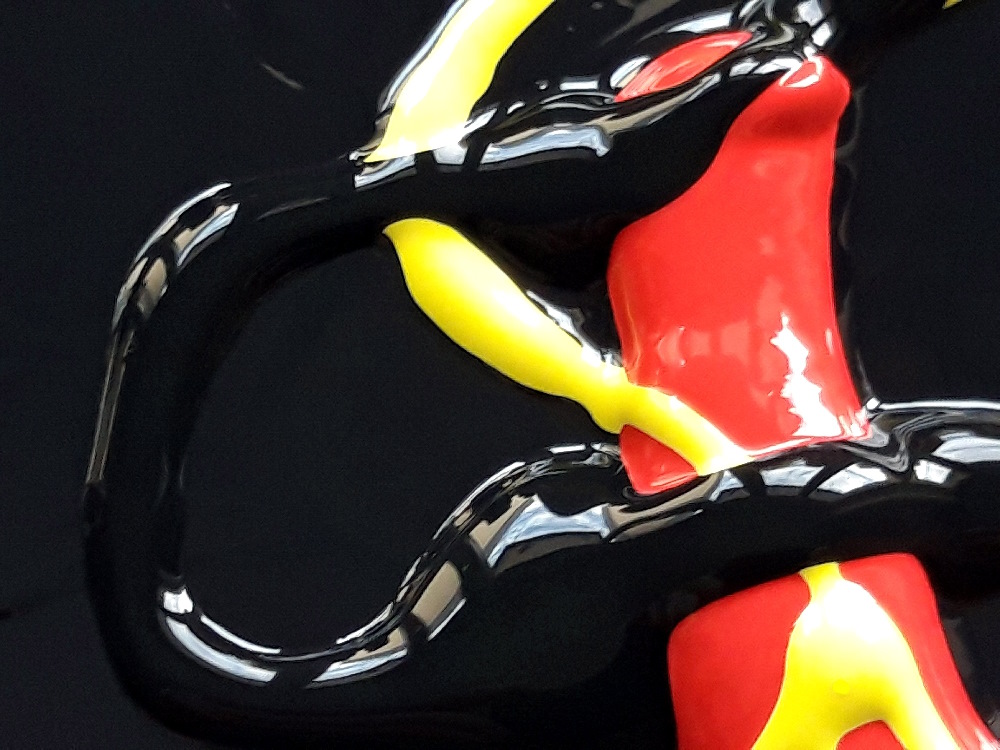
Tales of colours and imagination (Gym) (2024)
Photography
Representation of the interaction of colours in an environment that is unique to them.

Tales of colours and imagination (Showcase) (2024)
Photography
Representation of the interaction of colours in an environment that is unique to them.
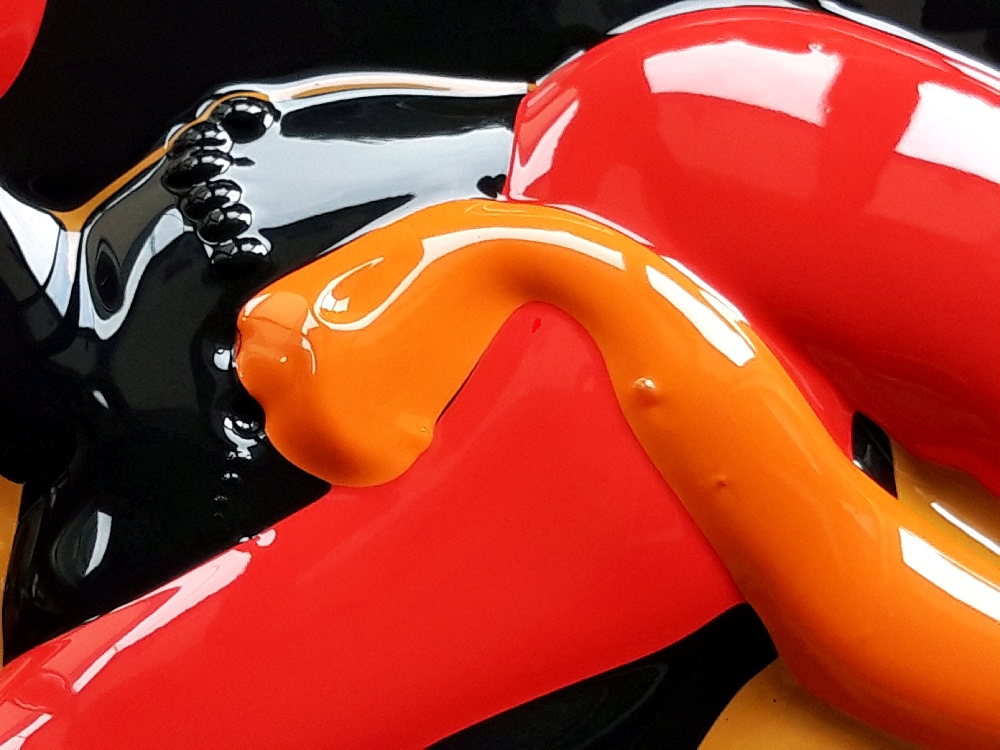
Tales of colours and imagination (Monument) (2024)
Photography
Representation of the interaction of colours in an environment that is unique to them.
Curatorial Review
Tales of Colours and Imagination (Gym) (2024) is an abstract photograph which takes the viewer into a dance of colours. These colours contrast incredibly well against the black background and are extremely glossy, which helps to take the viewer’s eyes and guide them across the colours. The use of macro photography here takes the viewer to the glossy texture, which would usually not be noticed from a distance- to take in the way light reacts to the object…
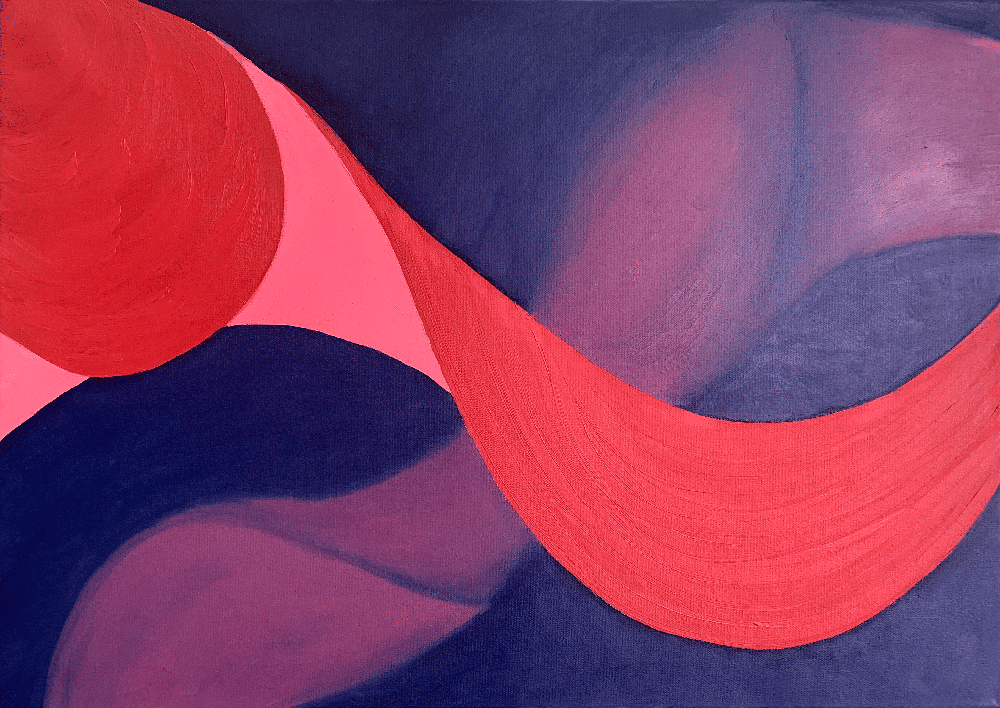
JULIA UTOPLENNIKOVA
My work explores the emotional landscapes of transformation and self-discovery. Through abstract forms and vibrant contrasts, I seek to convey the complexity of human emotions during transitional states.
In my practice, I focus on capturing the ephemeral nature of emotions and the subtle beauty of uncertainty. By immersing viewers in bold colour palettes and dynamic compositions, I invite them to reflect on their personal journeys, navigating the space between stability and transformation.
The concept of Super Contemporary resonates deeply with my art. My work captures the essence of living in the present—where the boundaries of time blur, and personal evolution becomes a reflection of the broader human experience. Each piece is a visual metaphor for resilience, growth, and the beauty of embracing the unknown.
Artworks

Echo of emotions (2022)
Painting
This painting was created on a canvas with oil paints, which lend it a richness of color and depth of texture. At the center of the composition, red and pink flows intertwine with deep shades of violet and dark blue. The movement of the lines and forms evokes a sense of fluidity and tension, as if different energies collide and strive for harmony. The contrast between vibrant and deep tones enhances the drama of the piece, drawing the viewer’s eye and sparking associations with emotional experiences and transitional states.
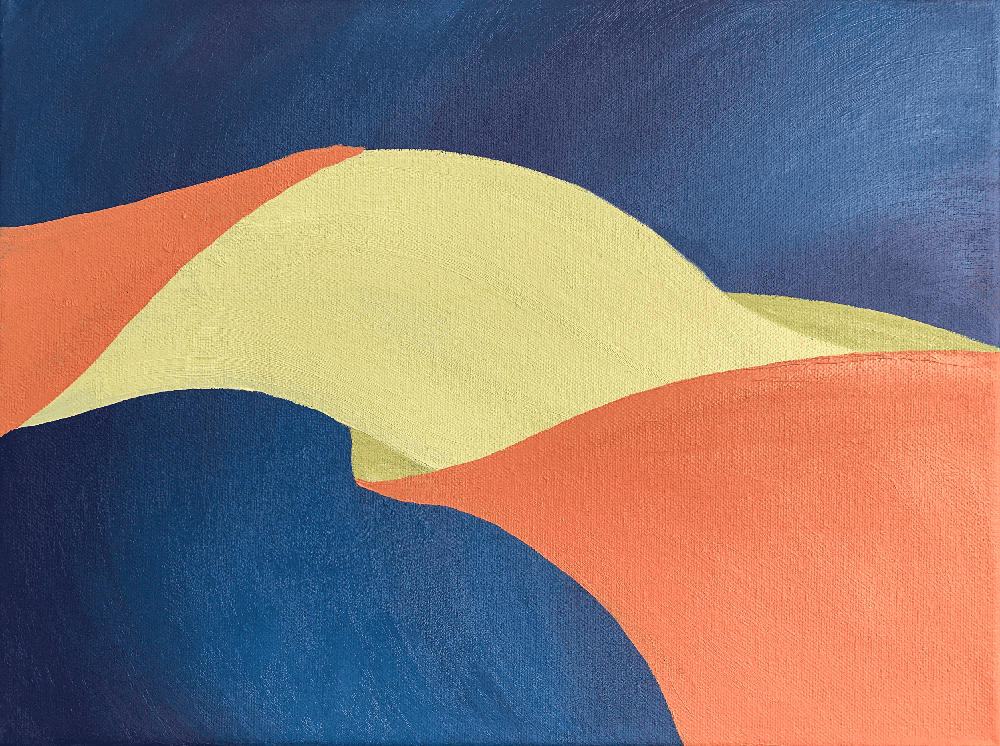
The courage (2022)
Oil Painting
This piece explores the concept of courage as a transformative force. It represents the moment when a person, through bravery, strips away their protective barriers, allowing their most vulnerable and tender aspects to emerge. The act of vulnerability, often seen as a source of weakness, here becomes a powerful expression of inner strength and authenticity. I also used canvas and oil paints.
Curatorial Review
Echo of Emotions (2022) is a very fluid and well composed abstract painting; it features two flowing red lines; one in the foreground and one in the background. They have been contrasted with a dark blue and slightly violet background and the two swirling lines against this creates a rhythm that moves between meditative peace and tension. This relates to the turbulence felt during periods of transition…
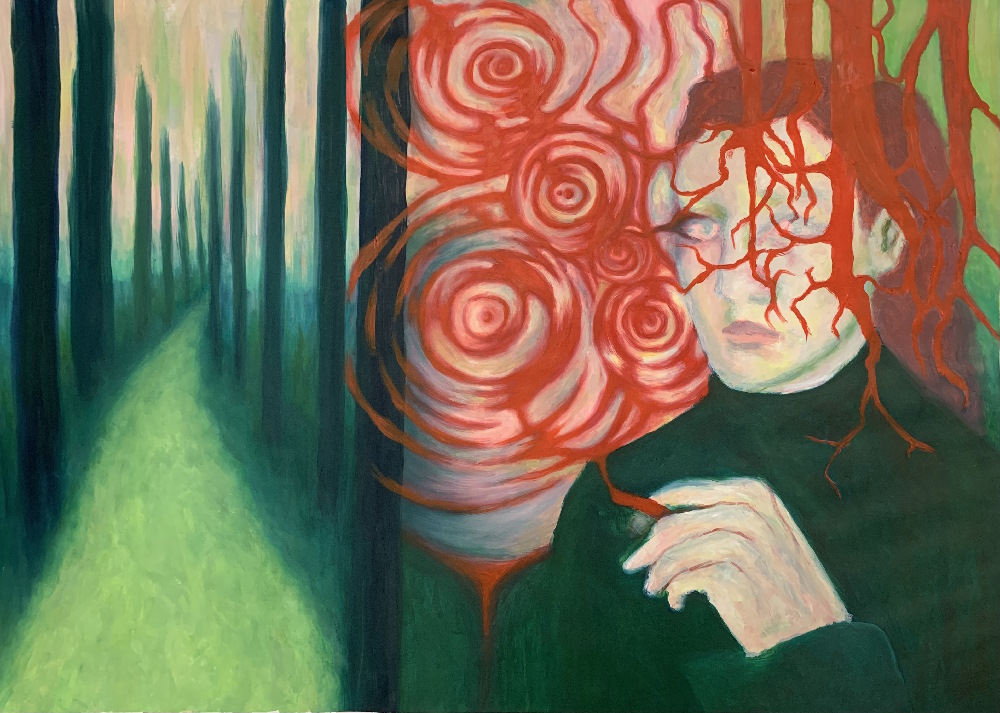
EVE BARTLETT
I am a fine art student studying at Leeds Arts University, currently exploring themes of reflection and introspection through my figurative and landscape paintings, dissecting the beauty of the entanglement of life and celebrating the unity within humanity and nature. Through my work I am continuously investigating how I can represent a true essence of the present and the way in which we experience time as humans. My paintings allow the viewer to ponder the ultimate questions of life.
Why are we here? what is the meaning of life? how do I achieve a fulfilling life? The anxieties that come to an existentialist thinker can be soothed by the interconnectedness and unity of everything and a gratitude towards our being and our surroundings. I am interested in exploring how our fundamental freedom can cause our anxieties, pulling parallels between the entanglement of life and the entanglement of nature. In my paintings I use bright and contrasting yet complementary colours and fluidity to reflect universal human feelings and emotions and an intensity that comes with consciousness.
I intend to bring a sense of movement and journey to my paintings to allow the viewer to reflect on the hidden rhythms of life with clarity in the stillness of the painting. I demonstrate a sense of memory and the universal confusion that comes with our efforts to understand the complexities of life. Motifs and symbolism are an important part of my practise and allow me to visualise complexed theoretical ideas.
Paths are of interest to me and symbolize our human need for direction, clarity, journey, change and reflection. Intertwined bare branches are another key motif which I explore symbolizing the complexed and tangled nature of life, of relationships, of time and memory.
Artworks

Ever growing entanglements (2024)
Oil Paint on Paper
A colourful representation of the experience of time and nature of reflection, intrinsically intertwined with thoughts of the past and the future whilst existing physically in the present.
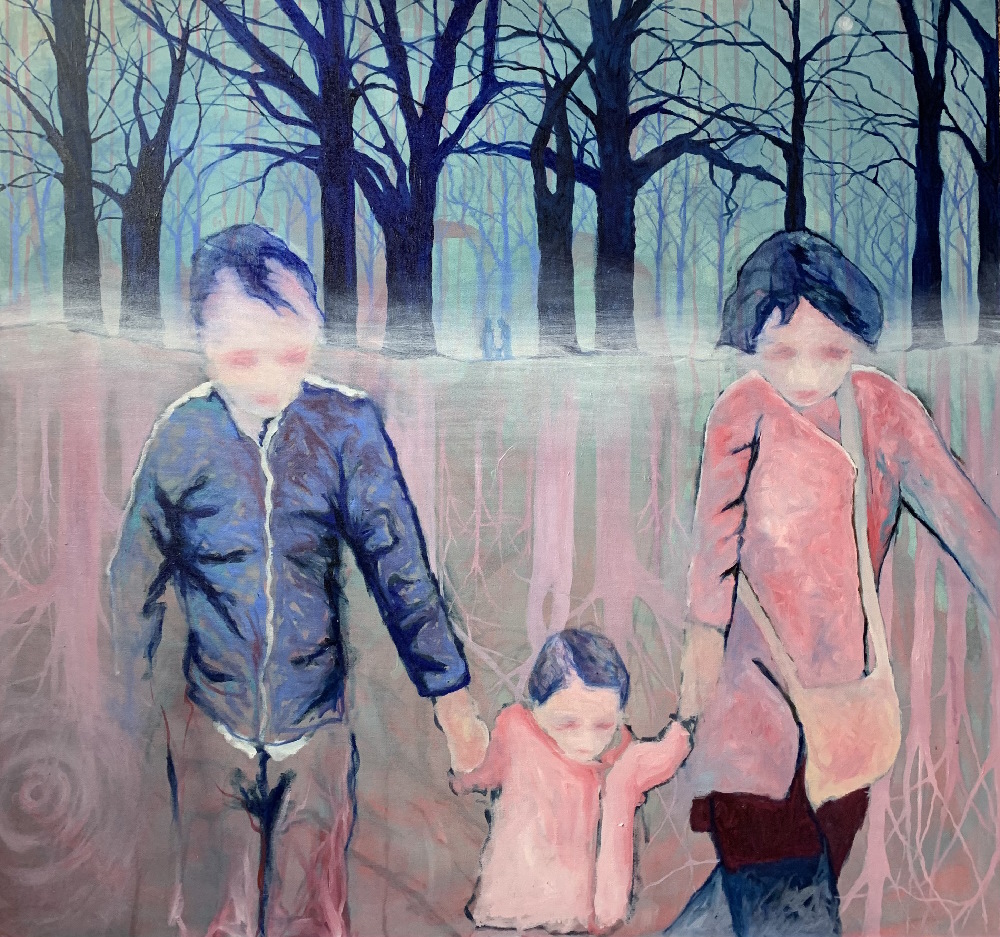
Reflection (2024-25)
Oil on Canvas
A foggy winter scene representing blurring memory, reflection and togetherness as well as journey and never ending cycles. A fading experience of time, mystical and strange, incomplete yet whole, dreamy and pink, fuzzy and untouchable. Merging into one.
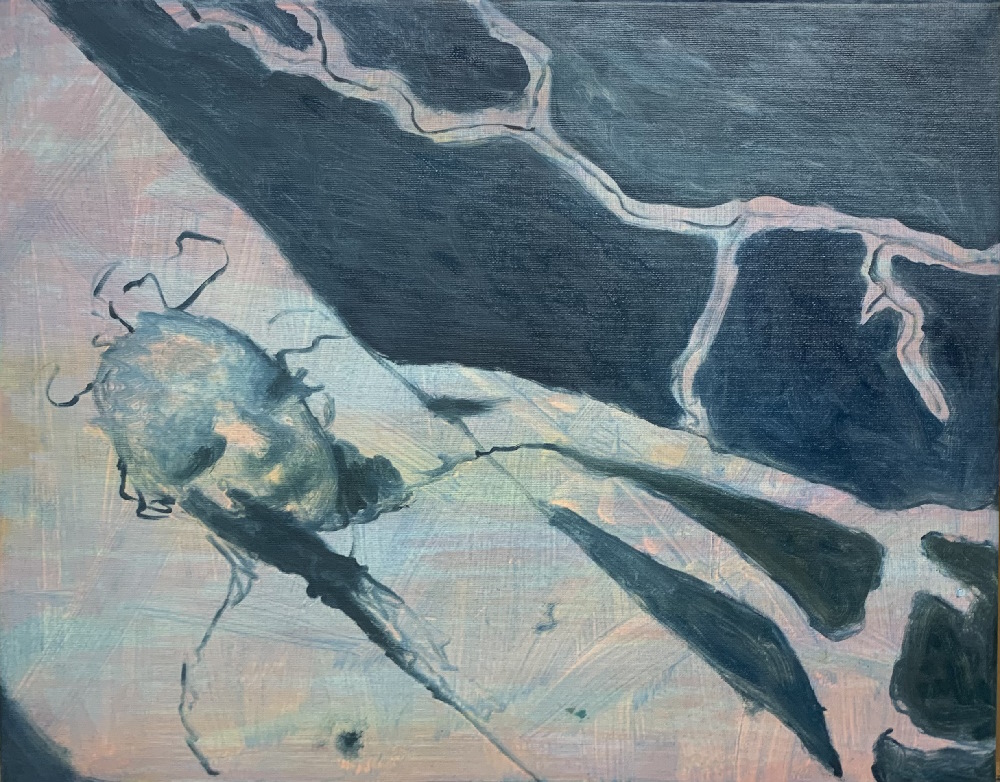
Sinking into one (2024)
Oil on Canvas
A representation of a pensive fragmented dream state in which body parts become ambiguously disjointed and connect to a tree branch like object.
Curatorial Review
Ever Growing Entanglements (2024) combines figurative and landscape elements in a slightly abstracted stylization split into two sections. One section is the forest path, which recedes into the distance, while the right part of the composition has a human figure that seems to be connected to a vein-like structure. The right side is quite chaotic compared to the left; therefore, the painting has balanced peacefulness and chaos- the right seems to steep anxiety while the forest gives calmness and focus. These invite the viewer to see within their minds and the world to separate the anxiety and subdue it with reflection and meditation…
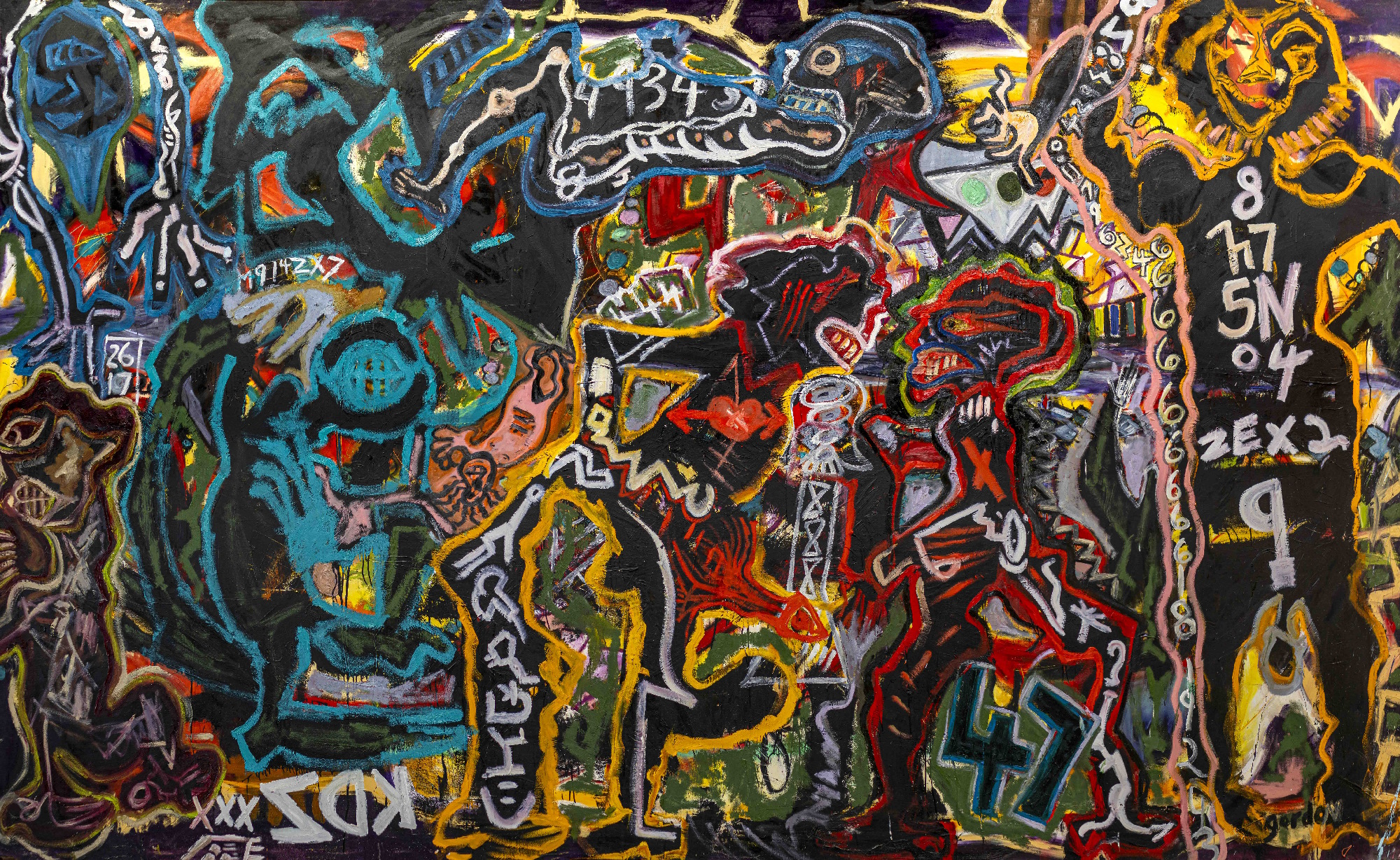
GORDON MASSMAN
I paint exclusively in oil large-scale works in a 4000 square foot studio/gallery built on piers over the Atlantic Ocean as it meets the Gloucester MA commercial harbor. I infuse each paint stroke with a deep obedience to primality uninhibited by any stricture associated with artistic tradition. I say, “there is the paint, the canvas, and the sum-total of your life. Period.” My work prefers no meaningful censorship; I paint as an elemental man whose emotions have no chains. I do not believe in failure because I have no direct antecedents by which to judge. Most assuredly Jackson Pollock, Lee Krasner, and the original abstract expressionists affected me deeply, but I am not derivative of this masterful work. I am a unique psyche which I launch onto the canvas, unduplicable by any other, just as they were. Because I am faithful to my darkest being I am original and unashamed.
My visual art springs from a four decade’s long devotion to poetry. Having published seven volumes—one a collected poems which was nominated for the 2013 Pulitzer Prize in Poetry. During those decades over two hundred journal editors selected my work for publication including Harvard Review, Chelsea, The Georgia Review, The Literary Review, The Antioch Review, Fiddlehead, Malahat Review, to name a few. I transferred my raw emotion to the visual realm after realizing that I had reached my peak as a poet, and after realizing that visual art can be much more immediately impactful than literature. Visual art needs not elite literacy or cerebral processing; it requires a more immediate unfiltered catharsis.
I wish to carry forward through my art the courage displayed by Pollock, Krasner, Rothko, Gorky, de Kooning, Still, Mitchell, Kline, Lewis into the next generation. These painters fill my heart when I paint.
Large-scale (144”x144’ and larger) requires significant expenses in painting materials and studio rental. I hesitate to mention the personal funds I burn through each month. Your largest grant would last me but nine months but how grateful I would be to receive it.
This is an interior version of the exhibition for Gordon Massman’s work as they are large scale works.
Artworks
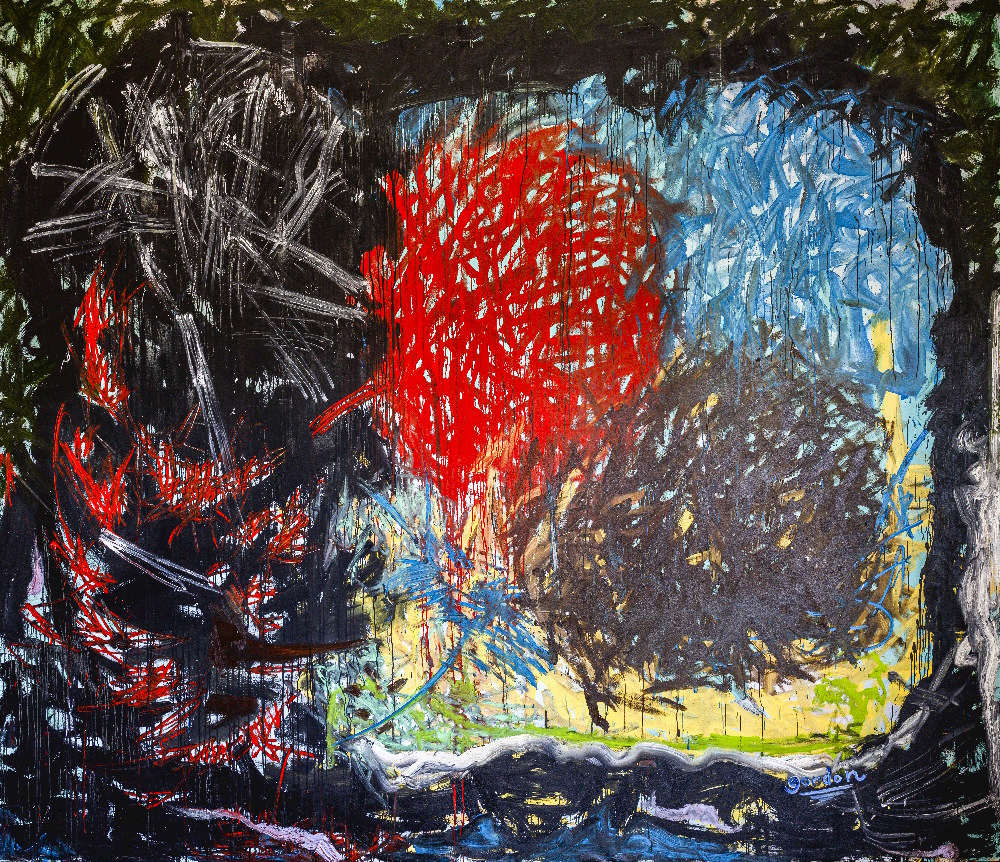
The Eternal ache (2023)
Oil
Claw marks on top left, three large nervous nebulae, black borders. Anxieties, worries, trepidations…

Two Monsters and Their KDZ (2024)
Oil
Two children overpowered by frightening indomitable forces in a real-time confrontation. They will both survive adulthood, create from the hostilities compassionate lives. Friends will love them and marriages bear fruits of contentment.
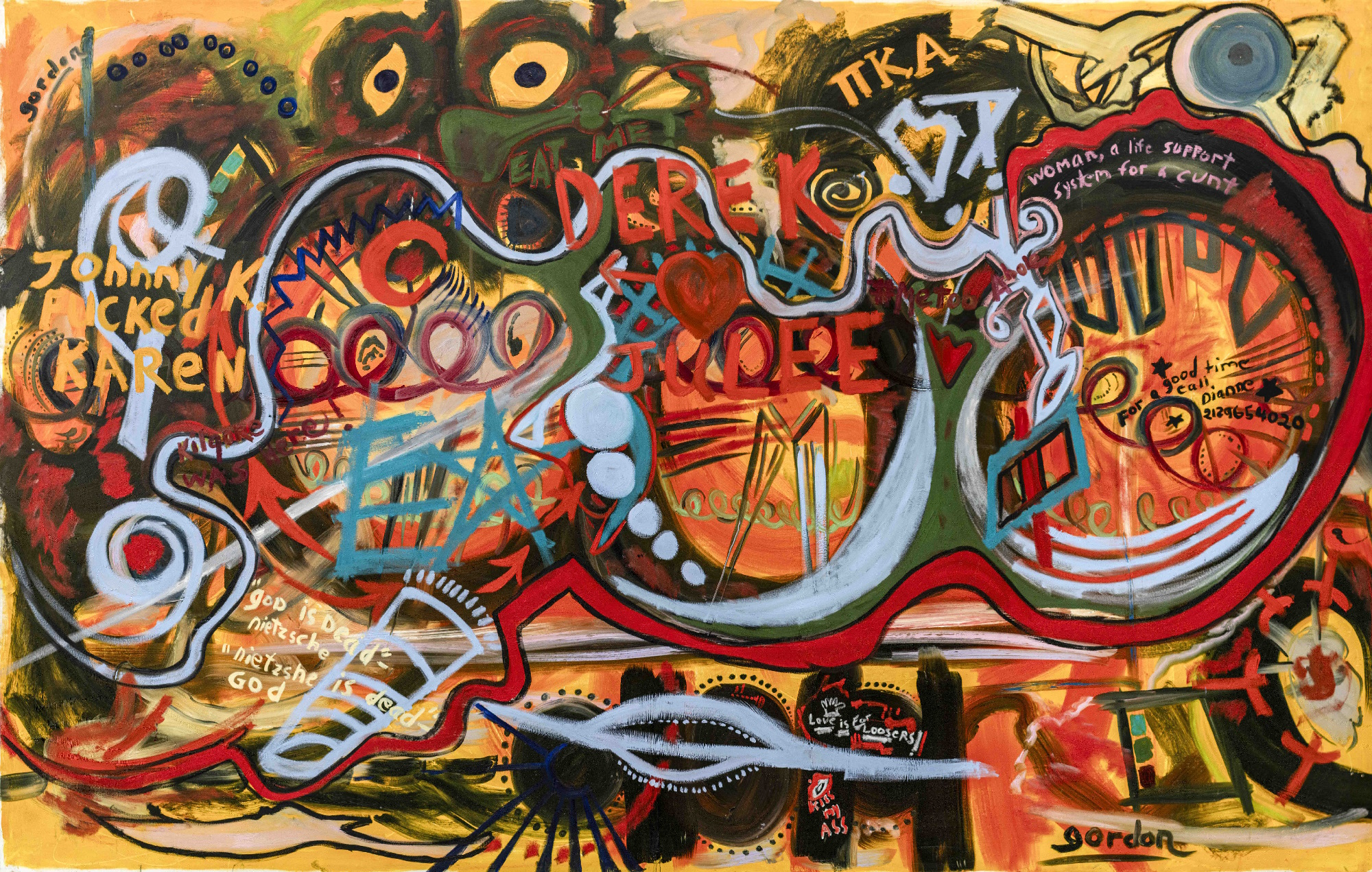
Messages from a Lavatory (2022)
Oil
Ugly largely misogynist graffiti plastered on beer joint wall in Austin Texas, 1969. A mirror to the world of our cruelty and atavistic brutality.
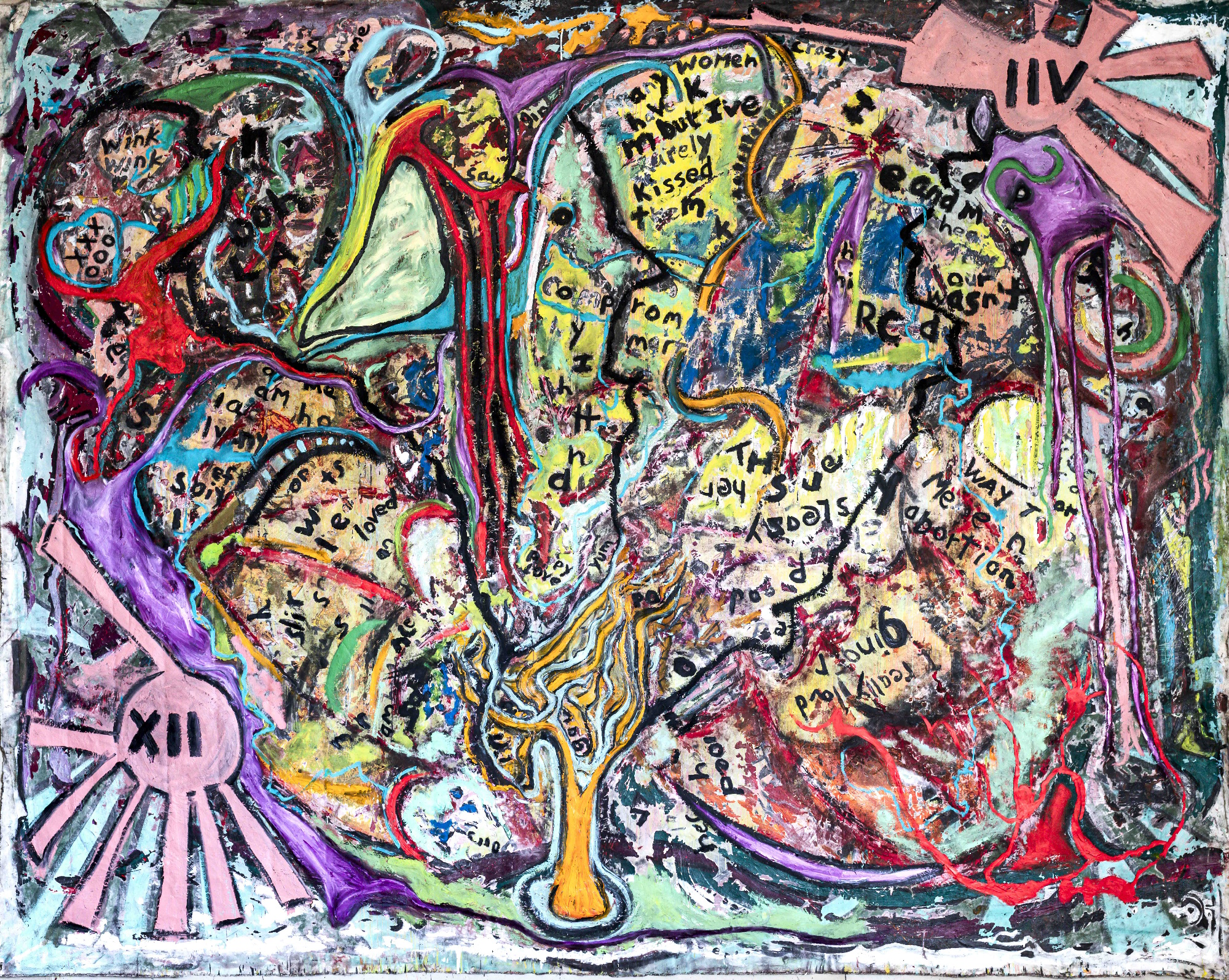
One on Three (2024)
Oil
Addressing the chasm between ideal romantic love an experienced romantic love. Many phrases and half phrases, a riot of images scraped and sanded of earlier application of plaster. No reason, tradition, or meticulousness here–feelings and language extemporaneously applied. I believe in my instincts and intuition when painting.
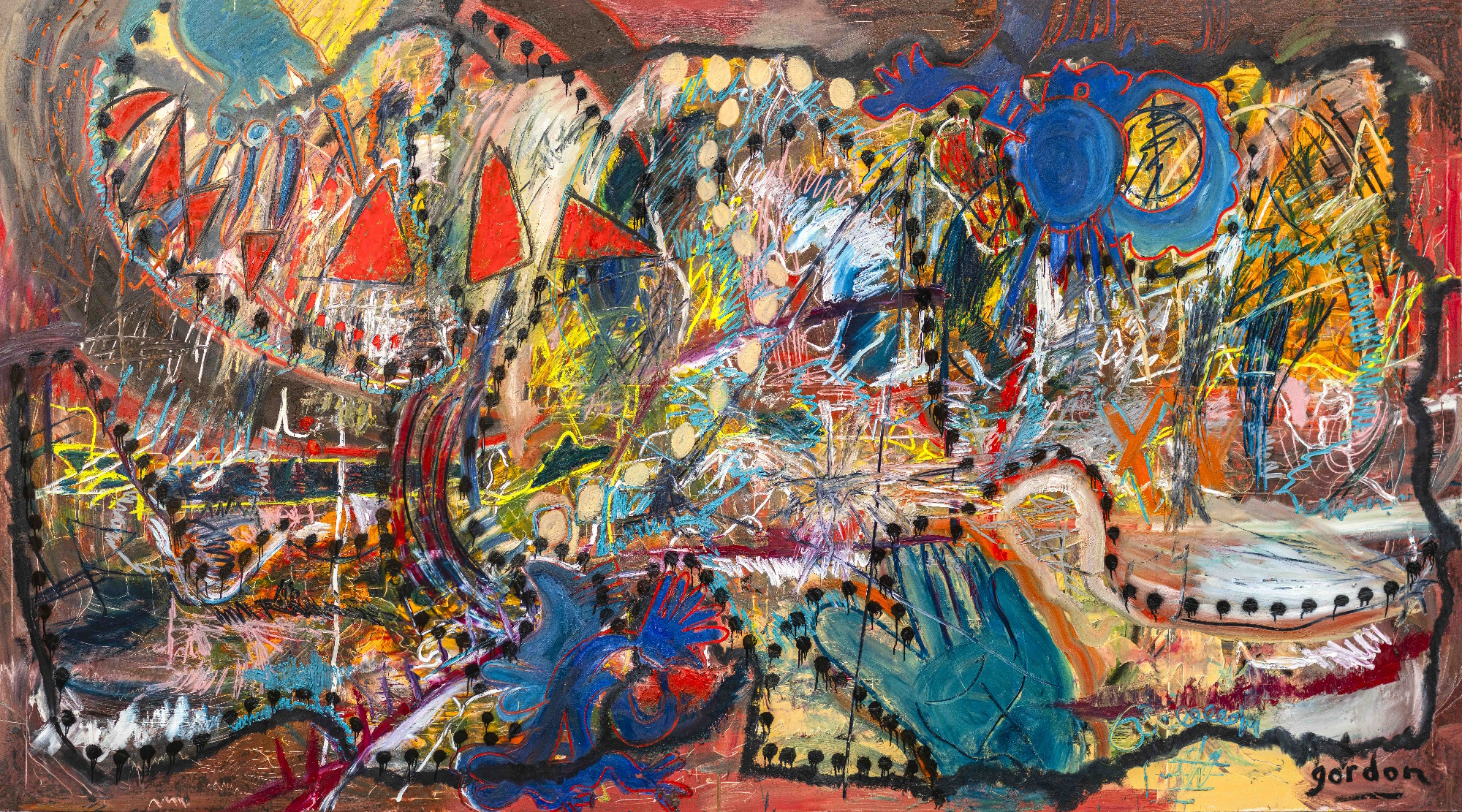
The Disturbed Child’s Playroom Wall
Oil
The family embarrassment locked to the top floor bedroom and attic. Here we see the scratched and tortured wall of her playroom. Autistic? Manic-depressive? OCD? Schizophrenia? Or maybe just victim of ashamed socialites.
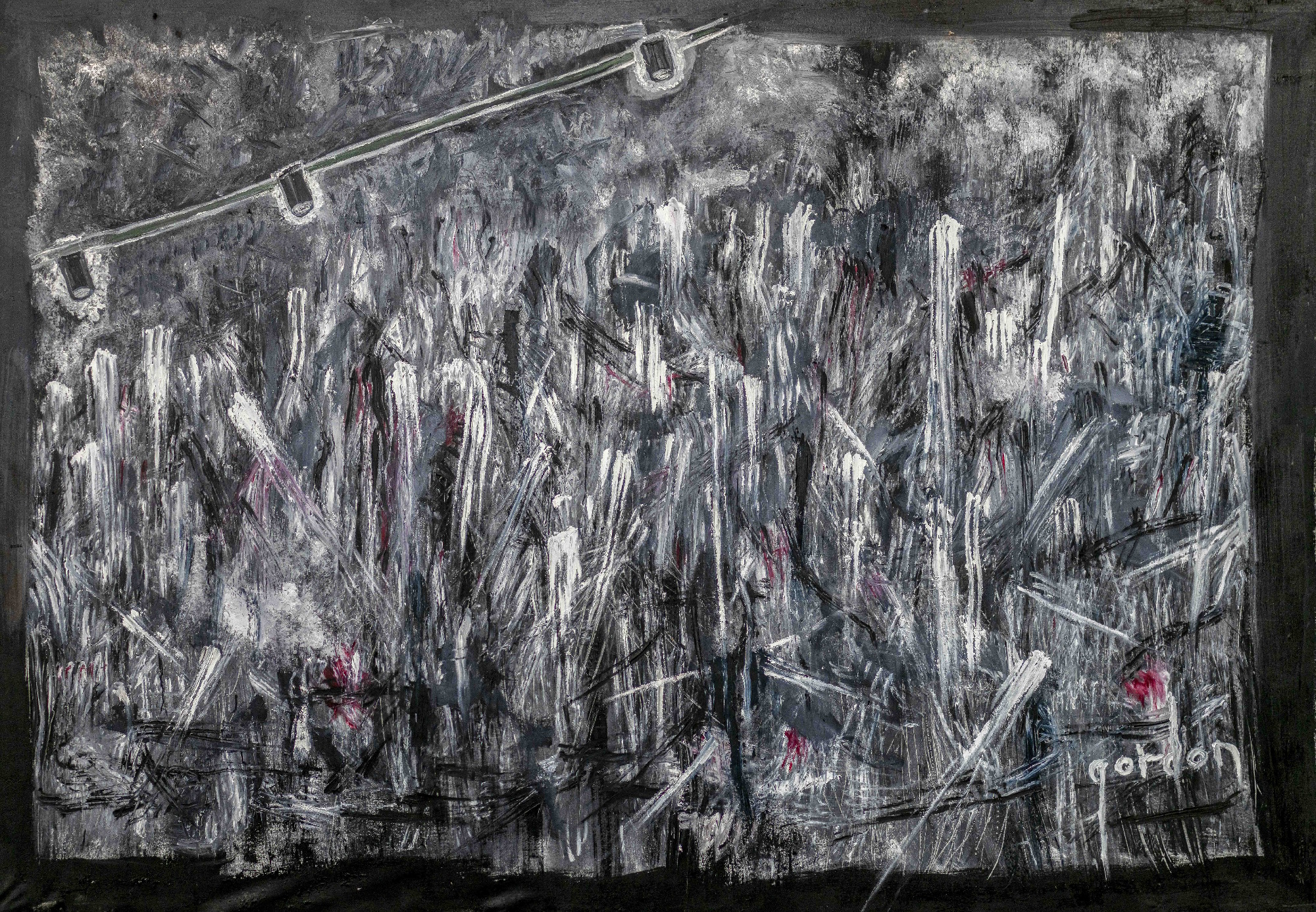
The Wall They Clawed (2023)
Oil
Rendition of a photograph taken during the liberation of the Auschwitz Concentration Camp. I tore fingernails and bloodied knuckles painting this image. The canisters are full of Zyklon Gas.

Humans Melting Left to Right (2024)
Oil
Both a political statement (the disintegration of humanity as fascism overtakes liberal democracy) or the record of the life course from youth to age. Very hard to see on small screens.
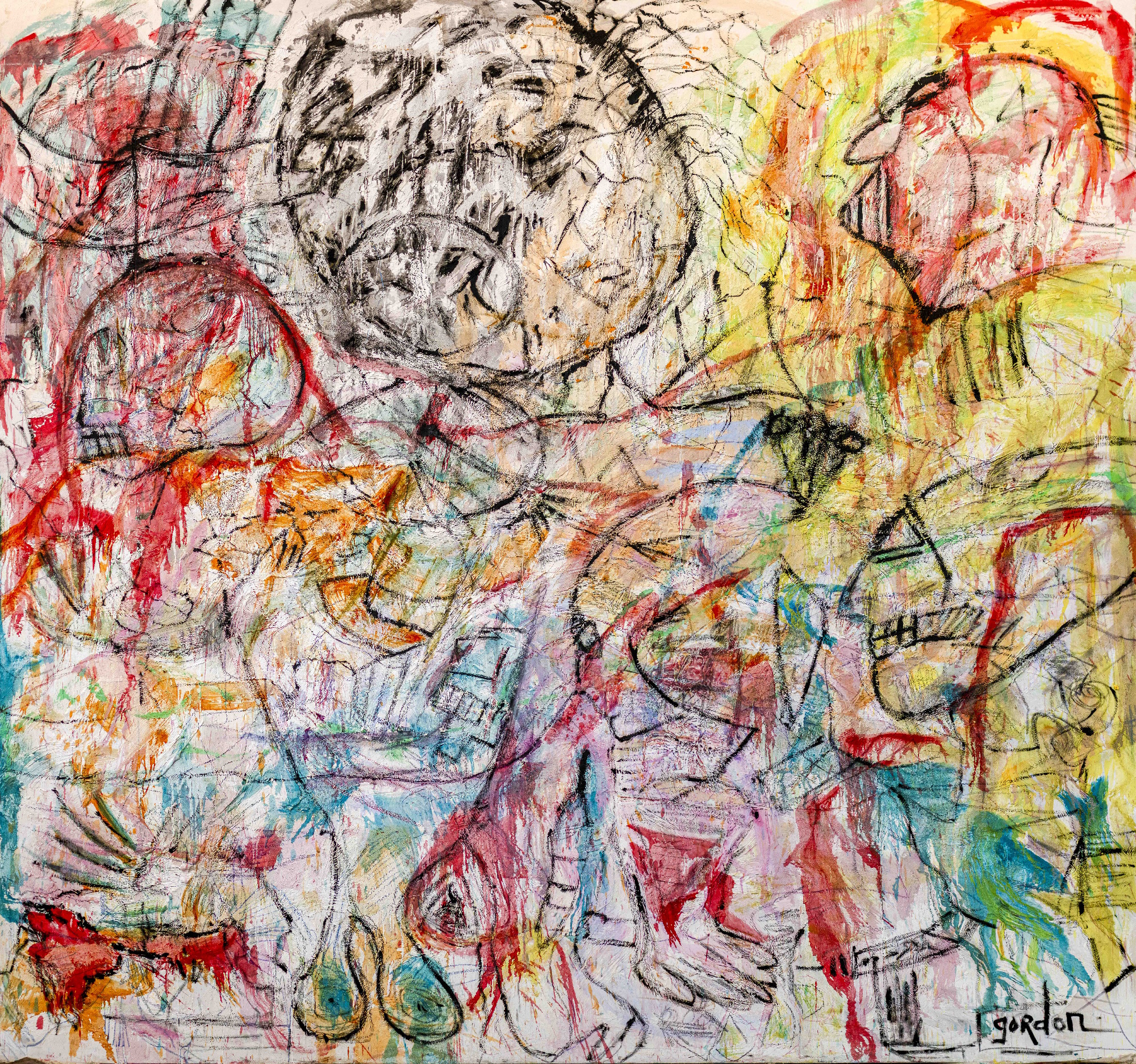
The Dubious Angel (2024)
Oil
An angel trying but failing to save humanity from itself. Many ghostly faces in this painting, each expressing elemental feelings.
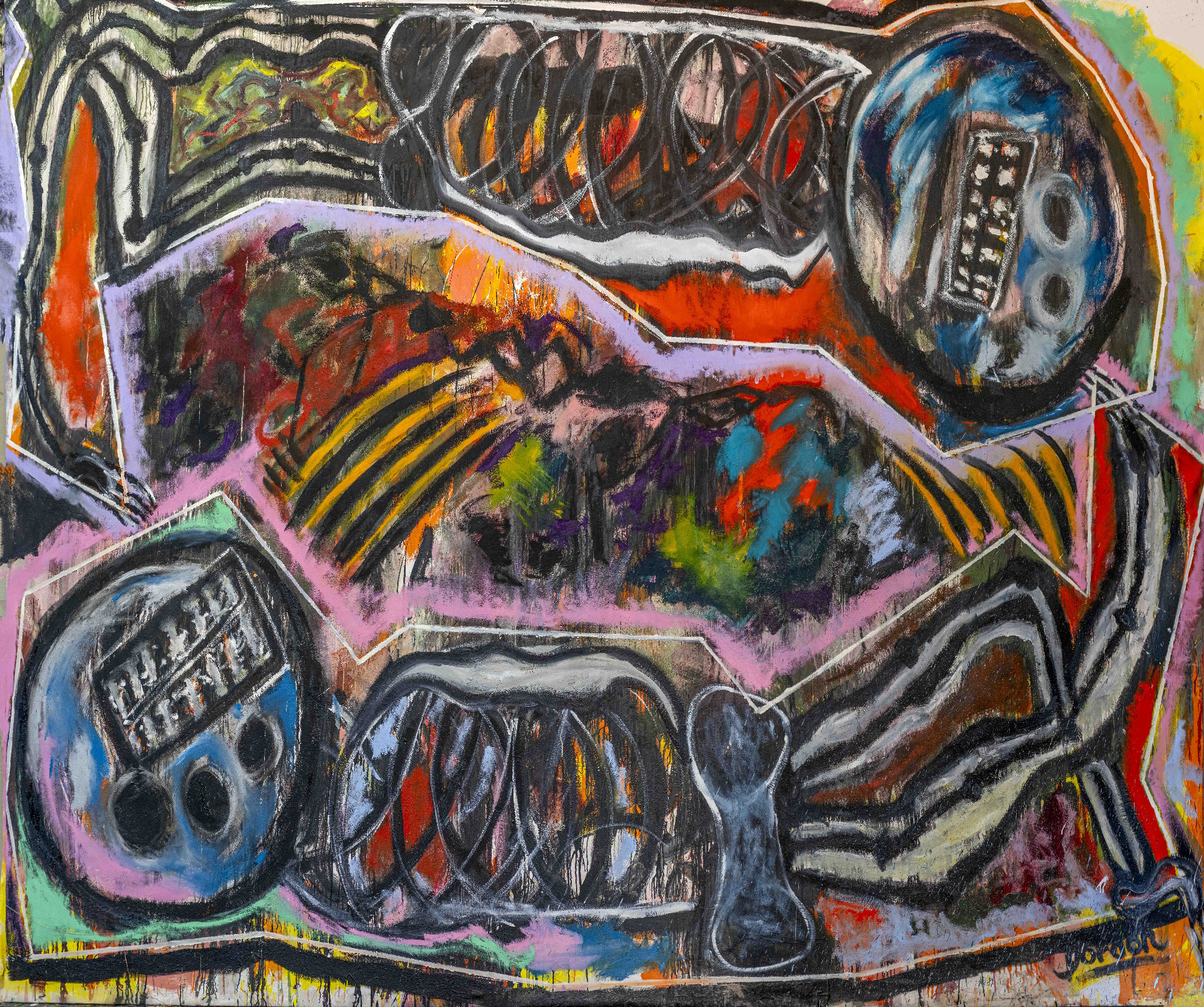
The End of a Great Marriage (2024)
Oil
These two skeletons buried atop each other enjoyed 62 wonderful years of vibrancy, sexuality, joy, friendships, lover’s spats, movies, conversations, tragedies. They produced two quirky headstrong children.
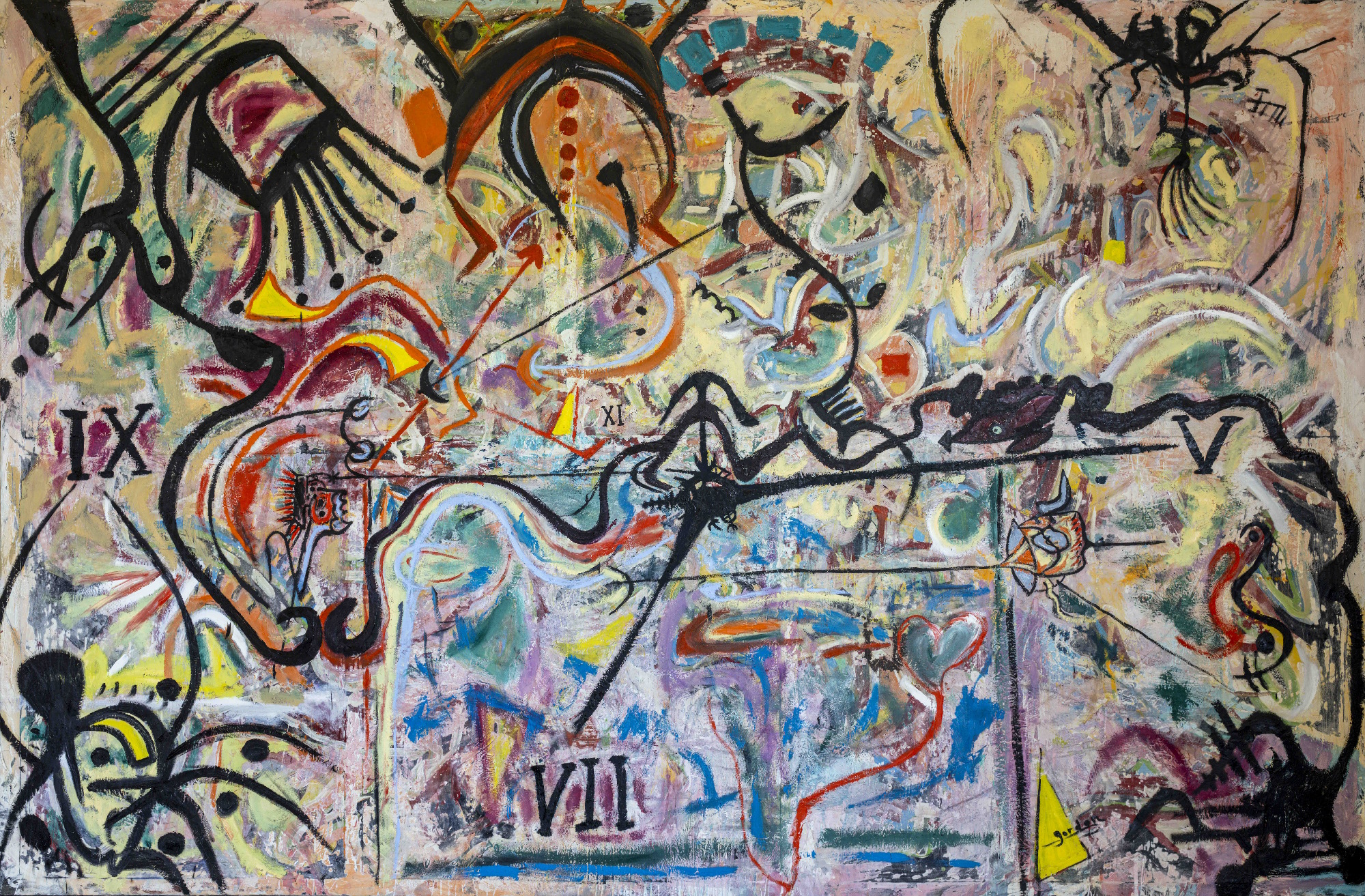
Orbiting Neptune (2024)
Oil
Clock hands, Roman numerals, creatures, blended colors, spontaneous strokes and slashes from the subconscious tempered in lived experience.
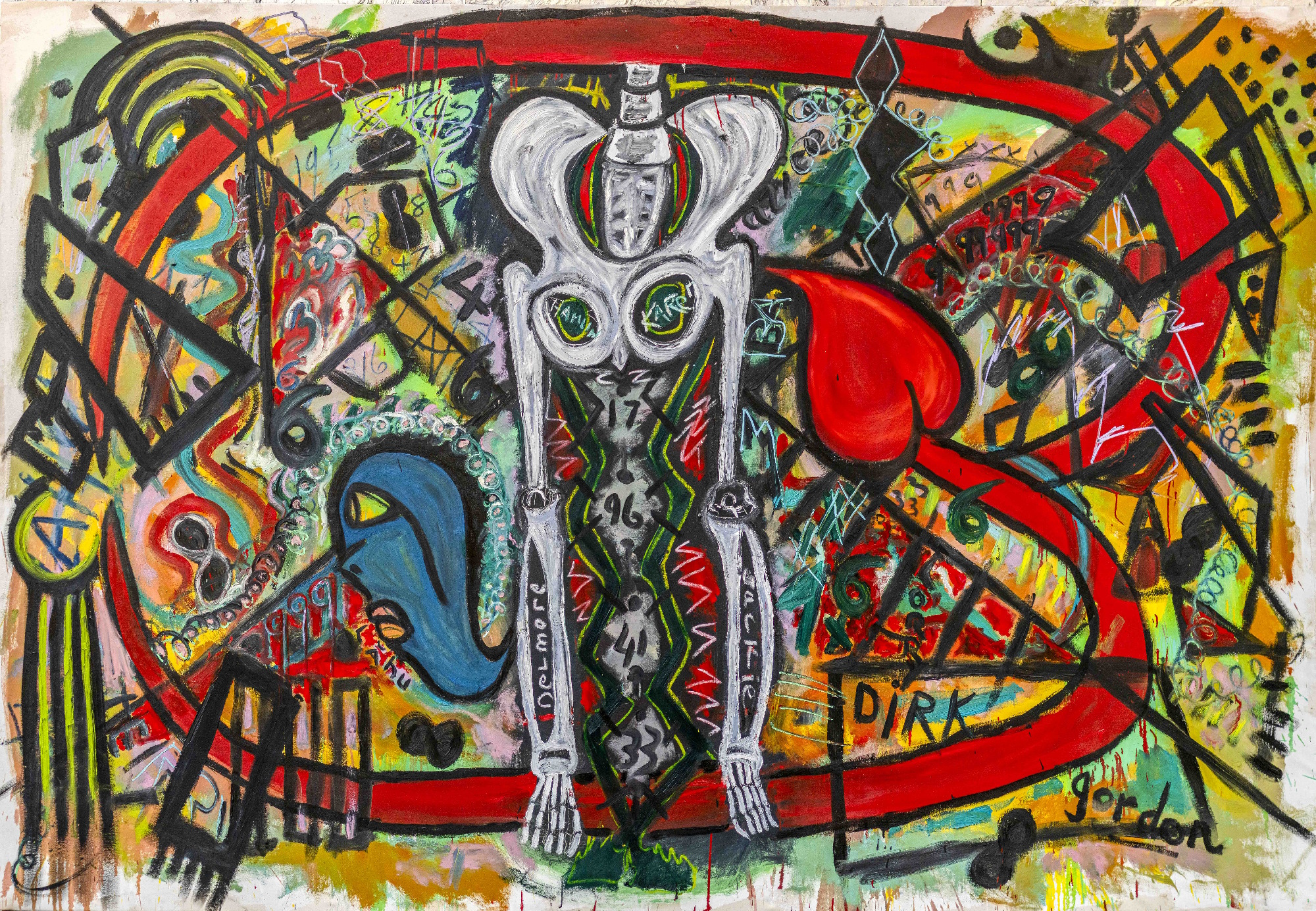
Jackie Boy Steps Out on Planet Earth (2023)
Oil
Frankly, I don’t know how to describe this work of the imagination. Jackie Boy is everyman born without consent onto an inexplicable planet floating somewhere in infinity. He’s bewildered but brave and a little unprepred. God love him.
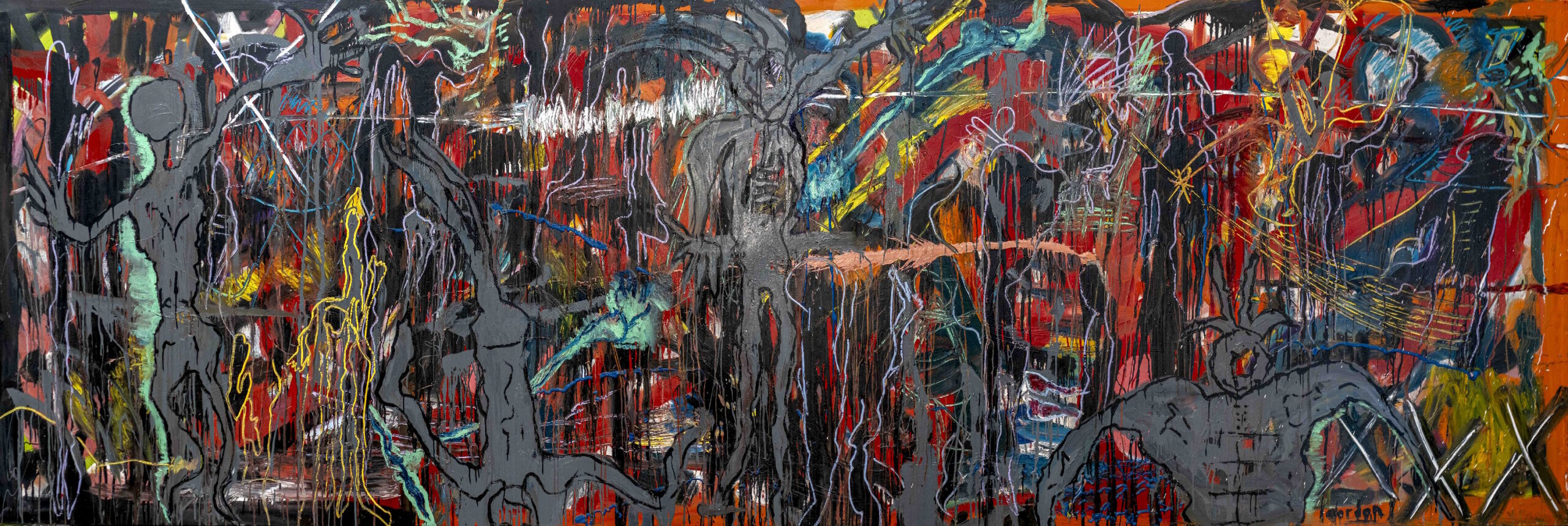
The Dancers (2024)
Oil
Ecstasy of life, wild joy, abandon, one response to life which heals the soul and gives us strength.
Curatorial Review
The Eternal Ache (2023) is a very chaotic abstract work in which oils are layered on top of each other. The claw marks in the top left corner create tension as though the painting has been scratched – perhaps as understanding that the work is related to anxiety; this could be that these scratches are invading the consciousness. The three ‘nervous’ nebulae, red, blue and black (or brown), explode through the canvas but are held back by the black swirling border. The red and black nebula seem to overwhelm the blue nebula, suggesting that thoughts, anxieties and trepidations surround the conscious.
The black border confines these emotions and locks them in; perhaps the claw marks are an attempt to break out of this- however, as much as the marks attempt- the border does not shift. Thus, it creates a sense of entrapment as the painting is confined to these anxieties and pains and cannot escape. Hence, the painting impounds itself onto the viewer and the viewer can directly translate these elements into impending anxiety, achieving this ‘catharsis’. This allows the viewer to immerse themselves in this anxiety and chaotic scene and reflect on their anxieties – which we all have….
Interview
Do you see your art as a continuation of the Abstract Expressionist movement or as something entirely new?
I intersect with Abstract Expressionism at the level of explosive incorporeal emotion. Insofar as theorists classify “movements” in art, the Abstract Expressionists collectively moved to reject externalities, perforce elevating amorphous human interiors to the pinnacle subject of their art. Emotion, motivation, fantasy, torment, joy the eye cannot see and, therefore, replicate with paint. Rage, for example, resembles no vase to be reproduced with meticulously intellectualized brush. An internal mist enshrouds the concept of desire toward shapeless ubiquity. Where are its boundaries? Where its edges? I continue Abstract Expressionism in my embrace of the unseeable. With each painting I deliver into the world–as did they–my own particularized deep-sea psychological denizens. I drag my subconscious upward like debris-trailing capsized ships. I paint images of lust, self-hatred, megalomania, conquest, and occasionally peace. I like to believe that I have taken Abstract Expressionism to its farthest reaches, into frigid inhospitable regions. My painting Two Monsters and their KDZ not only paints internal agitation but identifies that agitation’s origin in the form of two monstrously narcissistic parents. The Expressionists painted the agitation, but not the protagonists of their suffering. My best paintings continue Abstract Expressionism but strive to expose its deeper underpinnings.
What does it mean to you to be an ‘elemental man’ in the act of painting?
The elemental man tears off the mask of established society, the iron maiden of civilization, to plunge into fundamental animal needs: hunger, procreation, predation, possession…dominance over creation. The elemental man glories in the floor-messiness of mandatory survival. Swims naked through the blood-pool of primality, celebrates the fundamental elementalism of animal struggle. He does not paint the roasted pheasant; he paints the hunger. He does not paint courtship; he paints the procreative subterranean river of desire. He paints the universally shared intestines of primeval existence. Surfaces do not interest me. I am interested in the shortest distance between desire and contentment.
Do you ever revise or reconsider your work- or is every piece final upon completion?
The title of my painting One on Three refers to three “finished” paintings obliterated by the final one. The painting Bluebird Drowning was once a kicking donkey, three umbrellas, a black and red succubus, and a boy on a swing. I revisit most of my paintings, often destroying them entirely. I occasionally get stoned and fellated the evening after triumphantly completing a new “masterpiece”, only one year later, embarrassed and ashamed, to decimate it. Art is crucifixion and resurrection, ashes and Phoenix. I subscribe to Allen Ginsberg’s edict, “first thought, best thought”. But first thoughts—impulses—spontaneously voiced, often require refinements to appear fresh and raw.
Were there challenges when you transitioned from poetry to painting?
Not with fire but with fuel. I self-induced a haemorrhagic stroke when transitioning from verbal to visual. I desired natural perambulation but had to re-learn how to walk. In my fist I lofted a new paint tube into the air and announced savagely, “behold paint!” I snatched a square of stretched canvas from its slot and roared, “behold freedom!” I yanked a brush from its well and shrieked “within this dagger, mastery! Yet, like a fool who believes he’s king, clueless I sallied forth. But I stress that I abhor instruction, conformity, established rule, and tradition apropos art. I refuse intentional influence. I took up my cudgels and trialled and errored and trialled again, until over years I developed my own unique, and I hope effective, voice and style. Not much good comes from derivation; great art innovates. Great art elicits outrage, ridicule, even violence. Think Stravinsky, Duchamp, Cocteau, Pollock, Manet, Whitman, Joyce…Warhol. They grabbed art by its throat and slammed it to the ground. I am not of such cloth, but I believe the most visionary to be the most powerful forces.
How do you manage the scale of your paintings and what are the biggest challenges of working in such a large scale?
Three barnacled lobster boats tie up against my four-thousand square foot studio built on ancient piers over the Gloucester, Massachusetts, working harbor. It’s ceiling soars thirty feet. I’m fortunate and honored. I am currently working on a painting 10’ x 20’ in size. I purchase 50-yard rolls of twelve foot wide #10 unprimed cotton duck and rip it to the size required. I staple it to the wall–a blank movie screen. Small canvases cannot contain the acreage of my emotion. Hundreds of unidentifiable half-used paint tubes, along with clutters of new tubes, litter the dangerously paint-caked plywood floor. An inspiration yanks me from my rocker; I make my initial brushstroke from which a painting suddenly avalanches. I mount and demount oil-slimy ladders. I am alternately splayed on the floor or five rungs up. I am paint-coated and urine-stained by my septuagenarian bladder. I am wallowing slippery mess. Large canvases demand large liquid-saturated brushes to muddy. I do not always apply primer because I know I will slather paint over paint. I often paint two entirely different visions atop each other creating conflict and enjambment. The thing swallows me in size and adversity. It equally swallows the viewer. I dance cataleptically. I swim chocking water. Nothing approaches smoothness. The painting paints me until, perhaps days later, I begin to paint it. The direction of flow reverses. Finally, I am in control. Vaguely, I see emerging outlines of two figures lying horizontally atop each other, both dead (The End of a Great Marriage), and now with conceived purpose, paint in bones, femurs, skulls, eyeholes, tarsals. I title the work while painting it. Named thusly, it evolves into “something”. I am always of an emerging story; it will not long remain riot. Calisthenics comprise my biggest challenge. It’s physical work to paint this size, and I am experiencing advancing entropy.
You mention that your paintings “seize and stop viewers in their tracks.” What reactions have stood out to you the most from viewers?
The compliments “wonderful”, “beautiful”, “really cool” or “nice” fail to gratify. A woman cried tears before The Wall They Clawed, another woman for fifteen minutes danced erotically before Leviathan. “It’s alive!” is the highest compliment I have ever received.
Is there an emotion or human experience you’ve yet to explore witihin your paintings but want to?
Yes, sheer happiness.
In Two Monsters and their KDZ (2024) you tackle child abuse and narcissistic parenting- how did this subject emerge in your work?
I never paint what I have not experienced first-hand. I paint heartbreak; I have been married five times. I paint body-dysmorphic disfunction; it tortures me. I paint rage; rage visits me. I paint abusive narcissistic parents; I withstood sadistic monsters. In the painting mentioned, my older sister and I are the KDZ and our parents the monsters. I do not believe an abstract artist can convincingly paint what he or she has not deeply experienced, examined, digested, and internalized. Painting the unseeable requires a ruthlessly omniscient exploration of psyche.
Antimatter infused the original abstract expressionist masterpieces. Rothko painted portraits as color fields. Newman reduced the physical world into vertical light sabers. Pollock’s drip paintings revoked all foundational visual security. Krasner reshaped life into dense packs of indefinable shapes. All to say, in doubtless oversimplification, that I believe idea rather than emotion to be the heart-muscle of Abstract Expressionism. Yes, they enriched their paintings with self, but not necessarily with self-knowledge. They did not directly connect their work with personal incident such as dissolution of marriage, death of a sister, victimization by bigotry or antisemitism, poverty’s scars, or the guilt of adultery.
I have attempted in my work to attach personal experience to abstraction, to transfer the deepest feeling of authentically lived life onto canvas. I often fail.
You describe painting like an “improvisational dancer”. Can you explain more on how movement influences your technique?
The canvas is music with whom, wildly, I bugaloo. I shake booty. I twist and shout. I do the hurdy-gurdy. I swing paintbrush-wielding arms into marvelous arcs. I whirl and twist paint-bearing hips. I swing under the canvas, like an exuberant dwarf. I shoot paint onto canvas from my pulsing urethra. I fire paintballs from my knee-canons. I answer my partners undulations with fancy gyrations. I do not know steps. I dance the improv. I paint with my whole body in fits of pure joy.
You mention having over 300 paintings in your studio. How do you feel about them when they’re waiting to be seen and how do you decide which works to show publicly?
I suffer for them. I want my beloved babies to fly, to soar, to make bracing friends, to tittle and cry, to run to the fullest life’s tragicomical, bounteous race. I have scant opportunity to exhibit my work so am never tasked with painful decisions. But I open my arms to anyone who would like to visit my studio.
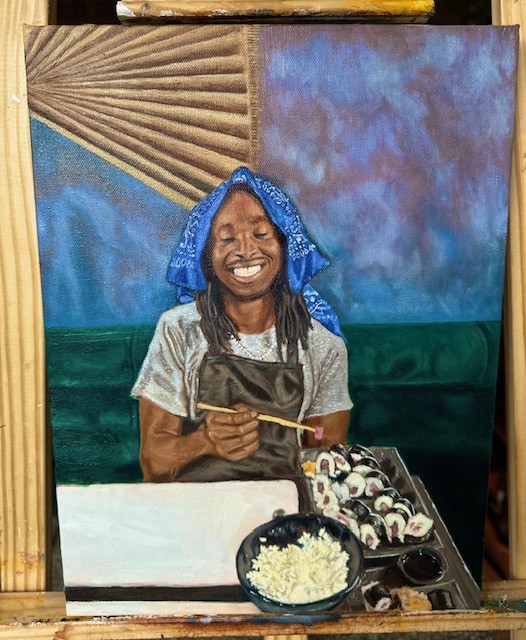
BUZZAWE
Artworks

Beyond the Blue
Painting
In Beyond the Blue, Buzzawe challenges the conventional portrayals of Black men in art and media which often emphasise; strength, aggression, or stoicism. Instead, this painting captures a moment of warmth, joy and vulnerability, offering a perspective that is often overlooked. The subject exists in a state of peaceful introspection free from societal expectations, embracing his full emotional depth. His presence in this scene serves as a quiet yet powerful resistance to limiting narratives, celebrating individuality and the richness of human experience. Through this work, Buzzawe invites viewers to reconsider and expand their perception, recognising the beauty in complexity and the freedom of self-expression.
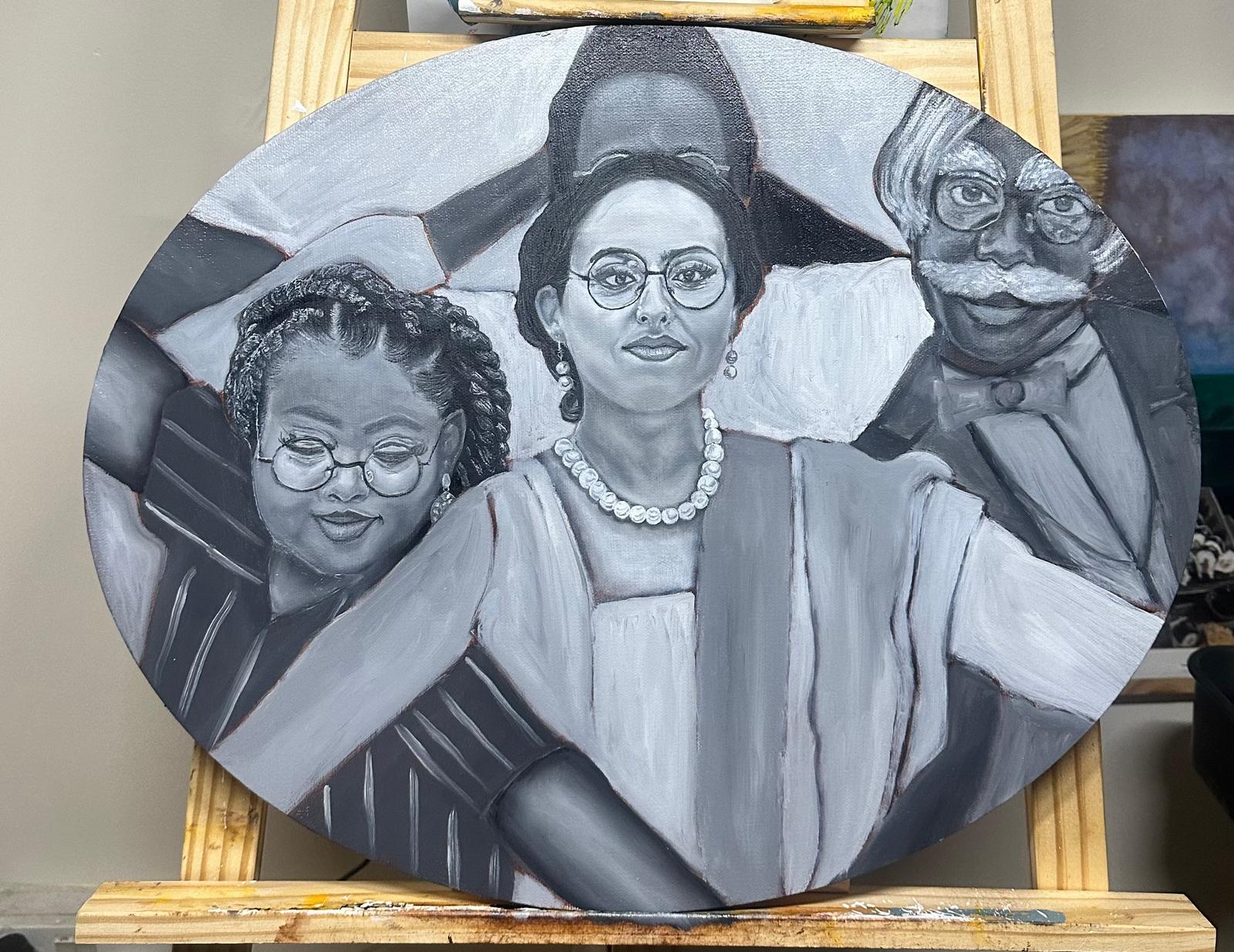
Threads of Heritage
Painting
Threads of Heritage is a meditation on the invisible bonds that connect individuals across generations. Each figure in the piece represents a distinct yet interconnected thread of ancestry, culture, and shared human experience. Together, they embody a collective identity—watching over, protecting, and guiding one another. The circular composition reflects the cyclical nature of life. Reminding us that heritage is not merely a relic of the past, but an ever-present force shaping the present and inspiring the future. This piece invites viewers to reflect on their own place within the fabric of history and to consider the role they play in preserving and evolving cultural narratives.
Curatorial Review
Beyond the Blue presents a more intimate moment of joy, challenging the narrative surrounding black men in contemporary art and media. Instead of being set in a stereotypical environment of strength, aggression or stoicism – the figure is depicted within a more peaceful and warm moment. The composition of the painting helps to add to this warm environment; the background is muted and thus takes the viewer’s eyes towards the subject, who is smiling, and the lighting and shadows of the work are soft, which creates a peaceful atmosphere…
